

EntreCulturas 2
Communicate, Explore, and Connect Across Cultures
Catherine Schwenkler Megan Cory Paulina CarriónLa mola misteriosa
Ann Macari Healey
Copyright © 2023 by Wayside Publishing
All rights reserved. No part of this publication may be reproduced, stored in a retrieval system, or transmitted in any form or by any means, electronic, mechanical, photocopying, recording, or otherwise, without the prior written permission of the publisher.
The marks [EntreCulturas, EntreCultures, Explorer, FlexText, Learning Site, Wayside Publishing] (collectively “the Marks”) are registered in the U.S. Patent and Trademark Office and owned in their entirety by Wayside Publishing (“Wayside”). Any use of the Marks without the express written permission of Wayside is prohibited.
LOS PAÍSES HISPANOHABLANTES
EntreCulturas 2: Glosario de instrucciones de clase y actividades
The following expressions will help you understand instructions in class and carry out activities with your classmates.
verbos anota - anoten takenotes añade - añadan add clasifica - clasifiquen classify comunica - comuniquen communicate compara - comparen compare comparte - compartan share contesta - contesten answer conversa – conversen talk dibuja - dibujen draw diseña - diseñen design elige - elijan choose empareja - emparejen match escribe - escriban write escucha - escuchen listen fíjate – fíjense notice graba - graben record(yourvoice) habla - hablen speak
haz(le) – hágan(les) askhim/her/them preguntas questions justifica - justifiquen justify lee - lean read menciona - mencionen mention mira - miren look no olvides – no olviden don’tforget piensa – piensen think pregunta – pregunten ask prepárate – prepárense prepare recomienda – recomienden recommend recuerda – recuerden remember sigue - sigan follow selecciona – seleccionen select visita - visiten goto toma apuntes - takenotes tomen apuntes túrnense



taketurns


Sustantivos con un compañero withaclassmate las conexiones connections el diagrama de Venn Venndiagram los dibujos thedrawings el modelo themodel/example el organizador gráfico thegraphicorganizer la guía digital Explorer las oraciones sentences el papel de theroleof
Otras palabras y expresiones útiles al mirar whenwatching antes/después de mirar before/afterwatching mientras miras whileyouwatch mientras ves whileyousee por lo menos atleast por primera vez, forthefirsttime, segunda vez secondtime siguientes (the)following
Palabras interrogativas
¿Cómo? How?
¿Cuáles? Which/What? ¿Cuándo? When? ¿Cuánto/a? Howmuch?

Howmany? ¿Dónde? Where? ¿Qué? What/Which?
¿Quiénes? Who?
Buenos Aires, Argentina




Acknowledgements

We extend our sincere gratitude and appreciation to all who accompanied us on our journey from the conception to completion of the EntreCulturas program. We had the privilege to work with a committed, talented, and dependable professional team that served as our anchor throughout the development process.










Eliz Tchakarian, Senior Editor, and Janet Parker, Curriculum Development Coordinator, were dedicated partners who coached us every step of the journey and consistently helped us pull the pieces together for production. Megan McDonald, Lourdes Cuellar (editors and behind-the-scenes writers for the programs) and Kelsey Hare (permissions consultant) were instrumental and persistent with acquiring permissions for the authentic materials. We commend our outstanding editors, María Solernou, Ana Martínez Álvarez, and María Matilla whose advice and editing were indispensable to the completion of the series. Our series would not have been as truly authentic nor as interesting without the generous contribution of our international video bloggers, young people from across the Spanishspeaking world; thank you for sharing your lives with our readers!
We thank Anthony Saizon for the thoughtful design. Derrick Alderman and Rivka Levin, our talented and artistic production team, brought the manuscripts to life on the engaging and colorful pages of the final product. We thank Wayside Publishing Assistant Editors Nathan Galvez, Shelby Newsted, Sawyer McCarron, and Rachel Ross, who designed many of the beautiful graphics and graphic organizers used in the series in print and online.
The Wayside Publishing marketing team was led by manager Michelle Sherwood, who was assisted by Nicole Lyons. In collaboration with the Wayside Publishing Sales team, they successfully got the word out to Spanish teachers about EntreCulturas , a new instructional tool and innovative approach to developing students’ intercultural communicative competence.
This project was possible due to the leadership, vision, and wisdom of Wayside Publishing president, Greg Greuel, who believed in us to get the job done!


 Catherine Schwenkler, Megan Cory, and Paulina Carrión
Manzanillo, Costa Rica
Catherine Schwenkler, Megan Cory, and Paulina Carrión
Manzanillo, Costa Rica
WORLD-READINESS STANDARDS FOR LEARNING LANGUAGES
World-Readiness Standards For Learning Languages
GOAL AREAS STANDARDS
GOAL AREAS STANDARDS
C OMMUNICATION
Communicate effectively in more than one language in order to function in a variety of situations and for multiple purposes
COMMUNICATION
Interpersonal Communication:
Learners interact and negotiate meaning in spoken, signed, or written conversations to share information, reactions, feelings, and opinions.
Communicate e ectively in more than one language in order to function in a variety of situations and for multiple purposes
C ULTURES
Interact with cultural competence and understanding
CULTURES
C ONNECTIONS
Connect with other disciplines and acquire information and diverse perspectives in order to use the language to function in academic and careerrelated situations
Interpersonal Communication:
Interpretive Communication:
Learners understand, interpret, and analyze what is heard, read, or viewed on a variety of topics.
Presentational Communication:
Interpretive Communication:
Presentational
Relating Cultural Practices to Perspectives:
Learners interact and negotiate meaning in spoken, signed, or written conversations to share information, reactions, feelings, and opinions.
Learners use the language to investigate, explain, and reflect on the relationship between the practices and perspectives of the cultures studied.
Interact with cultural competence and understanding
Making Connections:
Learners present information, concepts, and ideas to inform, explain, persuade, and narrate on a variety of topics using appropriate media and adapt ing to various audiences of listeners, readers, or viewers.
Learners understand, interpret, and analyze what is heard, read, or viewed on a variety of topics.
Relating Cultural Products to Perspectives:
Learners use the language to investigate, explain, and reflect on the relationship between the products and perspectives of the cultures studied.
Relating Cultural Practices to Perspectives:
Learners use the language to investigate, explain, and reflect on the relationship between the practices and perspectives of the cultures studied.
Learners build, reinforce, and expand their knowledge of other disciplines while using the language to develop critical thinking and to solve problems creatively.
CONNECTIONS
C OMPARISONS
Develop insight into the nature of language and culture in order to interact with cultural competence
Connect with other disciplines and acquire information and diverse perspectives in order to use the language to function in academic and career-related situations
C OMMUNITIES
Communicate and interact with cultural competence in order to participate in multilingual communities at home and around the world
Acquiring Information and Diverse Perspectives:
Communication:
Learners present information, concepts, and ideas to inform, explain, persuade, and narrate on a variety of topics using appropriate media and adapting to various audiences of listeners, readers, or viewers.
Relating Cultural Products to Perspectives:
Learners use the language to investigate, explain, and reflect on the relationship between the products and perspectives of the cultures studied.
Learners access and evaluate information and diverse perspectives that are available through the language and its cultures.
Making Connections:
Language Comparisons:
Learners use the language to investigate, explain, and reflect on the nature of language through comparisons of the language studied and their own.
Learners build, reinforce, and expand their knowledge of other disciplines while using the language to develop critical thinking and to solve problems creatively.
Cultural Comparisons:
Acquiring Information and Diverse Perspectives:
Learners use the language to investigate, explain, and reflect on the concept of culture through comparisons of the cultures studied and their own.
Learners access and evaluate information and diverse perspectives that are available through the language and its cultures.
School and Global Communities:
COMPARISONS
Develop insight into the nature of language and culture in order to interact with cultural competence
Learners use the language both within and beyond the classroom to interact and collaborate in their community and the globalized world.
Language Comparisons:
Lifelong Learning:
Learners use the language to investigate, explain, and reflect on the nature of language through comparisons of the language studied and their own.
COMMUNITIES
Communicate and interact with cultural competence in order to participate in multilingual communities at home and around the world
Cultural Comparisons:
Learners set goals and reflect on their progress in using languages for enjoyment, enrichment, and advancement.
Learners use the language to investigate, explain, and reflect on the concept of culture through comparisons of the cultures studied and their own.
School and Global Communities:
Learners use the language both within and beyond the classroom to interact and collaborate in their community and the globalized world.
Lifelong Learning:
Learners set goals and reflect on their progress in using languages for enjoyment, enrichment, and advancement.
Essential Features
Learners maintain an online Mi portafolio to self-assess, reflect, and upload evidence for each Can-do statement displayed alongside activities in the Student Edition. Building their collections of artifacts allows learners to form vital habits leading them to efficiently continue learning beyond the classroom.




SELFASSESSMENT


TYINTERCUL
CRE U L T U
With EntreCulturas, learners explore and compare Spanishspeaking communities to their own communities. Video blogs created by native speakers allow learners to compare their lives with those of their peers. Activities and assessments are based on authentic sources and set in reallife thematic and cultural contexts.
AUTHENTICITY
Interculturality is at the heart of EntreCulturas



YTILARUTL
LTURALI
PERFORMANCEBASED ASSESSMENT















NTER

Our vision is a world where language learning takes place through the lens of interculturality, so learners can discover appropriate ways to interact with others whose perspectives may be different from their own.
LUCRETNIYTIL
Units include performance-based formative assessments, En camino, which solidify culturally appropriate communication skills relating to learners’ communities. Vive entre culturas, summative integrated performance assessments, engage learners in global intercultural contexts. Analytic rubrics that include intercultural and communicative learning targets accompany summative assessments.
RESOURCES FOR TEACHERS AND STUDENTS

The online Explorer provides all audio/video resources; scaffolding for Student Edition activities; vocabulary and grammar reinforcement, including flipped classroom videos; additional activities; formative and summative assessments; rubrics; and other teacher resources.
APPENDICES





In the Teacher Edition, you are provided audio and audiovisual transcripts, answer keys, instructional strategies, Can-do statements for each unit, and rubrics. Indices include a Grammar and Learning Strategies Videos Index as well as a Grammar Index. Glossaries are in the Student Edition.

EntreCulturas
Mission and Vision

EntreCulturas is a three-level, standards-based, thematically-organized program consisting of 19 in-depth units that provide learners with opportunities to interact and engage with authentic materials and adolescent speakers of the language. By learning in an intercultural context, students acquire communication skills and content knowledge while exploring the products, practices, and perspectives of Spanish-speaking cultures.
EntreCulturas Mission
EntreCulturas aims to prepare learners to communicate, explore, and connect across cultures in order to foster attitudes of mutual understanding and respect.

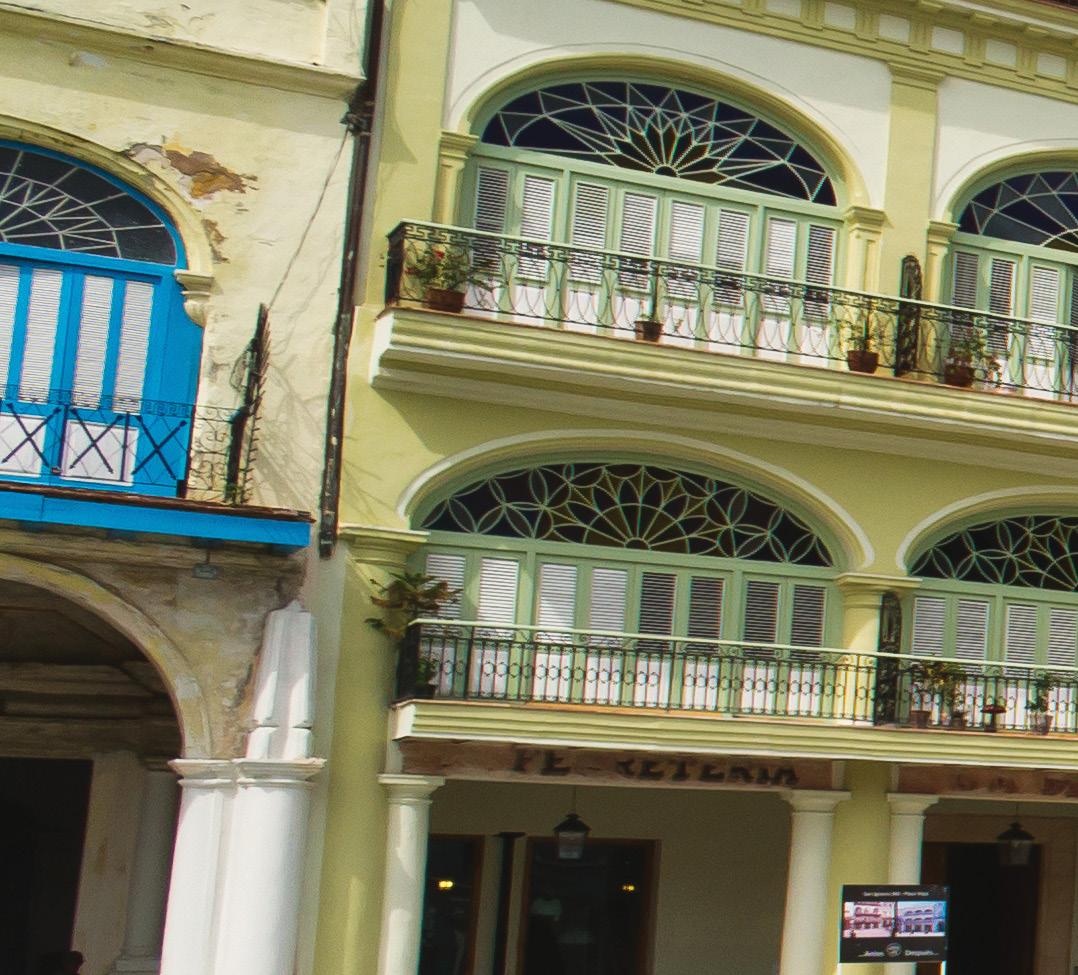


EntreCulturas Vision
Our vision is a world where language learning takes place through the lens of interculturality, so students can discover appropriate ways to interact with others whose perspectives may be different from their own.
Dear students, Welcome to EntreCulturas !
In today’s world, we all live entre culturas : That is, we live around and among people and influences from a variety of cultures. As we live, learn, work, and play in our communities and abroad, we interact in person and online with people whose experiences and perspectives may be different from our own.



The learning materials in the EntreCulturas program were designed to help you communicate in Spanish, and to develop the attitudes and habits of mind to interact appropriately with Spanish speakers, respecting differences and recognizing the many things we share as human beings.
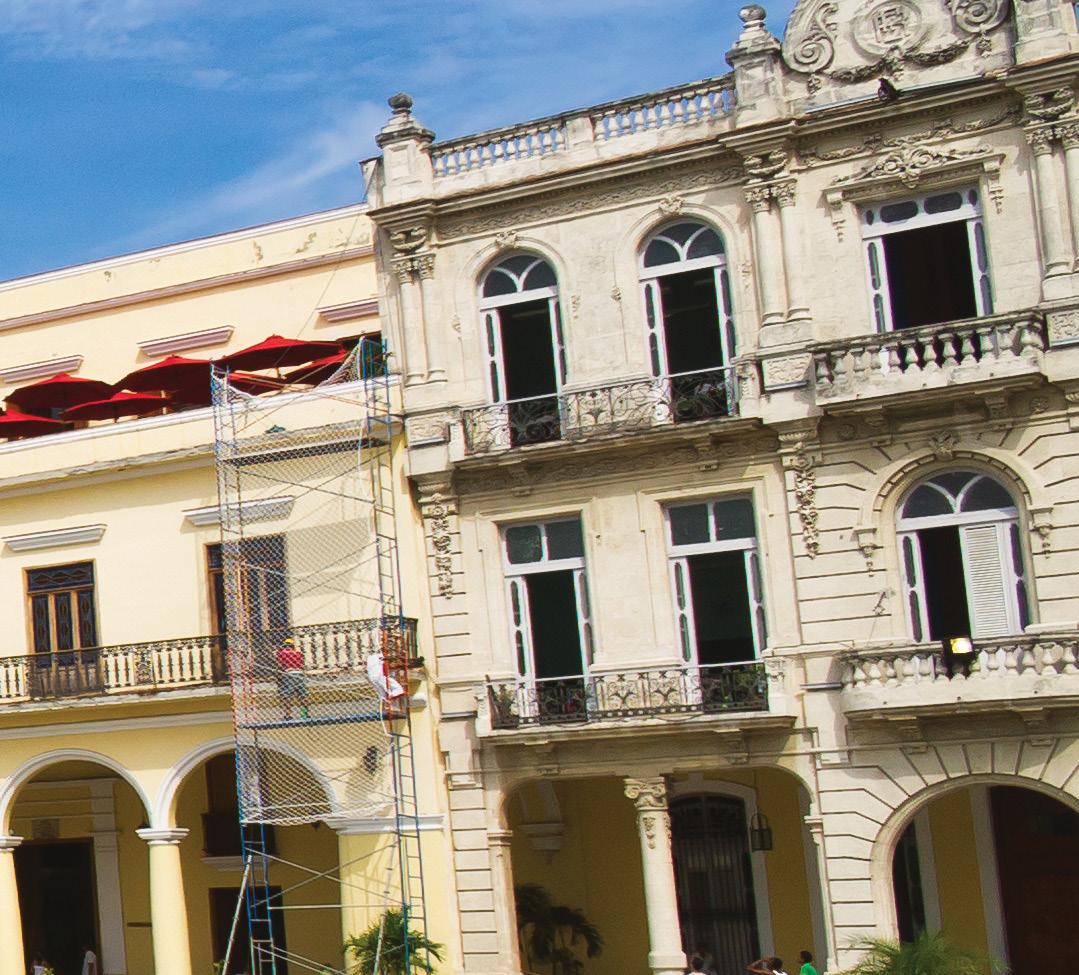
Thank you for the commitment you have made to learning another language. The opportunity to experience interactions across cultures and connect with diverse people in our communities and around the world has brought each of us great personal and professional satisfaction. We hope that through this program you too will embrace the opportunities that will come to you as you live entre culturas .
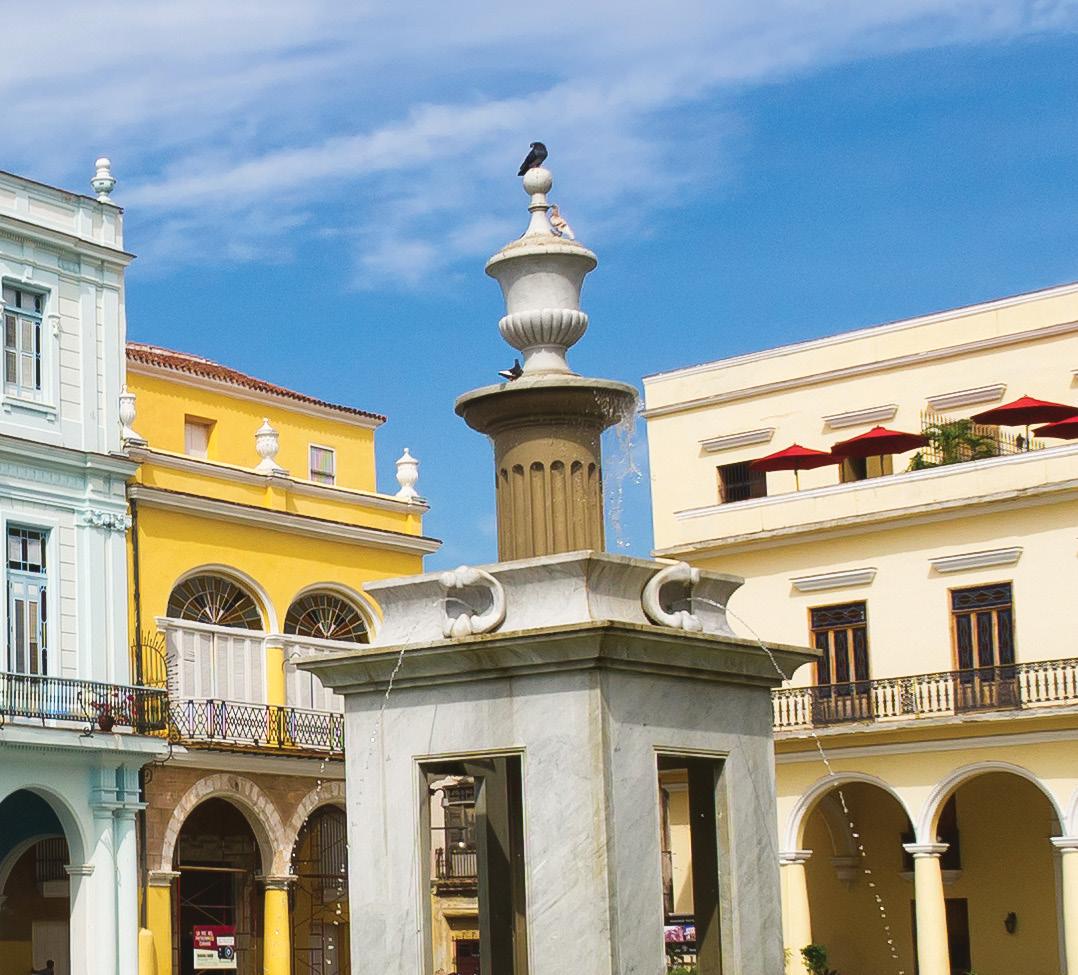 Sincerely,
Catherine Schwenkler, Megan Cory, and Paulina Carrión
Havana, Cuba
Sincerely,
Catherine Schwenkler, Megan Cory, and Paulina Carrión
Havana, Cuba
Estructura de la unidad
EntreCulturas 2
Introducción
Unit theme
Unit goals
Essential questions
Recursos de video Video blogs Observa
Enfoque en la forma Estrategias
Encuentro intercultural
¿Te acuerdas?
Comunica y Explora A & B
Así se dice Además se dice Expresiones útiles ¿Te acuerdas?
Observa
Detalle gramatical Recuerda
Otros elementos de la unidad Estrategias
Enfoque cultural Conexiones
Reflexión intercultural Mi progreso comunicativo Mi progreso intercultural
En camino A & B: Formative assessment
Síntesis de gramática A & B
Vocabulario A & B
Vive entre culturas: Integrated performance assessment

Al empezar
EXPLORER
EntreCulturas 2 Explorer resources include video blogs, audio/video authentic resources, vocabulary PowerPoints, grammar and learning strategies videos, additional vocabulary practice, discussion forums, and more. You will collect evidence of your growth in Mi Portafolio in Explorer, as well.





COMUNICA Y EXPLORA A
Introduce the topic via the cultural context of the featured country.
ESSENTIAL QUESTIONS




Connect day-to-day learning to bigger questions.
Preguntas esenciales
What helps students engage in their school community?
What factors support student learning and success?

How do schools in different cultural contexts meet the needs of their students?
Encuentro intercultural 4
Meet David, a teenager from Quito, Ecuador, who will tell you about his school, classes, and teachers.
¿Te acuerdas? 6


Let’s see what you remember about places in the school, school materials, and how to describe things in a classroom.
Comunica y Explora A: La estructura de la escuela 14


What do schools provide to their students to encourage learning and to get students involved in the school community? Describe and compare your schedule, classes, teachers, and activities.
Sintesis de gramática y vocabulario 35 Learn to make comparisons of similarities and differences while describing your teachers, classes, and schedules.

Comunica y Explora B: Un ambiente escolar que facilita el éxito académico 36
What factors contribute to a positive school atmosphere and promote student learning and success? Describe how students and teachers contribute to a learning environment, explain school norms, and offer advice to a peer about how to be successful in school.


Síntesis de gramática y vocabulario 53
Learn to express obligation (hay que y tener que) in the context of what you have to do to be successful in school.

Vive entre culturas: Una escuela ideal 56
What does an ideal school look like? Design an ideal school focusing on the various factors within a school that contribute to student learning and success.
3
UNIT GOALS


Review learning targets for interpretive, interpersonal, and presentational communication and intercultural learning.
COMUNICA Y EXPLORA B
Engage in higher level analysis through the authentic cultural materials, which will enrich your knowledge of the culture of the featured country.
VIVE ENTRE CULTURAS
Apply what you have learned in the final assessment.
EcuadorAcuerda, Comunica y Explora
UNIDAD 1 | ¿Te acuerdas?
A ver qué recuerdas para describir la escuela Actividad 1
¿Qué hay en tu mochila o casillero?
Paso 1: Escuchar
Escucha a Yarima mientras ella describe cómo usa los materiales escolares en su mochila. Escribe la letra que identifica el material escolar con la descripción.

Paso 2: Escribir
a. Toma una foto o crea una ilustración de todos los útiles (materiales) escolares que siempre llevas en tu mochila o que tienes en tu casillero.


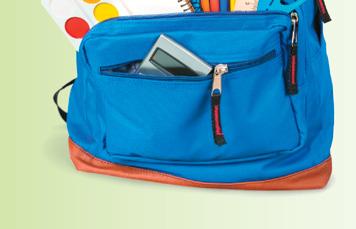
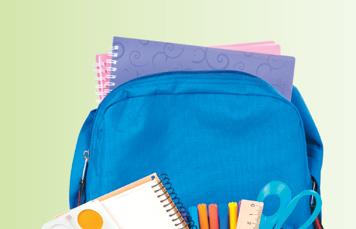
b. Identifica todos los útiles.
c. Escribe una descripción de cada uno.
Modelo
Hay un bolígrafo anaranjado en mi mochila porque me gusta escribir con mi color favorito.
MI PROGRESO
COMUNICATIVO
provide
of

¿TE ACUERDAS?
Provides review activities to activate your background knowledge.



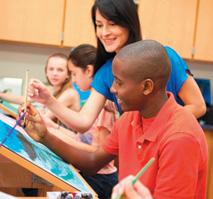









ACTIVIDAD
Activities are framed around all types of communication.

THE COMPASS ICON INDICATES ADDITIONAL SUPPORT ON EXPLORER.






UNIDAD 1 | Comunica y Explora A
Paso 3: Colaborar y compartir Con un/a compañero/a piensen en una solución creativa para ayudar a las escuelas que no tienen una biblioteca. Escriban al menos dos ideas y compartan con la clase.
Actividad 7
¿Quién trabaja en un colegio?
Paso 1: Escuchar y escribir Escucha las descripciones de varias personas que trabajan en un colegio. Escribe el vocabulario que corresponde con cada descripción

Paso 2: ¿Cierto o Falso?
a. Escucha las oraciones sobre tus profesores o sobre el personal que trabaja
¿TE ACUERDAS?
Reminds you of vocabulary needed for communication that you have learned prior to this unit.

ASÍ SE DICE
Essential vocabulary presented visually in manageable chunks and authentic contexts.



POWERPOINTS IN EXPLORER PROVIDE VISUALS CLARIFYING MEANING WITHOUT TRANSLATION.










EXPRESIONES


ÚTILES
These quick reminders show how expressions can boost your communication skills, often with phrases that will work across other themes.



ADEMÁS SE DICE
Additional vocabulary for personalization, extension, and variation of skills.

Estrategias
ESTRATEGIAS
SIDEBAR




Learning Strategies videos are found in Explorer with brief explanations throughout the book.




VOCABULARIO









These lists summarize the vocabulary you studied in the unit.

FIND MORE PRACTICE IN CONTEXT IN EXPLORER.

Gramática: Observa y Enfoque en la forma

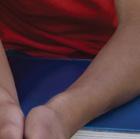





UNIDAD 1









Comunica y Explora A
OBSERVA





Examples of new structures in context develop your skill as a "grammar detective"
YOU WILL FIND HELPFUL

VIDEOS CALLED OBSERVA AND ENFOQUE EN LA FORMA IN EXPLORER.















RECUERDA
Review previously learned grammar concepts that you are expected to use for communication in the activities.



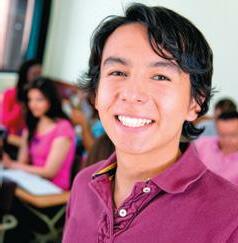










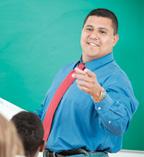









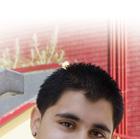
DETALLE GRAMATICAL












Just-in-time grammar details will help you communicate.

Use



Modelo











SÍNTESIS DE GRAMÁTICA
The summary contains helpful explanations of grammatical structures.


FIND MORE PRACTICE IN CONTEXT IN EXPLORER.

Evaluaciones: En camino y Vive entre culturas
De vuelta a clases | UNIDAD 1
Paso 2B: Mirar por segunda vez y anotar
Al mirar el video por segunda vez: a. Enfócate en la importancia de las actividades extracurriculares. b. Completa la segunda columna del organizador gráfico.
Paso 2C: Conversar






Con un/a compañero/a, compartan sus listas e ideas. Después conversen sobre las siguientes preguntas:

• ¿Qué actividades extracurriculares son más costosas para un colegio? ¿Cuáles son más baratas (cuestan menos)?






¿Piensas que todos los colegios deben ofrecer muchas actividades como el Colegio Montfort? ¿Por qué?
¡Prepárate!
Los colegios necesitan ayudar a sus estudiantes considerando los lugares donde viven y sus necesidades. Participa en el foro digital contestando estas preguntas:





• Piensa en las actividades extracurriculares de tu colegio. ¿Cómo preparan a los estudiantes para su futuro?
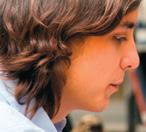
• En tu opinión, ¿cuáles son las actividades extracurriculares que debe ofrecer una escuela ideal?






¡PREPÁRATE!
Look

UNIDAD 1 | Vive entre culturas
Sugerencias para escribir: En mi escuela ideal, hay…








VIVE ENTRE CULTURAS
A















SUPPORTING MATERIALS IN EXPLORER.



can
can give
Vive entre culturas
Una escuela ideal
Pregunta esencial: How do schools in different cultural contexts meet the needs of their students?





A large technology company has decided to invest in education by opening new schools throughout North and South America. The company’s goal is to create schools that meet the specific needs of the communities they will serve. They are very inspired by the bilingual schools that have been designed and built in recent years in Ecuador.


They have asked students throughout the Americas to participate in a contest to design an ideal school. First, students should observe Sumak Yachana Huasi, a bilingual school in Cotacachi, Ecuador. Based on this model, they should design an ideal school focusing on two big ideas:
• How does the culture of a particular community present unique needs for a school?
• What are some key elements that are essential to a successful school, anywhere?
Interpretive Assessment
Paso 1: Mirar y anotar
Watch the video about the bilingual school, Sumak Yachana Huasi, in Ecuador.
a. Note what unit vocabulary you hear or see in the video.
b. Complete statements about this school to show what you understood.
En camino B
Cómo tener éxito en tu escuela
You have been paired with a student and his/her family from Ecuador. This exchange student will be arriving at your school soon for an exchange program, and he/she needs to be prepared. The student and their family need to know how the evaluation system works in your school, what the rules and the environment are like at your school, as well as how to be successful.
Paso 1: Escuchar y tomar apuntes
Listen to David as he describes his school. Take notes as he talks about his grades, the school environment and rules.
Paso 2: Leer y escribir


Read an email from one of the students from Ecuador. Reply to the questions in his email about how to be successful in your school.


Paso 3: Presentar tu colegio
Prepare a one-page pamphlet with images that you can send to the new student and his/her family, so they know how to be successful in your school.
• What do students need to do in your school to get good grades? What are the rules that students must follow in school?


• What kind of environment is there in different classes at your school? What should students do to contribute to a positive class environment?
EN CAMINO
Formative assessments measure your progress towards unit goals.
FIND SUPPORTING MATERIALS IN EXPLORER.
Interpersonal Assessment



in
for
and
from your




by
in your
See

Presentational Assessment
Paso
Interculturalidad/Interculturality



UNIDAD 1 | Encuentro intercultural
Encuentro intercultural
David vive en Quito, Ecuador. Tiene 15 años y está en el grado 11 en el Colegio José Engling. Tiene dos hermanos menores, Daniel y Andrés. También tiene una hermana mayor que se llama Ana Francisca. A David le gusta jugar con su perro, tocar la guitarra y cantar con su familia.

David describe su colegio en una conversación con una amiga, Paulina. El colegio de David es un colegio mixto (co-ed) y católico, que va desde pre-kinder hasta duodécimo grado.
Información sobre Ecuador



Ecuador es un país pequeño en Sudamérica. Está entre Colombia y Perú y es uno de los países con más biodiversidad en el continente americano. Puedes visitar montañas y volcanes activos en los Andes. También puedes conocer la selva amazónica y playas hermosas en el océano Pacífico. La capital del Ecuador es Quito y el puerto (port) principal es Guayaquil.
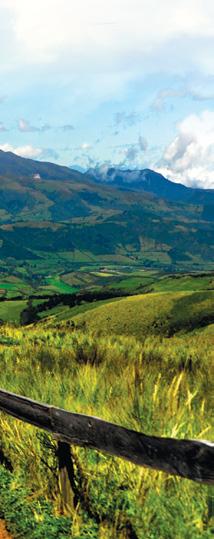


ENCUENTRO INTERCULTURAL
Available on Explorer only, these authentic videos from Spanish-speaking teens invite you to share their world.
ENFOQUE CULTURAL
Knowing about cultural products, practices, and perspectives lays a foundation for intercultural reflections.
SHARE YOUR REFLECTIONS IN THE EXPLORER DISCUSSION FORUM.




Enfoque cultural
Producto cultural: Escuelas bilingües en Ecuador
REFLEXIÓN INTERCULTURAL
After a variety of experiences with cultural products, practices, and perspectives, you will reflect on your growing intercultural awareness.
SHARE REFLECTIONS IN THE EXPLORER DISCUSSION FORUM.




MI PROGRESO INTERCULTURAL
This unique self-assessment feature clarifies intercultural goals.


Conexiones
What do you think are the bene ts of a bilingual education?
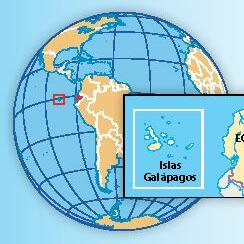
Además se dice indígenas - indigenous (native to a region) rechazados - rejected vestimenta - clothes idioma natal - native language mestizos - someone of indigenous and European heritage quichua - one of the indigenous languages spoken in Ecuador Paso 2B: Ver y comprender


a. Lee las siguientes oraciones y escribe si el hecho es cierto (C) o falso (F).
b. Si la información subrayada con línea es falsa, escribe la información correcta.
1. Los indígenas se sentían orgullosos (proud) de su vestimenta en sus otras escuelas.
2. El idioma natal de los estudiantes indígenas es el español
3. Todos los estudiantes en el colegio Sumak Yachana Huasi toman clases en quichua
4. El ambiente en esta escuela es más inclusivo que otras escuelas que no son bilingües.

Reflexión intercultural


1. Have you ever attended a school that provided all instruction in a language other than your mother tongue? If yes, describe what that was/is like. If not, take a few moments to reflect on what it might be like to learn science, math or history in a second language.

2. Do you think that bilingual schools in Ecuador, like Sumak Yachana Huasi, are improving educational opportunities for all students by conducting classes in the different languages spoken throughout the country instead of solely in Spanish?
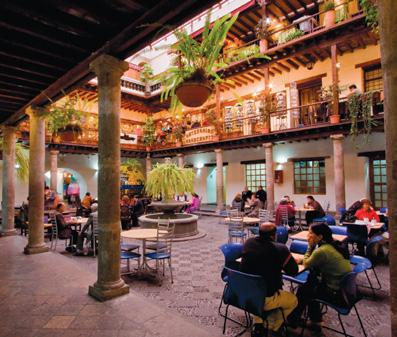

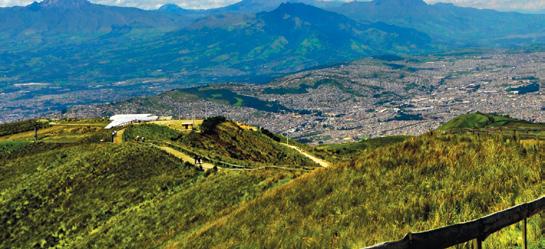
3. How might teaching all students quichua create a more positive learning environment for the indigenous students?
4. How is this bilingual school meeting the needs of the students in the community it serves?
I can recognize how bilingual education in Ecuador is improving learning opportunities for indigenous students.
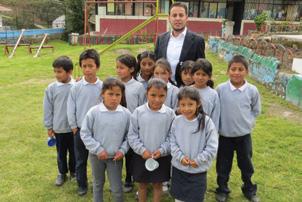
Explorer/Guía digital
The online Explorer is the other half of your textbook, connecting you with language learning resources that inspire continued exploration.
Whether learning about Ecuador through David’s video blog, studying grammar through flipped classroom videos, or updating your language learning portfolios with new achievements, you can practice all modes of communication at your own pace and within your own comfort zone.
PERSONAL PORTFOLIOS ENHANCE SELF-ASSESSMENT










VIDEO BLOGS FROM NATIVE SPEAKERS



FlexText®












FlexText is Wayside’s unique e-textbook platform. Built in HTML5, our digital textbook technology automatically adjusts the book pages to whatever screen you’re using for optimal viewing.
Your FlexText can be accessed across all of your devices. And page by page, just like the printed textbook, FlexText allows students and teachers to use EntreCulturas on the go.

CONTEXTUALIZED COMMUNICATIVE ACTIVITIES

Icons Legend
The icons in this program:
the mode of

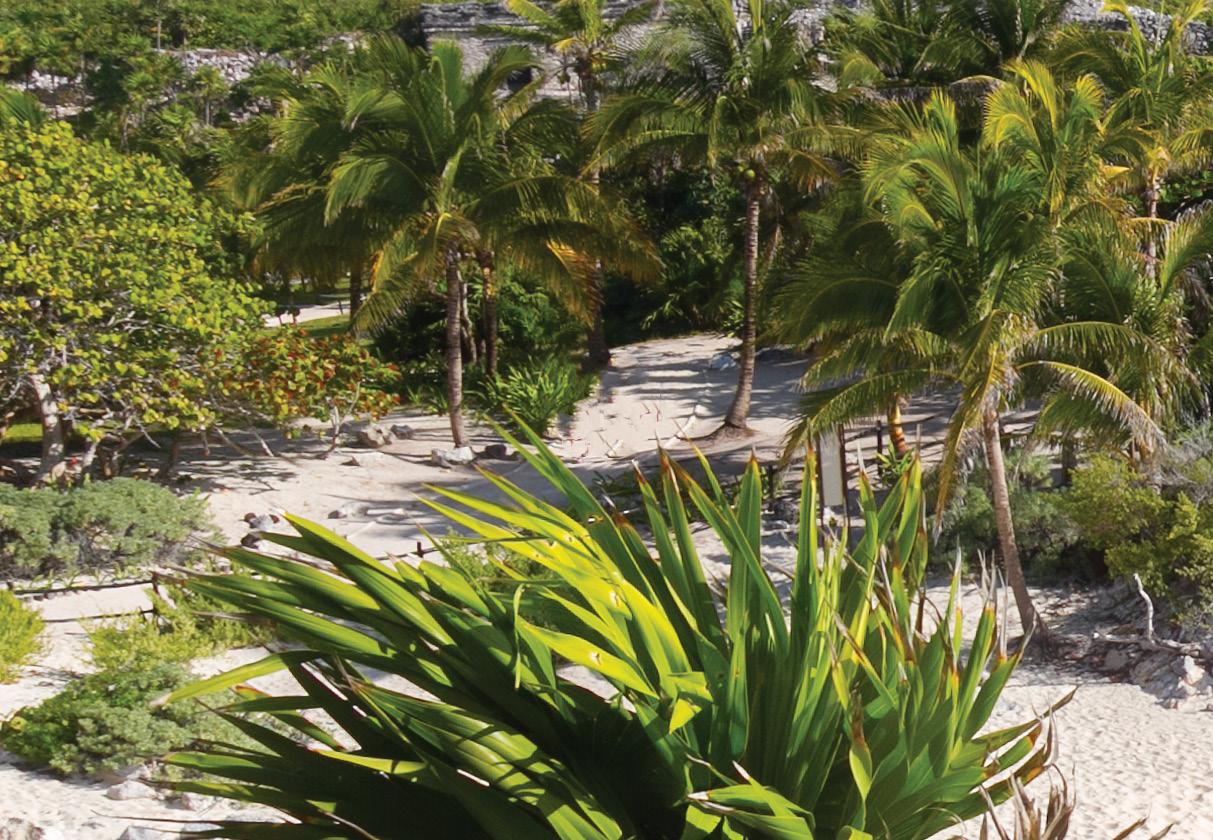
the
a





goal areas as listed in the

the

Table of Contents
UNIDAD 1: De vuelta a clases

Contexto comunicativo e intercultural
Encuentro intercultural: . . . . . . . . . . . . . . . . . . . . . . . . . . . . . . 4
Ecuador con David ¿Te acuerdas? . . . . . . . . . . . . . . . . . . . . . . . . . . . . . . . . . . . . . . . . . 6
Comunica y Explora A . . . . . . . . . . . . . . . . . . . . . . . . . . . . . . . 14
La estructura de la escuela
Así se dice 1 Las partes de la escuela . . . . . . . . . . . . . . . . . . 15
Así se dice 2 Las profesiones en la escuela . . . . . . . . . . . . . . 18
Así se dice 3 Las asignaturas . . . . . . . . . . . . . . . . . . . . . . . . . 19
Así se dice 4 Las actividades del aula . . . . . . . . . . . . . . . . . . 21
Así se dice 5 Para describir a los profesores . . . . . . . . . . . . . 25
Observa 1 Making comparisons in Spanish . . . . . . . . . . . 27
Enfoque en la forma Making comparisons in Spanish
Así se dice 6 Las actividades extracurriculares . . . . . . . . . . 29
En camino A . . . . . . . . . . . . . . . . . . . . . . . . . . . . . . . . . . . . . . . . . 34
¡Bienvenidos a nuestro colegio! Síntesis de gramática y vocabulario . . . . . . . . . . . . . . . . . . . 35
Comunica y Explora B . . . . . . . . . . . . . . . . . . . . . . . . . . . . . . . . 36
El ambiente de la escuela Así se dice 7 Las evaluaciones y las tareas . . . . . . . . . . . . . . 37
Estrategias Interpretive Listening and Reading . . . . . 38
Observa 2 Expressing obligation . . . . . . . . . . . . . . . . .
Así se dice 8 Las reglas en la escuela . . . . . . . . . . . .
Así se dice 9 El ambiente de la escuela . . . . . . . . . . .
En camino B . . . . . . . . . . . . . . . . . . . . . . . . . . . . . . . . . . . .
Cómo
SUMMATIVE ASSESSMENT
Unit Goals
Exchange information about academic and extracurricular offerings at your school.
Read and listen to information about a variety of schools in Spanish-speaking cultures to draw comparisons with your own.
Present your school to visiting students and advise them how to be successful in your school.
Investigate how schools in the Andean region of South America promote learning and student involvement.
Essential Questions
What helps students engage in their school community?
What factors support student learning and success?
How do schools in different cultural contexts meet the needs of their students?
Unit Goals
Exchange and compare information about family structure, family members, routines, and daily responsibilities.
Analyze family structures, roles of family members, and household norms.
Reflect on the culture of your family and what family means to you. Predict what your family and home are going to be like in the future.
Preguntas esenciales
What do families and households look like?
What is the culture of your family like and how has it changed from past generations?
What do you want in a home or family unit in the future?
UNIDAD 2: La cultura de una familia
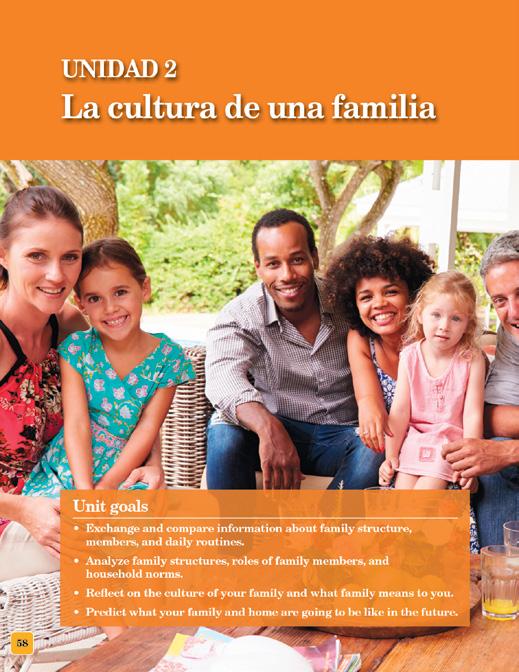
Contexto comunicativo e intercultural
Encuentro intercultural: . . . . . . . . . . . . . . . . . . . . . . . . . . . . . 60
México con Nayeli ¿Te acuerdas? . . . . . . . . . . . . . . . . . . . . . . . . . . . . . . . . . . . . . . . . 62
Comunica y Explora A . . . . . . . . . . . . . . . . . . . . . . . . . . . . . . . 68
Cada familia se ve diferente
Así se dice 1 . . . . . . . . . . . . . . . . . . . . . . . . . . . . . . . . . . . . . . 69
Los miembros y la estructura de la familia
Observa 1 Comparaciones de igualdad . . . . . . . . . . . . . . . . . . 72
Observa 2 Los superlativos . . . . . . . . . . . . . . . . . . . . . . . . . . . 74
Así se dice 2 Las características físicas . . . . . . . . . . . . . . . . . 76
Así se dice 3 Las personalidades . . . . . . . . . . . . . . . . . . . . . . 79
Observa 3 Los superlativos con “el más” . . . . . . . . . . . . . . . . . 82
Así se dice 4 Las rutinas diarias . . . . . . . . . . . . . . . . . . . . . . 83
Observa 4 Los verbos reflexivos . . . . . . . . . . . . . . . . . . . . . 84
Enfoque en la forma Los verbos reflexivos Estrategias Connectors and Sequencing Words . . . . . . 87 En camino A . . . . . . . . . . . . . . . . . . . . . . . . . . . . . . . . . . . . . . . . . 89
El mejor estudiante de intercambio para tu familia Síntesis de gramática y vocabulario . . . . . . . . . . . . . . . . . . . 90 Comunica y Explora B . . . . . . . . . . . . . . . . . . . . . . . . . . . . . . . 92
Cada familia funciona de manera diferente
Así se dice 5 Las relaciones en la familia . . . . . . . . . . . . . . . 96
Así se dice 6 El tiempo en familia . . . . . . . . . . . . . . . . . . . . . 98
Observa 5 El imperfecto . . . . . . . . . . . . . . . . . . . . . . . . . . 100
Enfoque en la forma El imperfecto
Así se dice 7 Los valores de la familia . . . . . . . . . . . . . . . . . 104
Así se dice 8 Los quehaceres de la casa . . . . . . . . . . . . . . . . 107
En camino B . . . . . . . . . . . . . . . . . . . . . . . . . . . . . . . . . . . . . . . . 111
¿Cómo eran las familias antes, cómo son ahora?
Síntesis de gramática y vocabulario . . . . . . . . . . . . . . . . . . 112
SUMMATIVE ASSESSMENT
Vive entre culturas: Mi familia del futuro . . . . . . . . . . . . . . . 114
Interpretive Listening Assessment
Interpersonal Speaking Assessment
Presentational Writing Assessment
UNIDAD 3: Un mundo hecho por comunidades
Contexto comunicativo e intercultural
Encuentro intercultural: . . . . . . . . . . . . . . . . . . . . . . . . . . . . . 118
Nicaragua con Nema ¿Te acuerdas? . . . . . . . . . . . . . . . . . . . . . . . . . . . . . . . . . . . . . . . 120
Comunica y Explora A . . . . . . . . . . . . . . . . . . . . . . . . . . . . . . 127
Navegando y conociendo nuestras comunidades
Así se dice 1 Los lugares en la comunidad . . . . . . . . . . . . . 129
Así se dice 2 Las tiendas . . . . . . . . . . . . . . . . . . . . . . . . . . . . 134
Observa 1 El pretérito . . . . . . . . . . . . . . . . . . . . . . . . . . . 140
Enfoque en la forma El pretérito
Así se dice 3 . . . . . . . . . . . . . . . . . . . . . . . . . . . . . . . . . . . . . 141
Los servicios y las actividades en la comunidad
Así se dice 4 Los tipos de transporte . . . . . . . . . . . . . . . . . . 142
Así se dice 5 Cómo pedir y dar direcciones . . . . . . . . . . . . . 145
Observa 2 Los mandatos informales . . . . . . . . . . . . . . . . 146
Enfoque en la forma Los mandatos informales Estrategias Phone Conversations . . . . . . . . . . . . . . . . 148
En camino A . . . . . . . . . . . . . . . . . . . . . . . . . . . . . . . . . . . . . . . . 151
Una visita a Granada Síntesis de gramática y vocabulario . . . . . . . . . . . . . . . . . . 152 Comunica y Explora B . . . . . . . . . . . . . . . . . . . . . . . . . . . . . . 155
Celebrando y mejorando nuestras comunidades
Así se dice 6 La identidad de la comunidad . . . . . . . . . . . . 156
Así se dice 7 Trabajar en comunidad . . . . . . . . . . . . . . . . . . 160
Unit Goals
Explore the layout, services, and transportation of communities in Nicaragua.
Understand and provide directions to get around in communities.
Explain how volunteers inspire and organize others to make a difference.
Disseminate information to get people involved in community improvement projects in Central America.
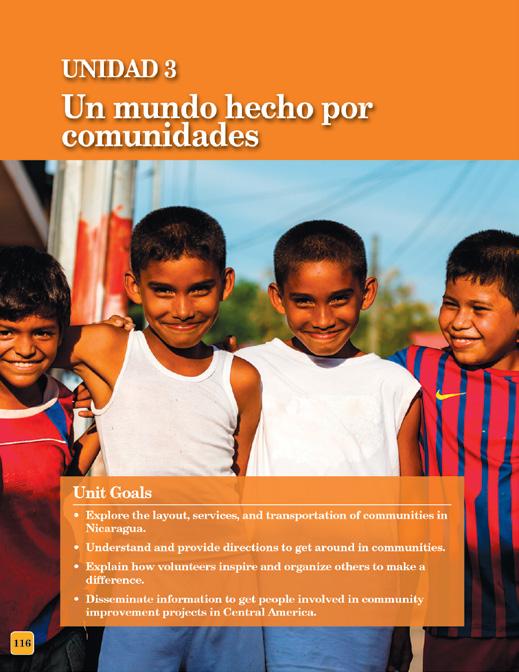
Preguntas esenciales
Así se dice 8 El voluntariado . . . . . . . . . . . . . . . . . . . . . . . . 163 En camino B . . . .
. . . . .
Las celebraciones comunitarias Síntesis de gramática y vocabulario . . . . . . . .
SUMMATIVE ASSESSMENT
Vive entre culturas: El mundo de un voluntario . . . . . . .
Interpretive Listening Assessment
Presentational Writing Assessment
Interpersonal Speaking Assessment
167
168
How does culture shape where people go and what they do in their communities?
169
How do people come together to celebrate their cultural identity and communities?
How can community members work together to improve their quality of life?
Unit Goals
Identify ingredients necessary to prepare Caribbean recipes.
Demonstrate how to prepare typical dishes and explain their cultural importance.
Give and receive advice about how to care for common illnesses.
Promote the use of traditional recipes and ingredients to address common health issues.
Preguntas esenciales
How does food connect cultures, communities and families?
How can food help address health issues?
How can traditional health practices inform our modern lifestyle?
UNIDAD 4: En la cocina de mi abuela
Contexto comunicativo e intercultural
Encuentro intercultural: . . . . . . . . . . . . . . . . . . . . . . . . . . . . . 172
Cuba con Mariela ¿Te acuerdas? . . . . . . . . . . . . . . . . . . . . . . . . . . . . . . . . . . . . . . . 174
Comunica y Explora A . . . . . . . . . . . . . . . . . . . . . . . . . . . . . . . 178
Las recetas de la abuela

Así se dice 1 . . . . . . . . . . . . . . . . . . . . . . . . . . . . . . . . . . . . . 179
Productos típicos del Caribe
Observa 1 Los pronombres de complemento directo . . . . . . 181
Así se dice 2 Los ingredientes . . . . . . . . . . . . . . . . . . . . . . . 183
Así se dice 3 Para describir la comida . . . . . . . . . . . . . . . . . 187
Así se dice 4 Preparar la comida . . . . . . . . . . . . . . . . . . . . . 190
Así se dice 5 Los utensilios . . . . . . . . . . . . . . . . . . . . . . . . . . 193
Observa 2 Los mandatos formales . . . . . . . . . . . . . . . . . . 194
Enfoque en la forma Los mandatos formales
Así se dice 6 Los horarios y las costumbres de comer . . . . . 198
Observa 3 El pretérito irregular . . . . . . . . . . . . . . . . . . . . . . 201
En camino A . . . . . . . . . . . . . . . . . . . . . . . . . . . . . . . . . . . . . . . . 203
Un blog de recetas interculturales Síntesis de gramática y vocabulario . . . . . . . . . . . . . . . . . . 204 Comunica y Explora B . . . . . . . . . . . . . . . . . . . . . . . . . . . . . . 206
Recetas caseras para mantener la salud
Así se dice 7 Las partes del cuerpo . . . . . . . . . . . . . . . . . . . 207
Así se dice 8 Las enfermedades y los síntomas . . . . . . . . . . 208
Estrategias Negotiating Meaning . . . . . . . . . . . . . . . . . . 209 in Conversations
Así se dice 9 Los remedios . . . . . . . . . . . . . . . . . . . . . . . . . . 214 En camino B . . . . . . . . . . . . . . . . . . . . . . . . . . . . . . . . . . . . . . . . 219
De visita en el policlínico Síntesis de gramática y vocabulario . . . . . . . . . . . . . . . . . . 220
SUMMATIVE ASSESSMENT
Vive entre culturas: Remedios caseros durante una visita . . . 222
Interpretive Listening Assessment
Interpersonal Speaking Assessment
Presentational Speaking Assessment
UNIDAD 5: Vida social

Contexto comunicativo e intercultural
Encuentro intercultural: . . . . . . . . . . . . . . . . . . . . . . . . . . . . . 226
Perú con Bruno
¿Te acuerdas? . . . . . . . . . . . . . . . . . . . . . . . . . . . . . . . . . . . . . . . 228
Comunica y Explora A . . . . . . . . . . . . . . . . . . . . . . . . . . . . . . . 232
En mi tiempo libre
Así se dice 1 Las invitaciones . . . . . . . . . . . . . . . . . . . . . . . . 233
Así se dice 2 Para invitar . . . . . . . . . . . . . . . . . . . . . . . . . . . 236
Estrategias Extend and Respond to Invitations . . . . 238
Observa 1 El pretérito con "hace mucho tiempo" . . . . . . . . . 239
Así se dice 3 Los destinos . . . . . . . . . . . . . . . . . . . . . . . . . . . 240
Así se dice 4 Las actividades al aire libre . . . . . . . . . . . . . . 243
Observa 2 El pretérito y el imperfecto 1 . . . . . . . . . . . . . 245 Enfoque en la forma El pretérito y el imperfecto 1 En camino A . . . . . . . . . . . . . . . . . . . . . . . . . . . . . . . . . . . . . . . . 250
Una visita a Lima Síntesis de gramática y vocabulario . . . . . . . . . . . . . . . . . . 251 Comunica y Explora B . . . . . . . . . . . . . . . . . . . . . . . . . . . . . . . 253
Ir de compras
Así se dice 5 Las tiendas . . . . . . . . . . . . . . . . . . . . . . . . . . . . 254
Observa 3 Los adjetivos demostrativos . . . . . . . . . . . . . . . . . 256
Así se dice 6 Para ir de compras . . . . . . . . . . . . . . . . . . . . . . 259
Observa 4 Los pronombres de complemento indirecto . . . . . 261
Así se dice 7 Los precios . . . . . . . . . . . . . . . . . . . . . . . . . . . . 262
Así se dice 8 En la tienda de ropa . . . . . . . . . . . . . . . . . . . . 269
Así se dice 9 El equipo deportivo . . . . . . . . . . . . . . . . . . . . . 275
Observa 5 . . . . . . . . . . . . . . . . . . . . . . . . . . . . . . . . . . . . . . . . 278
Los pronombres de complemento directo e indirecto Enfoque en la forma
Los pronombres de complemento directo e indirecto En camino B . . . . . . . . . . . . . . . . . . . . . . . . . . . . . . . . . . . . . . . . 281
Aprovechando una oferta especial Síntesis de gramática y vocabulario . . . . . . . . . . . . . . . . . . 282
SUMMATIVE ASSESSMENT
Vive entre culturas: Una aventura en Perú . . . . . . . . . . . . . . 284
Interpretive Reading Assessment
Interpersonal Speaking Assessment
Presentational Speaking Assessment
Unit Goals
Interact with others in a variety of shopping situations.
Narrate what you did with friends and family, and outdoors.
Extend, accept, and politely turn down invitations to social events.
Explore the adventures of young people in Peru and describe your own.
Preguntas esenciales
How do friends, family and culture influence how I spend my free time?
How do my shopping choices reflect who I am?
What outdoors experiences can young people have in Peru?
Unit Goals
Communicate basic needs and requests related to travel, lodging, dining, and getting around.
Explore various historic, cultural, and geographic destinations in Argentina.
Describe responsible and culturally sensitive tourism.
Narrate a story about a past travel experience.
Preguntas esenciales
What do I need to know to travel to another culture?
What can you learn about yourself and another culture by traveling?
How do travel experiences shape our intercultural understanding and respect for the communities we visit?
UNIDAD 6: Un viaje al extranjero
Contexto comunicativo e intercultural
Encuentro intercultural: . . . . . . . . . . . . . . . . . . . . . . . . . . . . . 288
Argentina con Laura ¿Te acuerdas? . . . . . . . . . . . . . . . . . . . . . . . . . . . . . . . . . . . . . . . 290
Comunica y Explora A . . . . . . . . . . . . . . . . . . . . . . . . . . . . . . . 296
Viajando por Argentina
Así se dice 1 En el aeropuerto . . . . . . . . . . . . . . . . . . . . . . . 297
Así se dice 2 Antes de abordar el vuelo . . . . . . . . . . . . . . . . 298
Observa 1 Pretérito e imperfecto 2 . . . . . . . . . . . . . . . . . 302
Enfoque en la forma Pretérito e imperfecto 2
Así se dice 3 En el avión . . . . . . . . . . . . . . . . . . . . . . . . . . . . 309
Así se dice 4 En la estación del ómnibus y del tren . . . . . . 314
Así se dice 5 En el subte . . . . . . . . . . . . . . . . . . . . . . . . . . . . 317
En camino A . . . . . . . . . . . . . . . . . . . . . . . . . . . . . . . . . . . . . . . . 318
Un viaje memorable
Síntesis de gramática y vocabulario . . . . . . . . . . . . . . . . . . 319 Comunica y Explora B . . . . . . . . . . . . . . . . . . . . . . . . . . . . . . . 322
Conociendo Argentina
Así se dice 6 El turismo comunitario . . . . . . . . . . . . . . . . . . 323
Así se dice 7 En el hotel . . . . . . . . . . . . . . . . . . . . . . . . . . . . 327
Observa 2 Verbos con cambios de raíz en el pretérito . . . . . 331
Así se dice 8 En el restaurante . . . . . . . . . . . . . . . . . . . . . . . 333
Así se dice 9 Los destinos turísticos . . . . . . . . . . . . . . . . . . . 335
Estrategias Culturally Sensitive Travel . . . . . . . . . . . 340
En camino B . . . . . . . . . . . . . . . . . . . . . . . . . . . . . . . . . . . . . . . . 341
Por los caminos de Argentina
Síntesis de gramática y vocabulario . . . . . . . . . . . . . . . . . . 342
SUMMATIVE ASSESSMENT
Vive entre culturas: Cómo ser un viajero y no un turista . . . . 344
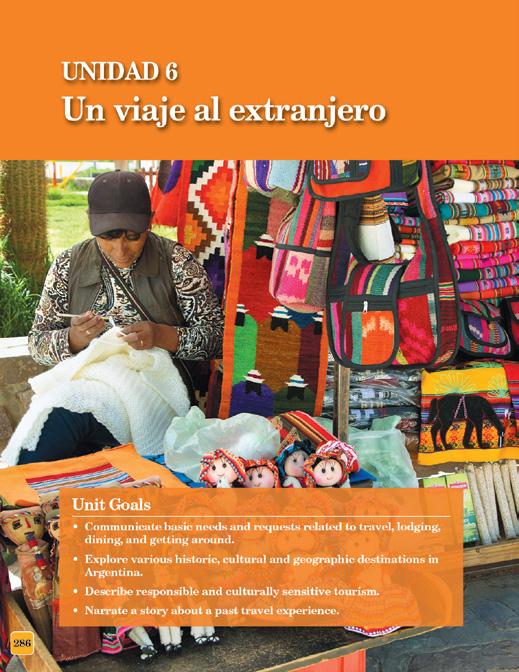
Interpretive Audiovisual Assessment
Interpersonal Speaking Assessment
Presentational Writing Assessment

UNIDAD 1

De vuelta a clases
Unit Goals
• Exchange information about academic and extracurricular offerings at your school.


• Read and listen to information about a variety of schools in Spanish-speaking cultures to draw comparisons with your own.
• Present your school to visiting students and advise them how to be successful in your school.
• Investigate how schools in the Andean region of South America promote learning and student involvement.
Ecuador

Preguntas esenciales
What helps students engage in their school community?
What factors support student learning and success?
How do schools in different cultural contexts meet the needs of their students?

Encuentro intercultural 4
Meet David, a teenager from Quito, Ecuador, who will tell you about his school, classes, and teachers.
¿Te acuerdas? 6

Let’s see what you remember about places in the school, school materials, and how to describe things in a classroom.
Comunica y Explora A: La estructura de la escuela 14
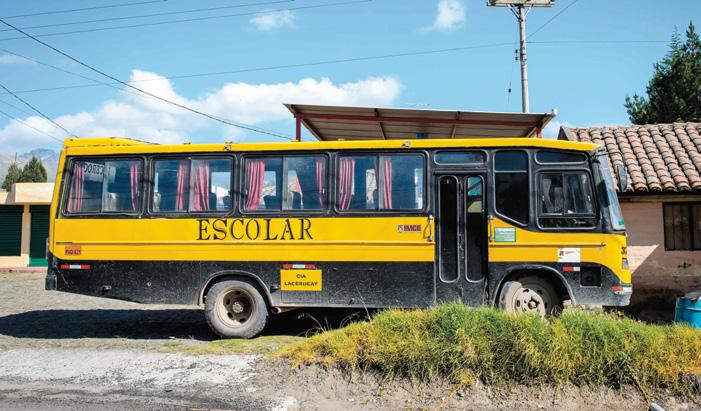
What do schools provide to their students to encourage learning and to get students involved in the school community? Describe and compare your schedule, classes, teachers, and activities.
Sintesis de gramática y vocabulario 35
Learn to make comparisons of similarities and differences while describing your teachers, classes, and schedules.
Comunica y Explora B: Un ambiente escolar que facilita el éxito académico 36
What factors contribute to a positive school atmosphere and promote student learning and success? Describe how students and teachers contribute to a learning environment, explain school norms, and offer advice to a peer about how to be successful in school.
Síntesis de gramática y vocabulario 53
Learn to express obligation (hay que y tener que) in the context of what you have to do to be successful in school.
Vive entre culturas: Una escuela ideal 56
What does an ideal school look like? Design an ideal school focusing on the various factors within a school that contribute to student learning and success.
Nombre: David


Edad: quince
Idiomas: español e inglés




Origen: Quito, Ecuador




Encuentro intercultural
David vive en Quito, Ecuador. Tiene 15 años y está en el grado 11 en el Colegio José Engling. Tiene dos hermanos menores, Daniel y Andrés. También tiene una hermana mayor que se llama Ana Francisca. A David le gusta jugar con su perro, tocar la guitarra y cantar con su familia. David describe su colegio en una conversación con una amiga, Paulina. El colegio de David es un colegio mixto (co-ed) y católico, que va desde pre-kinder hasta duodécimo grado.



Información sobre Ecuador






Ecuador es un país pequeño en Sudamérica. Está entre Colombia y Perú y es uno de los países con más biodiversidad en el continente americano. Puedes visitar montañas y volcanes activos en los Andes. También puedes conocer la selva amazónica y playas hermosas en el océano Pacífico. La capital del Ecuador es Quito y el puerto (port) principal es Guayaquil.


Mujer indígena - Paute - Ecuador
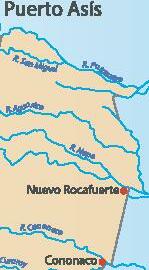

El idioma oficial de Ecuador es el español, pero se hablan también quichua (un dialecto del quechua) y otras 20 lenguas entre las diferentes comunidades indígenas (indigenous). Los pueblos indígenas son la gente nativa de un país. Muchos niños ecuatorianos hablan dos idiomas: el español y una lengua indígena.


Islas Galápagos


Juan León Mera (1832–1894)

Novelista, político y pintor ecuatoriano. Escribió poesía, ensayos y novelas. Sus obras más importantes son la novela “Cumandá” y el himno nacional del Ecuador.
BOGOTÁIsla Bartolomé - Galápagos

Charles Darwin viajó a las islas Galápagos para estudiar la teoría de la evolución de las especies.
Ecuador
Je erson Pérez (1974– )
Atleta olímpico

Ganó medallas en los juegos olímpicos; de oro en Atlanta en 1996 y de plata en Pekín en 2008 en marcha atlética.

Manuela Sáenz (1795–1856)

“La Libertadora del Libertador”

Luchó junto a Simón Bolivar para obtener la independencia de España.

A ver qué recuerdas para describir la escuela
Actividad 1
¿Qué hay en tu mochila o casillero?
Paso 1: Escuchar
Escucha a Yarima mientras ella describe cómo usa los materiales escolares en su mochila. Escribe la letra que identifica el material escolar con la descripción.




Paso 2: Escribir




a. Toma una foto o crea una ilustración de todos los útiles (materiales) escolares que siempre llevas en tu mochila o que tienes en tu casillero.

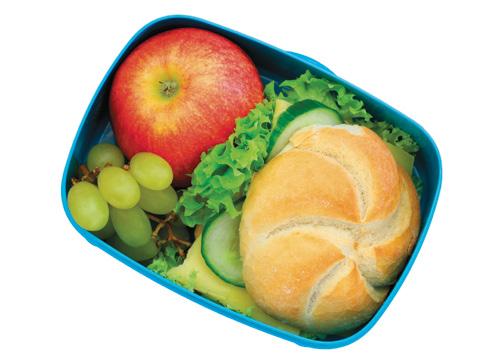



b. Identifica todos los útiles.
c. Escribe una descripción de cada uno.


Modelo
Hay un bolígrafo anaranjado en mi mochila porque me gusta escribir con mi color favorito.
A. E.
B. F.
C. G.
D. H. I. J.
De vuelta a clases
Actividad 2
¿Qué hay en el salón de clase?
Paso 1: Observar y conversar
Con un/a compañero/a, túrnense para hacer las siguientes preguntas sobre las cosas que hay en el aula de español. Sigan el modelo.



Modelo






Estudiante A: ¿Hay ventanas en el salón de clase?

Estudiante B: Sí, hay tres ventanas.
Enfoque cultural

Práctica cultural: Variedad lingüística
Spanish-speaking regions and countries have varieties of Spanish with distinct names for common vocabulary. Here are some examples of di erent words for school supplies:




Conexiones



Recuerda: Usos del verbo estar
The verb estar is used with prepositions (like encima de, debajo de, delante de, and en) to describe the location of objects.

• Los libros están en el escritorio.


• La pantalla está delante de los pupitres.



Estar is also used to talk about where people are located.
• La maestra está en el gimnasio.
• Los estudiantes están en la oficina del director.
Expresiones útiles
a la derecha de - to the right of a la izquierda de - to the left of enfrente de - facing al lado de - next to, beside delante de - in front of, opposite of en - in, inside encima de - on top of debajo de - underneath of cerca de - near lejos de - far from
Paso 2: Preguntar y responder
Tomen turnos con un/a compañero/a y hagan preguntas. Intercambia información con tu compañero/a para saber dónde están los objetos en la clase de español. Sigan el modelo.

Modelo
Estudiante A: ¿Dónde están las tijeras?
Estudiante B: Las tijeras están encima del escritorio del profesor.


De vuelta a clases
Actividad 3
¿Cómo puede ser diferente el calendario escolar?
Paso 1A: Recordar
Describe tu calendario escolar, mencionando los días feriados y las vacaciones.
• Comienza el…
• Termina el…
• Hay vacaciones veces al año.
• Las vacaciones duran días.
Calendario anual del año escolar 2015–2016 Colegio 9 de Octubre. Guayaquil – Ecuador

Inicio del año escolar 4 de mayo
Fin de año escolar 9 de marzo
Vacaciones de Carnaval del 7 al 10 de febrero
Vacaciones de Semana Santa del 30 de marzo al 3 de abril
Día feriado: Día del Trabajo El primero de mayo
Vacaciones de medio año del 3 al 18 de octubre
Día feriado: Día de la Raza el 12 de octubre
Día feriado: Día de los Muertos el 2 de noviembre
Exámenes finales del 2 al 9 de marzo
Actos de graduación 12 de marzo
Paso 1B: Leer y comparar
Lee el calendario escolar del primo de David, quien estudia en el Colegio 9 de Octubre. Compáralo con el horario de tu escuela, y completa un diagrama de Venn con las diferencias y semejanzas entre los dos calendarios.
Enfoque cultural
Práctica cultural: Crear un “puente”
There are many holidays in the yearly school calendar for Colegio 9 de Octubre. In many countries in Latin America and Spain, if there is a holiday in the middle of the week, for example on a Tuesday, the government makes the Monday before a day of celebration as well to create what is called a “puente” or a long holiday weekend.
Conexiones
Do you think having an extra day o school between a national holiday and a weekend is a good idea? What are the advantages and disadvantages?

¿Te acuerdas?
Los meses del año
En parejas, túrnense para nombrar los meses del año en voz alta. La primera persona empieza con “enero”, la segunda persona sigue con “febrero” hasta terminar el año.
Ahora comparte esta información con tu compañero/a.
• Mi cumpleaños es…
• Mi mes favorito del año es… porque…
No hay clases durante las Vacaciones de Carnaval, porque muchas personas participan en las celebraciones.
Unidad 1 | ¿Te acuerdas?
Enfoque cultural Práctica cultural: El año escolar en el Ecuador
In Ecuador the school year is divided in quimestres (two periods of ve months each). There are two di erent school calendars, one for the coastal region and one for the sierra or mountain region. On the coast, the rst quimestre goes from May to September and the second quimestre goes from October to March. In the mountains the rst quimestre goes from September to January and the second quimestre goes from February to July. In both regions there are two weeks of vacation between each quimestre, and at the end of the year there is one month of vacation. This variation in schedule is because of the di erences in weather between the regions and the di culties in traveling to school during the rainy season on the coast.

Conexiones
Do schools in your country have di erent school calendars based on the weather? What are the possible bene ts of modifying school schedules based on climate di erences in Ecuador?

Paso 1C: Conversar
a. Muestra tu diagrama de Venn a un/a compañero/a.
b. Si tu compañero/a tiene nueva información, añade sus ideas a tu organizador gráfico.

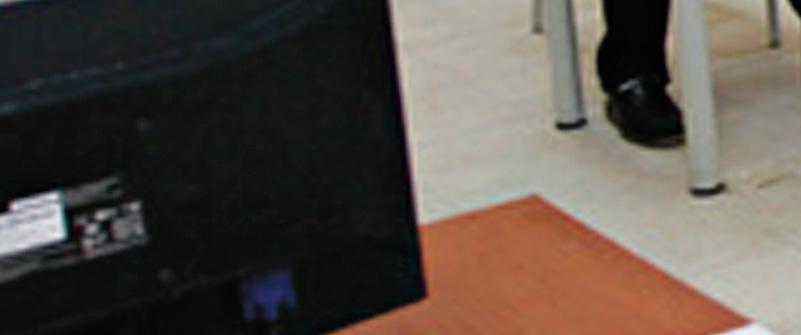
Modelo
Las diferencias son… En Ecuador… Aquí…
Las semejanzas son… En los dos colegios…
Paso 2: Comunicar tus preferencias
¿Crees que tu escuela debe cambiar el calendario escolar? Escribe algunas sugerencias (suggestions) para la administración.
• El año escolar debe comenzar en…




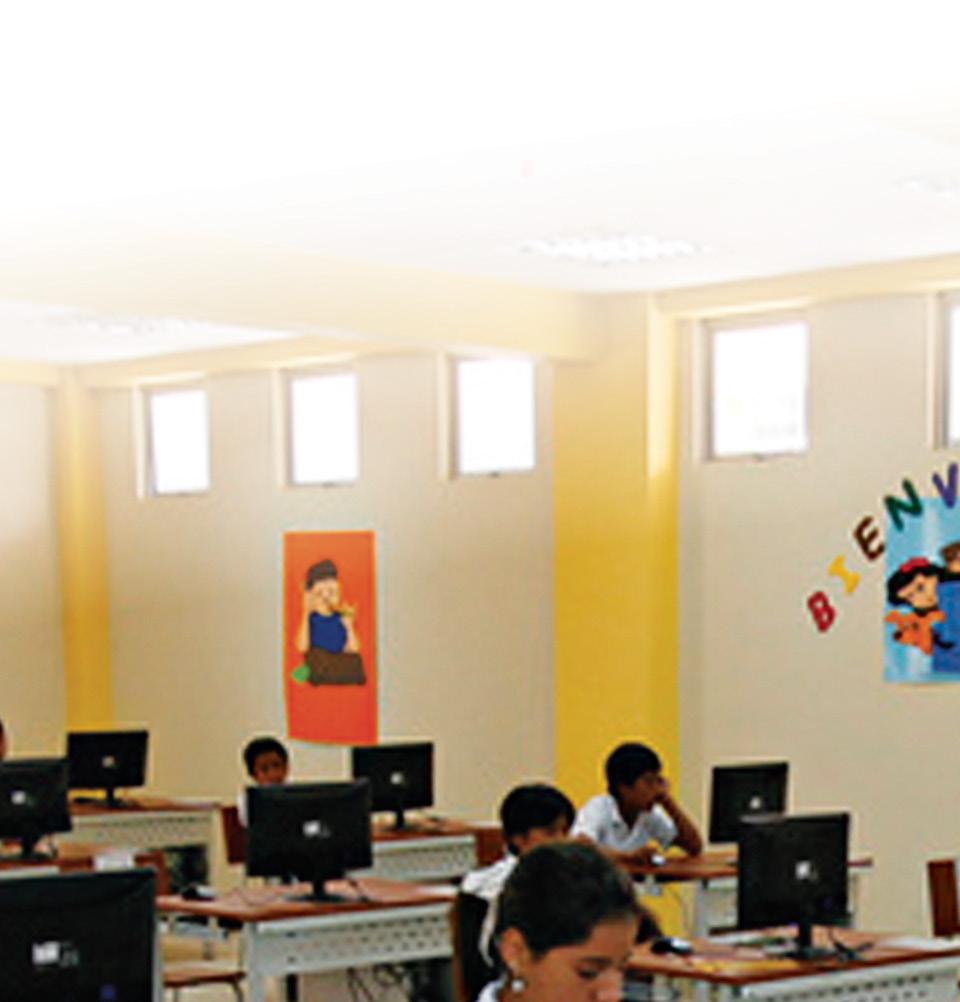
• Me gustaría tener vacaciones en…
• ¿Por qué no…?
• Es mejor si…
De vuelta a clases
Paso 3: Escribir un correo electrónico

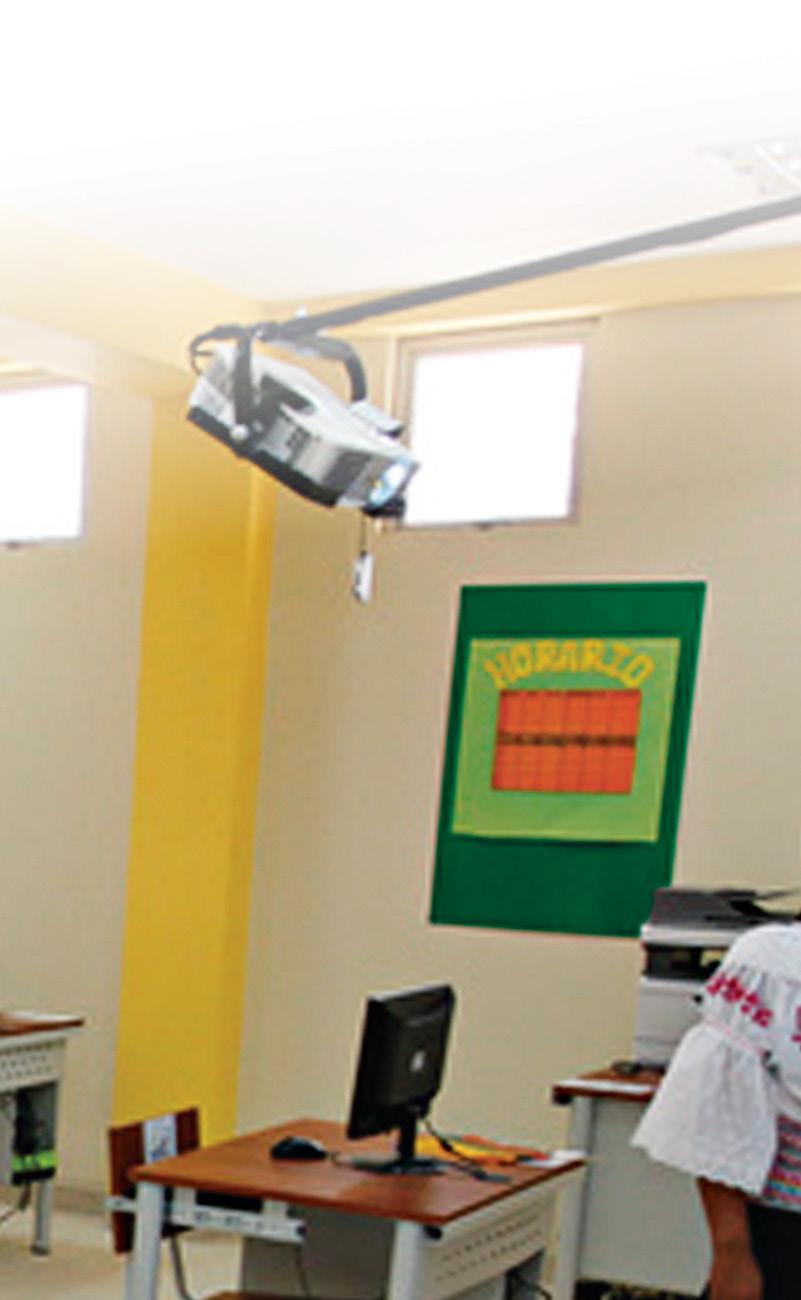
David te invita a conocer su ciudad. Necesitas ir durante tus vacaciones escolares.
a. Mira los dos calendarios y decide cuándo puedes visitar.
b. Comunica tu plan a David en un correo electrónico:
• Saluda a David.
• Describe tu clase favorita este año y explica por qué.
• Explica cuándo quieres visitar y por qué es conveniente.
• Explica tu emoción acerca de esta visita y despídete.
Actividad 4
¿Cuál es el horario ideal para tus clases?


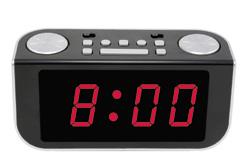
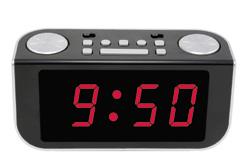
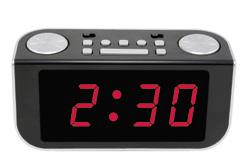
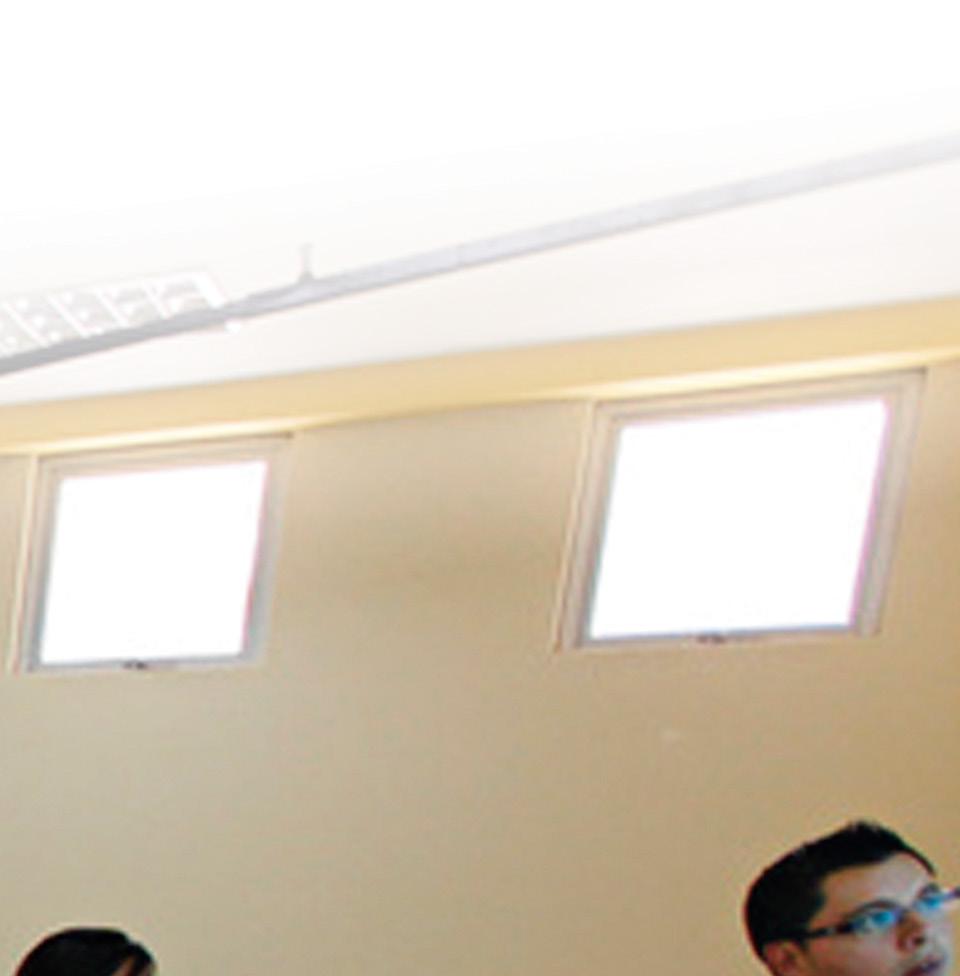




Paso 1A: Escuchar e identificar
Vas a escuchar información de cuándo David tiene algunas de sus clases. Elige el reloj correspondiente.
Expresiones útiles
Tienes vacaciones en…y yo no tengo clases en… - You have vacations in… and I don’t have classes in ¿Qué tal si viajo…? - How about if I travel…?
¿Está bien si…? - Is it OK if…? Me gustaría… - I would like… indígenas - indigenous (native to a region)

Saludos y despedidas informales
Querido/a… - Dear Hola, - Hi
Adiós, - Goodbye

Chao, - Goodbye
Un beso, - A kiss
Unidad 1 | ¿Te acuerdas?
Paso 1B: Practicar en parejas
Elige del siguiente cuadro un día de la semana y una hora. Túrnense y pregunten a su compañero/a qué clase tiene ese día a esa hora.
Días lunesmartesmiércolesjuevesviernes Horas 8:15 a.m.9:40 a.m.10:30 a.m. 12:00 1:45 p.m.
Modelo
Estudiante A: ¿Qué clase tienes los miércoles a las 10:30 de la mañana?
Estudiante B: Tengo clase de Matemáticas.
Paso 2A: Escribir
¿A qué hora quieres tener las clases? Escribe tu horario ideal con las clases en el orden que prefieres.
Paso 2B: Conversar y escribir

Con un/a compañero/a, túrnense para describir sus horarios ideales. Escucha a tu compañero/a y escribe su horario ideal. Sigue el modelo.
Modelo
Estudiante A dice: A las , tengo la clase de… Estudiante B escribe:A las él/ella tiene la clase de…

Si necesitas escuchar otra vez, puedes decir “Repite, por favor” o preguntar “¿Qué clase tienes a las ?”
Paso 2C: Revisar
¿Tienes la información correcta? Describe a tu compañero/a el horario que escribiste y él/ella te va a decir si hay algún error.
Modelo
Estudiante B: En tu horario ideal, tienes la clase de a las .
Estudiante A: Sí, es correcto. (No, no es correcto. Tengo la clase de a las .)

vuelta

¿Te acuerdas?
Los lugares en la escuela el auditorio el aula de clase la biblioteca la cafetería los campos deportivos la clínica el gimnasio
el laboratorio la oficina el pasillo la sala de computadoras la sala de música el salón de clase
El ambiente de la escuela académico estricto tranquilo
Expresiones útiles



¿Está bien si… ?

¿Qué tal si viajo… ? Me gustaría…






Las profesiones en la escuela el/la asistente del director el/la director/a el/la maestro/a el/la profesor/a el/la recepcionista el/la secretario/a
Las actividades extraescolares el club de… los deportes baloncesto fútbol vóleibol
Las descripciones aburrido/a agradable (desagradable) cómico/a deportivo/a difícil divertido/a estricto/a fácil generoso/a serio/a sincero/a trabajador/a
Los materiales escolares el bolígrafo la calculadora la carpeta la computadora el cuaderno un diccionario el escritorio el instrumento el lápiz los lápices de colores el libro la mochila



el móvil la pantalla la pelota el portátil el pupitre la tableta las tarjetas el teclado las tijeras

Las asignaturas Álgebra Arte Banda Ciencias Sociales Coro Dibujo Educación Cívica Educación Física Francés Geografía Geometría Informática Matemáticas Salud
Las actividades en el aula ayudar a los estudiantes compañero/a dibujar enseñar escribir estudiar hacer gimnasia intercambiar con jugar llevar uniforme mirar películas
navegar en/por internet observar participar en un intercambio pintar practicar deportes prestar atención tomar apuntes trabajar trabajar con los colegas usar las computadoras

El horario y las tareas almorzar empezar la hora del almuerzo las notas el proyecto el recreo; el receso terminar
Expresiones útiles a la derecha de a la izquierda de al lado de cerca de
debajo de delante de en encima de
enfrente de lejos de
Comunica y Explora A
La estructura de la escuela
Pregunta esencial: What helps students engage in their school community?
Así se dice 1: Las partes de la escuela 15
What parts of a school help students learn and thrive? Learn to describe and compare parts of different school buildings
Así se dice 2: Las profesiones en la escuela 18
Learn to comprehend and respond to information about school staff members.
Así se dice 3: Las asignaturas 19
Explore the school schedule of a student from the coast of Ecuador. Learn to exchange information about school schedules.
Así se dice 4: Las actividades del aula 21
What classroom activities do you enjoy? Learn to give personal preferences about what you like to do in class
Así se dice 5: Para describir a los profesores 25
What are your teachers like and what connections can you draw between them? Learn to describe different people.
Observa 1: Making comparisons in Spanish 27
Learn to compare different people in terms of how they are similar or different.
Así se dice 6:
Las actividades extracurriculares 29
Learn to give opinions about the extracurricular activities offered in schools.
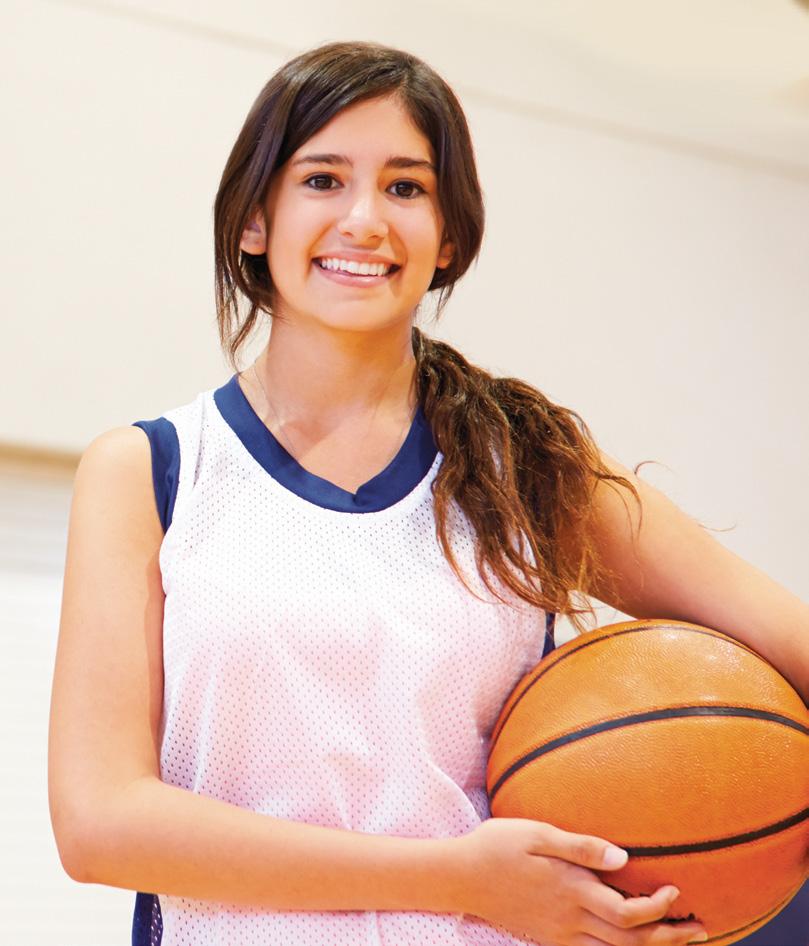


En camino A:
¡Bienvenidos a nuestro colegio! 34
Meet your exchange student from a school in Ecuador. Learn about his/her school, answer questions he/she has about your school, and create a welcome packet with information he/she needs to know to start the school year off right!
Sintesis de gramática y vocabulario 35
vuelta a clases
Actividad 5
¿Cómo son las escuelas en otros países?

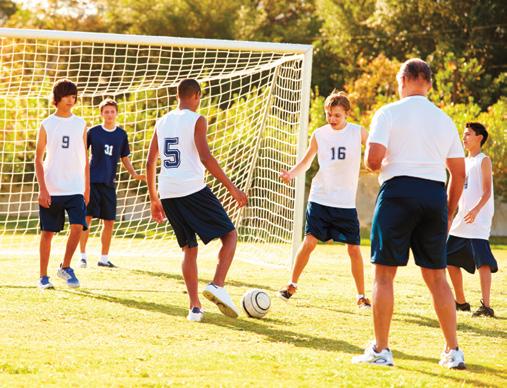
Paso 1: Escuchar y emparejar
Escucha las descripciones de diferentes partes de la escuela. Empareja (match) las descripciones con las imágenes y el vocabulario de Así se dice 1.

Así se dice 1: Las partes de la escuela el campo deportivo la cancha de tenis los casilleros el laboratorio de ciencias el salón de clase el teatro

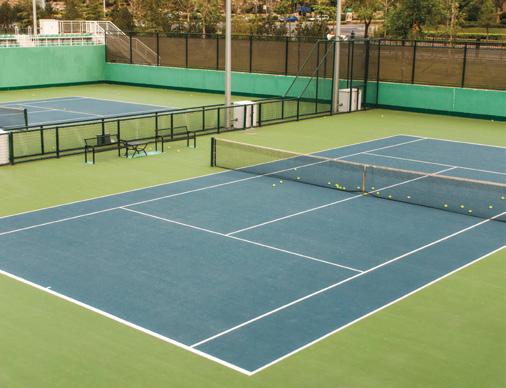

Paso 2: Observar





Mientras ves el video sobre la Escuela del Milenio Sumak Yachana Huasi:
a. Observa atentamente para aprender sobre la escuela.
b. Completa la tabla con la información que observas en el video.
Las personas Las partes de la escuela
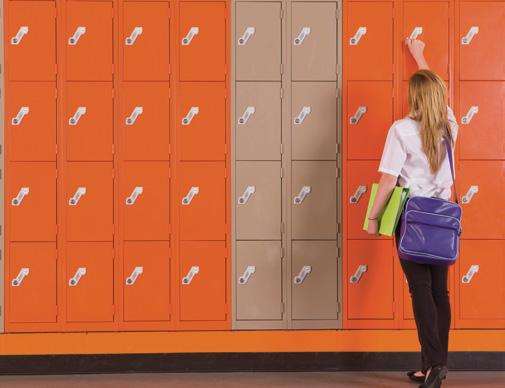
¿Qué hacen las personas en la escuela? ¿Cómo es la escuela?
Enfoque cultural
Práctica cultural: Saludar la bandera
In Ecuador and other Spanish-speaking countries, it is common to see the ag in school and school ceremonies. Students learn the anthem’s verses in school at a young age, often singing it in chorus at ceremonies and assemblies.

Conexiones
Why do schools use the ag in important ceremonies? Is this similar or di erent to how the ag is used in ceremonies and activities where you attend school?
Comunica
Mi progreso comunicativo

I can describe and compare school buildings.
Paso 3A: Comparar

Trabaja con un/a compañero/a para completar el diagrama de Venn con las semejanzas y diferencias entre tu escuela y la escuela ecuatoriana.
La escuela ecuatoriana
una piscina
Mi escuela laboratorios de ciencias un jardín


Paso 3B: Escribir


Escribe cinco oraciones para comparar tu escuela y la escuela ecuatoriana.
Modelo
En mi escuela hay una piscina, no hay una piscina en la escuela ecuatoriana.
La escuela ecuatoriana tiene un jardín, pero mi escuela no tiene un jardín.
Las dos escuelas tienen laboratorios de ciencias.
¡Prepárate!
Escribe cuatro oraciones para describir los lugares en una escuela ideal. Incluye:



• Los lugares en la escuela
• ¿Por qué son necesarios estos lugares?



Modelo

Una escuela ideal debe tener un gimnasio o una cancha para la clase de Educación Física y para jugar deportes.

De vuelta a clases
Reflexión intercultural

What did you learn about the bilingual schools in Ecuador while viewing the video?
What infrastructure does this school have that surprised you? Why?
What elements of this school do you wish were present in your school? Why?
How has your perspective on schools in Ecuador changed after viewing this video?
Actividad 6
¿Por qué son importantes las bibliotecas?
Paso 1: Mirar Mientras miras el video del Biblioburro marca las palabras que escuchas.
compromiso intelectual investigar profe proyecto escolar carta consulta leer biblioteca títulos tareas kilómetros libros ignorancia casa
Paso 2: Contestar Lee las siguientes oraciones. Marca C (cierto) o F (falso) según la información del video.
Luis es de España.
Luis es profesor de una escuela.
La biblioteca está en una escuela.
F
F
F
Los libros están organizados en estantes (shelves).C F
Alfa es el nombre de la escuela de Luis.
Luis recorre hasta (travels up to) once kilómetros con su Biblioburro.
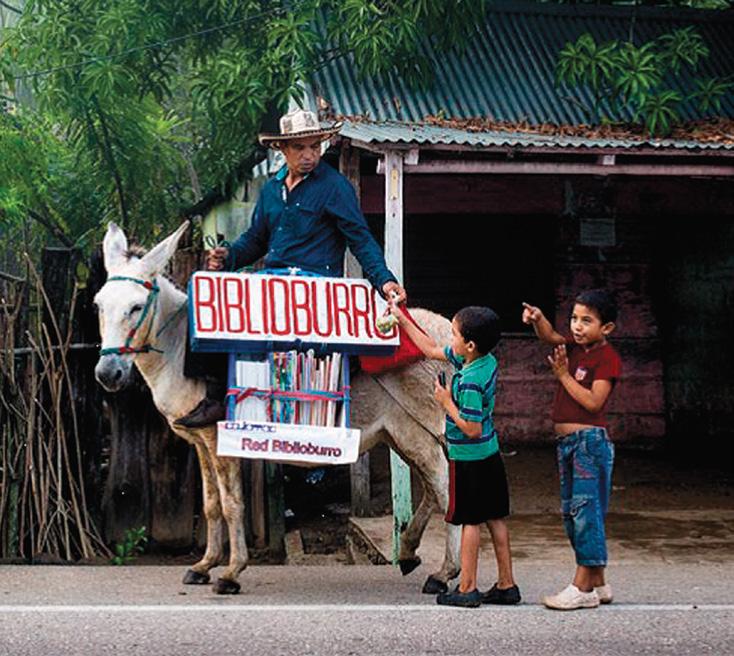
Los niños usan los libros para hacer las tareas.
El profe Luis viaja a muchos pueblos (towns).
Luis y su hermano están construyendo (building) una nueva escuela.
El pueblo donde vive Luis se llama La Gloria.
F
F
F
F
F
Mi progreso intercultural
I can compare my school to schools in Andean Spanishspeaking countries.
F
Mira la imagen del Biblioburro. ¿De qué trata el video?
Así se dice 2: Las profesiones en la escuela el/la consejero/a el/la enfermero/a el/la entrenador/a Además se dice el/la bibliotecario/a - librarian el/la cocinero/a - cook el/la director/a de la banda band director el personal de limpiezajanitors el/la profesor/a de arte - art teacher el/la secretario/a - secretary

Paso 3: Colaborar y compartir
Con un/a compañero/a piensen en una solución creativa para ayudar a las escuelas que no tienen una biblioteca. Escriban al menos dos ideas y compartan con la clase.
Actividad 7
¿Quién trabaja en un colegio?
Paso 1: Escuchar y escribir
Escucha las descripciones de varias personas que trabajan en un colegio. Escribe el vocabulario que corresponde con cada descripción.
Mi progreso comunicativo
I can recognize people who work at schools when their jobs are described.


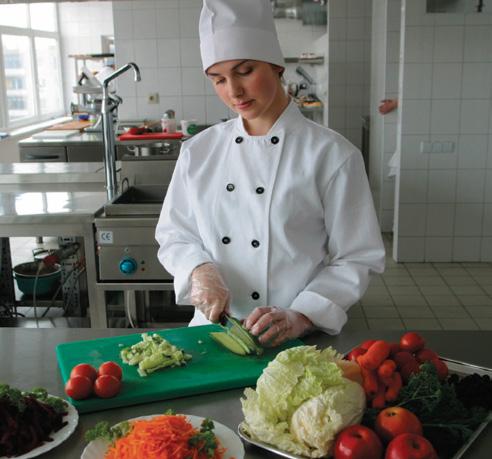
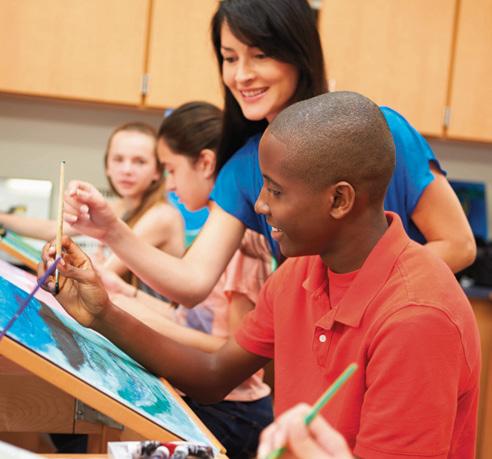



Paso 2: ¿Cierto o Falso?
a. Escucha las oraciones sobre tus profesores o sobre el personal que trabaja en la escuela.
b. Indica si cada oración es cierta o falsa. Si es falsa, escribe la información correcta.
Actividad 8

¿Qué asignaturas se ofrecen en los colegios?
Paso 1: Vocabulario


Lee la lista de asignaturas en Así se dice 3. Trabaja con un/a compañero/a para identificar los cognados y clasificar las asignaturas por temas.
• ¿Cuáles son cognados del inglés?









• ¿Qué otros cursos ofrece su colegio? Usen vocabulario que ya saben y busquen otras clases si necesitan.







Paso 2: Leer y conversar

















Mira el horario de Jorge, el primo de David y un alumno de secundaria en Ecuador. Después, con tu compañero/a, contesta las preguntas en la guía digital.
HORALUNESMARTESMIÉRCOLESJUEVESVIERNES
7:00 a
InformáticaMatemáticasQuímicaMatemáticasGeografía de Ecuador
InformáticaMatemáticasQuímicaInglésGeografía de Ecuador

Receso
Física Educación Cívica CastellanoBiologíaFísica
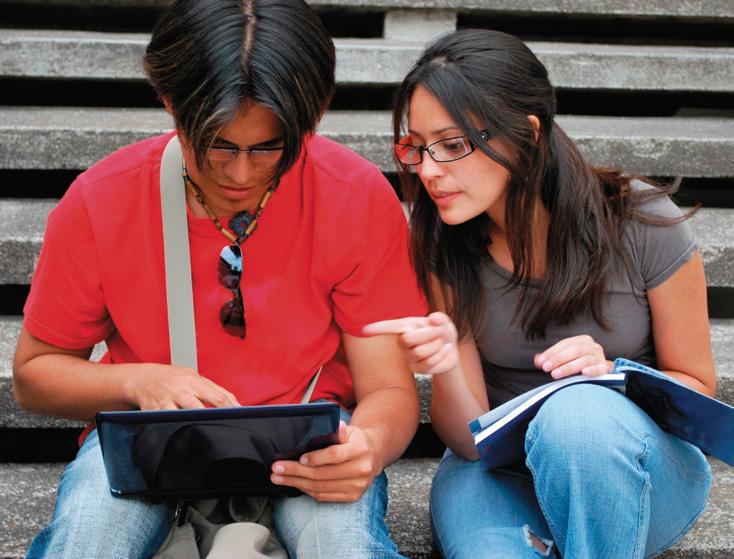
Educación Física Educación Cívica CastellanoBiologíaFísica
InglésGeografía de Ecuador GuitarraCastellanoBiología
Receso
InglésGeografía de Ecuador DibujoCastellanoBiología

QuímicaMetodologíaFísicaDibujoMetodología
QuímicaMetodologíaFísicaDibujoFísica
Así se dice 3: Las asignaturas Biología
Cálculo Danza Física Literatura Orquesta Trigonometría
Expresiones útiles
- primero/a - first
- segundo/a - second
- tercero/a - third
- cuarto/a - fourth
- quinto/a - fifth
- sexto/a - sixth
- séptimo/a - seventh
- octavo/a - eighth
Mi progreso comunicativo
can ask and answer questions about my class schedule.
Mi progreso intercultural
can compare my school schedule to a school schedule from a Spanishspeaking country.
Paso 3: Conversar
Conversa con un/a compañero/a sobre tu horario de clases este año, utilizando el organizador gráfico de tus clases en la guía digital
Modelo
Estudiante A: ¿Cuándo tienes la clase de Química?
Estudiante B: En la segunda hora.
Estudiante A: ¿A qué hora empieza?
Estudiante B: A las nueve menos diez.
Paso 4: Comparar
Utiliza el diagrama de Venn para buscar semejanzas y diferencias entre el horario de Jorge y tu horario. Considera el horario, cuántas clases tienen y cuánto tiempo duran las clases. Comparte tus ideas con un/a compañero/a.
¡Prepárate!
Mira el video en el cual Kuri Farinango habla de las nuevas asignaturas en su colegio, Sumak Yachana Huasi. Participa en el foro digital para debatir:
• ¿Cómo prepara este colegio a sus estudiantes para su futuro?
• ¿Por qué es importante una clase de Interculturalidad?
• ¿Qué asignaturas debe ofrecer una escuela ideal para preparar bien a sus alumnos?
Enfoque cultural
Práctica cultural: Variedad lingüística
The word “subjects” has a variety of words in di erent Spanish-speaking countries. Depending where you are you can use: materias or asignaturas.
Conexiones
Are there other words for “subjects” in English? Does this word change in college? Can you think of other examples?
El horario de clases de Jorge Mi horario de clases
De vuelta a clases
Actividad 9
¿Qué hacen todos en la clase?
Paso 1: Organizar tus ideas
Escribe una lista de verbos que describen lo que hacen los profesores y los estudiantes en las clases.
Los profesoresLos estudiantes hablar escuchar
Paso 2: Comparar
Compara tu lista con la lista de un/a compañero/a de clase. Añade la información que te falta (that you’re missing)
Paso 3: Observar y describir
Explica a tu compañero/a lo que hacen los estudiantes en las fotos.
Así se dice 4: Las actividades del aula
actuar analizar aprender de memoria bajar información del internet crear una página web debatir entrenar escribir ensayos grabar videos hacer experimentos hacer presentaciones hacer un proyecto investigar participar en concursos resolver problemas de matemáticas tocar un instrumento
Paso 4A: Expresar tu opinión
a. Completa el organizador gráfico con tus opiniones personales: ¿cuáles son las actividades en clase que te gustan mucho, las que te gustan sólo un poco o las que no te gustan?

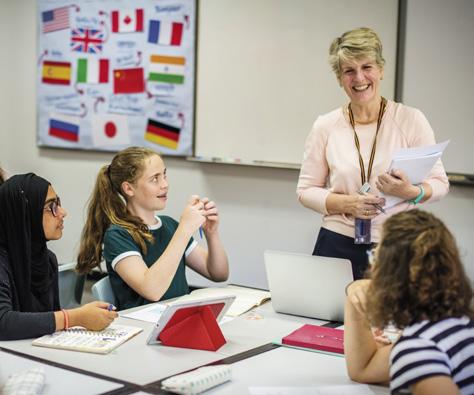

b. Menciona las actividades de Así se dice 4 y del vocabulario de Además se dice
No me gusta nada
Además se dice ensayar - to rehearse hacer una búsqueda en Internet - to do a search on the Internet
Recuerda: El verbo gustar
Gustar + verbo infinitivo
- ¿Te gusta hacer experimentos?
- Sí, me gusta investigar y hacer experimentos.
- A mi amigo no le gusta escribir ensayos, pero le gusta participar en concursos.
Me gusta mucho Me gusta Me gusta un poco No me gusta
Paso 4B: Compartir
a. Conversa con un/a compañero/a para compartir opiniones.
b. Responde a las preguntas de tu compañero/a usando la información de tu organizador gráfico como una guía.
Modelo
¿Te gusta debatir? (u otra actividad de la lista)
¿Qué te gusta mucho/un poco?
¿Qué no te gusta (nada)?
Actividad 10
¿Por qué te gustan o no te gustan las clases?



Paso 1: Escribir
a. Escribe las asignaturas de tu horario en el organizador gráfico.
b. Escribe por qué te gusta o no te gusta cada asignatura. Escribe las actividades que haces y adjetivos para describir esas asignaturas.
Me gusta la clase de…
No me gusta la clase de… (clase) (descripción) (clase) (descripción)



Biología Es interesante porque hago experimentos.
Recuerda: Para conjugar los verbos regulares -ar, -er, -ir
Drop ending.
Add the verb ending that corresponds to who is doing the action.
for conjugation of regular verbs in the present indicative
De vuelta a clases
Paso 2: Conversar y comparar


a. Pregúntale a tu compañero/a si le gustan las clases de su horario.
b. Responde a las preguntas que te hace tu compañero/a sobre tus clases.










c. Completa el diagrama de Venn con las semejanzas y diferencias de tus preferencias sobre las clases.
Modelo
Estudiante A: ¿Te gusta la clase de Álgebra?
Estudiante B: No, no me gusta la clase de Álgebra. La clase es aburrida porque resolvemos problemas de matemáticas.

Yo Nosotros Mi compañero/a Le gusta la clase de Historia Universal porque hace debates y presentaciones.
Mi progreso comunicativo

I can express preferences about classes and classroom activities.



Paso 3: Escribir
Escribe cuatro oraciones para describir las clases más interesantes de tu horario. Incluye:

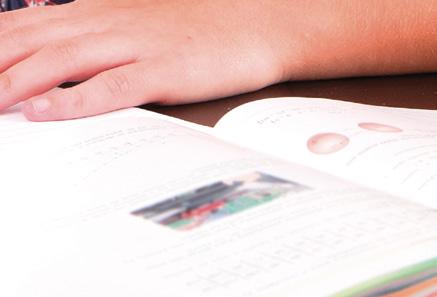



• ¿Qué clases te interesan más? ¿Por qué?
• ¿Qué tipo de actividades haces en las clases que te interesan?
Modelo

La clase de es interesante porque… En la clase de , nosotros… Me gusta la clase de porque…

Mi progreso intercultural
I can describe how technology meets the needs of students and creates learning opportunities.
Actividad 11
¿Cómo contribuye la tecnología a la educación?
Paso 1: Observar
Mientras miras el video “Escuelas del milenio” anota los tipos de tecnología que ofrece la escuela.
Paso 2: Leer y conversar

a. Hay una parte del video en la cual habla Gloria Vidal, Ministra de Educación. Lee un resumen de lo que dice abajo.

b. Conversa con un/a compañero/a:
• ¿Cómo describen a las comunidades antes de la construcción de las escuelas del milenio?
• ¿Qué mensaje lleva la tecnología a las comunidades?
Estas comunidades tradicionalmente han sido olvidadas ( forgotten ). Son comunidades que no tienen ni esperanzas ( hope ) de una buena educación, por ejemplo con la tecnología. Es llevar un mensaje ( to bring a message ) de esperanza a esas comunidades, decirles a las comunidades: Hoy en día la educación es para todos. Hoy en día la educación cohesiona ( unites ) al país. Hoy en día la educación cierra la brecha ( closes the gap ) económica y social en este país.
Reflexión intercultural
1. What technology does the school in this video offer that is similar or different from the technology you have access to in your school?
2. What advantages does technology provide students and teachers?
3. Do you believe that a lack of technology in schools creates a disadvantage for students?
4. How does providing access to technology give hope to communities that traditionally lack access in our technologydriven world?

De vuelta a clases
Actividad 12
¿Cómo son algunos profesores?


Paso 1: Vocabulario
Trabaja con un/a compañero/a y túrnense para identificar cada definición con la palabra en Así se dice 5.
a. es el profe que pide mucho de sus estudiantes; no puedes aprobar la clase sin trabajar mucho
b. es el profe que es imparcial y trata a todos igual
c. es el profe que pierde todo y no encuentra nada
d. es el profe que no se conecta mucho con sus alumnos
e. es el profe que escucha bien a sus alumnos y los comprende
f. es el profe que tiene alumnos preferidos y no trata a todos igual
g. es el profe divertido que hace a todos reír
h. es el profe que es muy bueno
i. es el profe animado, con mucha energía y pasión
j. es el profe que tiene todo preparado y listo para la clase
Paso 2: Escribir y hablar

a. Escribe tres oraciones positivas para describir a tres profesores.

b. Lee tus oraciones a un/a compañero/a.
c. Túrnese con un/a compañero/a para adivinar (guess) quién es. Modelo
Este profesor es entretenido y le gustan los deportes.
Enfoque cultural
Práctica cultural: El nombre del/de la profesor/a
In Spanish-speaking high schools, students can call their teacher “profe” which is short for “profesor.” You can also always call your teacher “profesor/a” or “maestro/a” depending on their gender.

Conexiones
What are respectful ways to get your teacher’s attention in English?
Así se dice 5
Para describir a los profesores amable comprensivo/a desorganizado/a dinámico/a distante entretenido/a exigente injusto/a justo/a organizado/a
Lo que hace un/a profesor/a animar a los estudiantes explicar repasar
Además se dice calificar - to grade dar ejemplos - to give examples evaluar - to evaluate
Mi progreso comunicativo
I can exchange information to describe my teachers.
Recuerda: El verbo ser y los adjetivos

The verb ser (tobe) is used to describe traits that generally do not change.

yo soy nosotros somos tú eres Ud. es vosotros sois Uds. son él/ella es ellos/ellas son
Remember to make adjectives agree with the noun(s) they are describing (feminine/ masculine, singular/plural).
• Mi amiga Julia es alta y simpática.
• Esteban es muy divertido.
• Mis hermanos y yo somos muy atléticos.
• Sara y Emilia son comunicativas con sus padres.
Actividad 13
¿Cómo son similares y diferentes tus profesores?

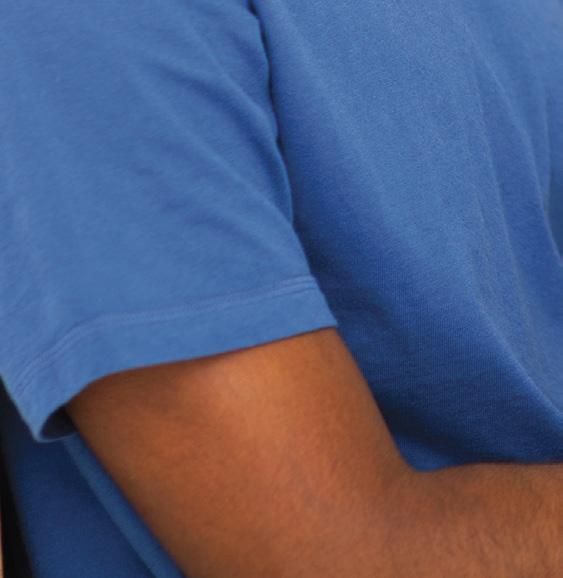




Paso 1: Describir
Añade una descripción de cada profesor(a) a tu organizador gráfico de Actividades 8 y 9.
Paso 2: Conversar
Entrevista a un/a compañero/a sobre sus profesores y escucha mientras los describe.
Modelo
Estudiante A: ¿Cómo se llama tu profesor/a?
Estudiante B: Es la profesora Harris.

Estudiante A: ¿Qué clase enseña?
Estudiante B: La clase de Biología.
Estudiante A: ¿Cómo es ella?
Estudiante B: Es una profesora muy creativa, pero no tiene mucha paciencia.
Observa 1


Making comparisons in Spanish
“Me gusta más la profesora de Álgebra, porque es más divertida que mi profesora de inglés.”
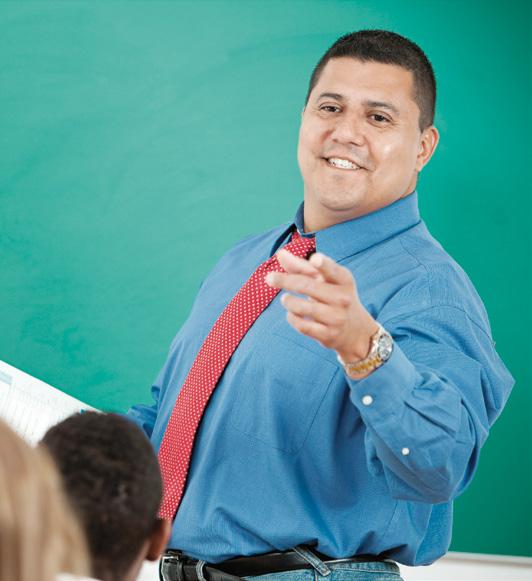

“La clase de inglés es menos interesante que las otras clases y es más difícil.”







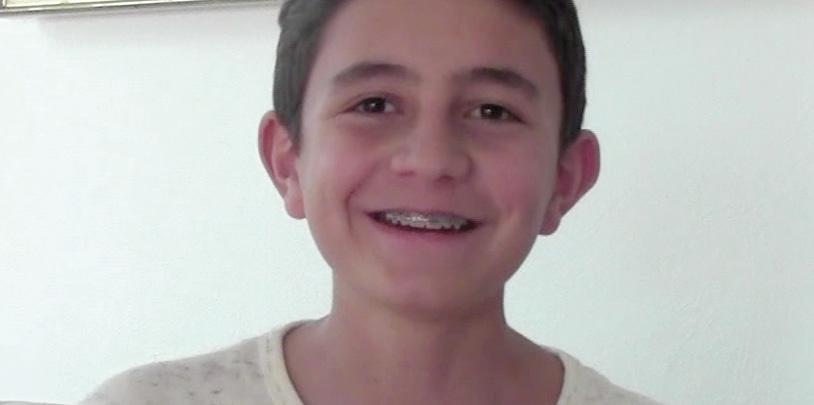
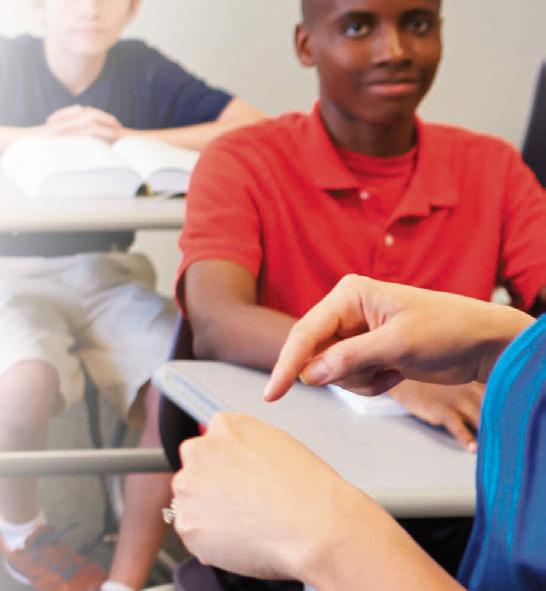
“Mi profesora de Español es tan divertida como mi profesora de Álgebra. Ellas dos hacen juegos en la clase con nosotros.”

¿Qué observas?
“ Mi profesor de Biología es tan estricto como mi profesor de Educación Física. No puedes hablar con amigos en ninguna de las dos clases.”
1. What language are David and Andrés using to describe differences and similarities between their teachers?
2. Discuss what you notice with a partner and note your observations on the graphic organizer you’ll find in Explorer.
Paso 3A: Escribir y compartir

¿Cómo son similares tus profesores? Escribe dos o tres semejanzas entre dos de tus profesores. Después comparte con tu compañero/a.
Modelo

Mi profesor(a) de… es tan como mi profesor(a) de…

Mi progreso comunicativo
I can draw comparisons between different people.
Detalle gramatical
Recuerda que la forma negativa es:
“Mi profesor de matemáticas no es tan… como… ”
Paso 3B: Conectar
Ahora escribe por lo menos tres oraciones en las cuales vas a comparar a tus profesores con los de tu compañero/a. Modelo
Mis profesores son más exigentes que los profes de David. También son más dinámicos porque tienen mucha pasión y energía.
Actividad 14
¿Cómo es el/la profesor/a ideal?
Paso 1: Imaginar y describir
Todo el mundo quiere tener un/a profesor/a ideal en su clase. Tu escuela está buscando a un/a profesor/a de español. Usa el organizador gráfico en la guía digital para pensar y escribir sobre las características del profesor ideal.

• ¿Qué cosas hace siempre un/a profesor/a ideal?
• ¿Qué cosas hace a veces un/a profesor/a ideal?
• ¿Qué cosas no hace nunca un/a profesor/a ideal?
Paso 2: Compartir y comparar
Con un/a compañero/a, compartan tus respuestas. ¿Qué ideas tienen en común? ¿Qué ideas son diferentes?
Paso 3: Escuchar y observar
El director de la Escuela del Milenio Sumak Yachana Huasi, Wilmer Santa Cruz, describe el papel (the role) de los profesores en su escuela.
a. Escucha la descripción de lo que hace el/la profesor/a (o docente) según el Sr. Santa Cruz.
Mi progreso intercultural
I can explain how teachers support student learning in different cultural contexts.
b. Conversa con tu compañero/a sobre esta pregunta: ¿Es similar o diferente al papel de los profesores en tu escuela?
Reflexión intercultural
1. What do you think about the role of teachers at the bilingual schools in Ecuador?
2. Is this similar or different to the role of teachers in your school?
3. How has watching this video helped broaden your perspective of what teachers do in classrooms around the world?
De vuelta a clases
Paso 4: Escribir un correo electrónico
Escribe un correo electrónico al director de tu escuela para explicar las características de dos profesores excelentes en tu escuela.
a. Elige dos de tus profesores favoritos.
b. Describe a los profesores y explica por qué son buenos.
c. Utiliza las Expresiones útiles para una comunicación formal.

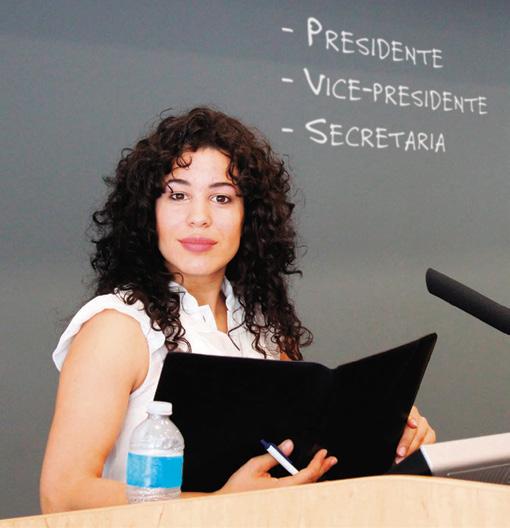
Modelo
El profesor Bedregal es uno de mis profesores favoritos. Es mi maestro de Trigonometría este año. Es paciente, tranquilo e inteligente.
Actividad 15
¿En qué actividades extracurriculares participas o quieres participar?
Paso 1: Escuchar y adivinar
Escucha a varios amigos de David en Ecuador hablar sobre las actividades extracurriculares que les interesan. Para cada uno, señala la imagen que corresponde.
Expresiones útiles Saludos y despedidas formales
Estimado señor…/Estimada señora… - Esteemed Sir…/ Madam






Buenos días, - Good morning Atentamente, - Sincerely Saludos, - Regards
Mi progreso comunicativo
I can describe the attributes of an ideal teacher.
Así se dice 6: Las actividades extracurriculares
el club de ajedrez
el club de periodismo (escribir para el periódico)
el equipo de natación el gobierno estudiantil formar parte de un equipo/ club
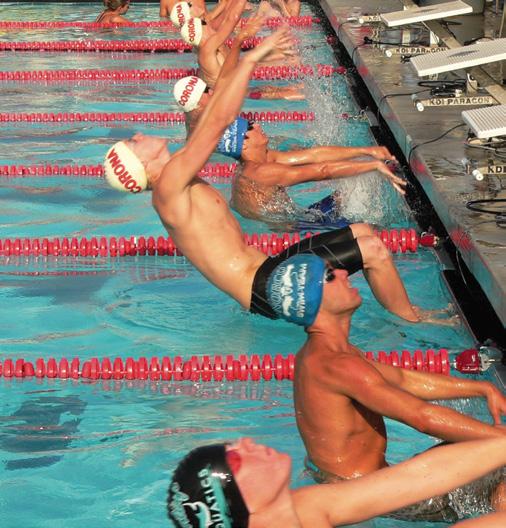
hacer atletismo

jugar en un partido de… participar en una función de teatro
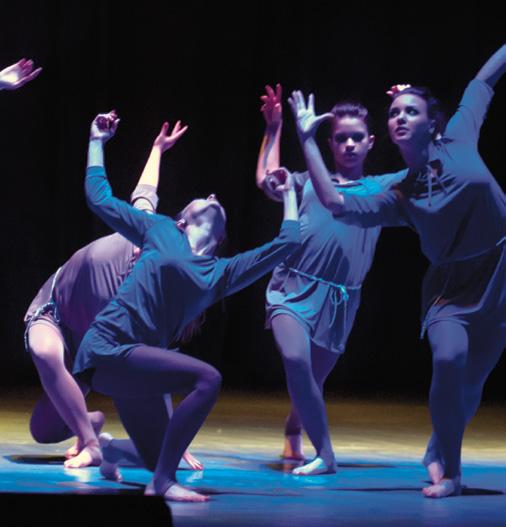

Mi progreso comunicativo
I can identify extracurricular activities when I hear them described.
Paso 2A: Escuchar y nombrar
Escucha las descripciones por segunda vez y encuentra el nombre de la actividad en la lista de Así se dice 6. Verifica tus respuestas con un/a compañero/a.
Modelo
Estudiante A: Está describiendo el club de…
Estudiante B: Sí, es una descripción del club de… No, creo que es una descripción del club de…
Paso 2B: Vocabulario
Mira las imágenes del Paso 1 y conversa con tu compañero/a.
• ¿Qué actividades extracurriculares ofrece tu colegio?
• ¿Qué otras actividades debe ofrecer tu colegio?

Modelo
Nuestro colegio ofrece…
Nuestro colegio debe ofrecer…
Quiero un club de… en nuestro colegio.
Paso 3A: Conversar
Con un/a compañero/a, conversen de las actividades extracurriculares que les gustan.
a. Empiecen con las siguientes preguntas. Pueden hacer sus propias preguntas también.
• ¿En qué actividades extracurriculares participas?

• ¿Por qué te interesa ?
b. Anota la información de tu compañero/a para compartir con la clase después.
Paso 3B: Presentar
Comparte lo que ahora sabes de tu compañero/a.
Modelo
Mi compañero/a es miembro de… / Mi compañero/a participa en…
A le gusta… / A le interesa…
Paso 4: Presentar
La administración de tu colegio necesita dar la bienvenida a un grupo de estudiantes de Ecuador que van a visitar pronto. Necesitan explicar las actividades extracurriculares del colegio. Elige una actividad extracurricular en que participas o que te interesa y escribe una breve descripción para ser incluida en la guía de orientación:
1. ¿Qué actividad es?
2. ¿En qué época del año se reúne o entrena el grupo? ¿Todo el año o ciertos meses o estación (season)?
3. ¿Qué días de la semana se reúne o entrena el grupo? ¿A qué hora?
4. ¿Quién es el entrenador/coordinador?
5. ¿Qué hacen en las reuniones/prácticas?
Actividad 16
¿Por qué son importantes las actividades extracurriculares?

Paso 1A: Leer y conversar
a. Lee este fragmento de una entrevista con el director del Colegio Montfort, en Madrid.
“Creemos que la formación del ser humano va más allá de la mera instrucción [académica]. Nosotros creemos que el aprender música, el aprender danza, el desarrollarse deportivamente en el tenis, en el baloncesto, en el fútbol, en la natación es un aporte* que complementa ya casi en un cien por cien la formación integral que queremos dar a los alumnos en el colegio”.



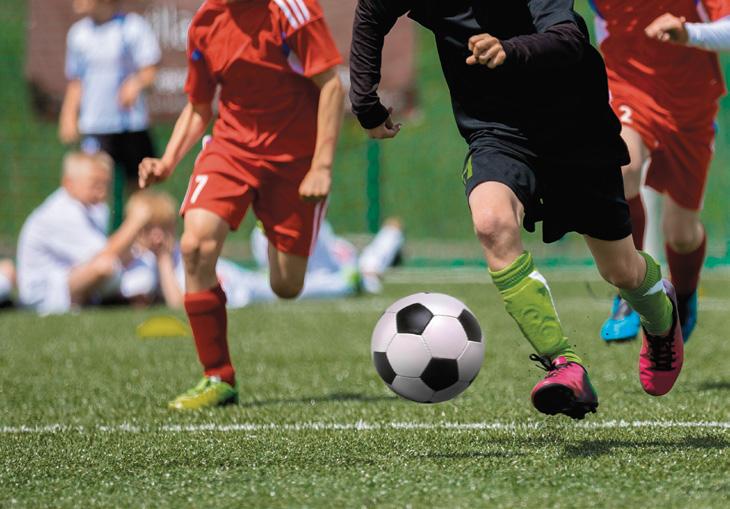
*contribución Wilmer Santa Cruz, Colegio Montfort y Madridiario. (2014). Las actividades extraescolares: un refuerzo para la educación integral
b. Conversa con un/a compañero/a:
¿Qué actividades extracurriculares ofrece el colegio?
•¿Por qué dice que son importantes las actividades extracurriculares?

clases
Paso 1B: Conexión personal
¿Cómo te ayudan las actividades extracurriculares a desarrollar tus habilidades? Elige dos o tres actividades en que participas o quieres participar y escribe los beneficios para ti.

Modelo
No soy muy sociable. Participo en el club de debate y es bueno para mí porque aprendo a hablar enfrente de otras personas y comunicar mis ideas.
Paso 1C: Conversar y compartir
Conversa con un/a compañero/a sobre los beneficios de sus actividades extracurriculares y comparte los beneficios de tus actividades. Después comparte la información sobre tu compañero/a con la clase.

Modelo
Mariana participa en el club de periodismo. Ella aprende como escribir mejor, organizarse y trabajar con fechas límites (deadlines)
Paso 2A: Mirar por primera vez y anotar
Mientras miras el video sobre las actividades que se ofrecen en el Colegio Montfort, un colegio privado en Madrid, España, haz una lista de las actividades extracurriculares que ves en la primera columna.
Actividades extracurriculares
¿Cómo ayudan estas actividades a los estudiantes?

De vuelta a clases
Paso 2B: Mirar por segunda vez y anotar
Al mirar el video por segunda vez:
a. Enfócate en la importancia de las actividades extracurriculares.
b. Completa la segunda columna del organizador gráfico.
Paso 2C: Conversar







Con un/a compañero/a, compartan sus listas e ideas. Después conversen sobre las siguientes preguntas:







• ¿Qué actividades extracurriculares son más costosas para un colegio? ¿Cuáles son más baratas (cuestan menos)?






• ¿Piensas que todos los colegios deben ofrecer muchas actividades como el Colegio Montfort? ¿Por qué?
¡Prepárate!
Los colegios necesitan ayudar a sus estudiantes considerando los lugares donde viven y sus necesidades. Participa en el foro digital contestando estas preguntas:



• Piensa en las actividades extracurriculares de tu colegio. ¿Cómo preparan a los estudiantes para su futuro?
• En tu opinión, ¿cuáles son las actividades extracurriculares que debe ofrecer una escuela ideal?

Mi progreso comunicativo
I can give opinions about what extracurricular activities schools should offer.


Mi progreso intercultural
I can give examples of what schools include and offer that meets their students’ needs.
Quito, Ecuador

En camino A
¡Bienvenidos a nuestro colegio!
You have been paired with a student from a high school in Ecuador. This exchange student will be arriving at your school soon for an exchange program, and he/she needs to be prepared. First you want to learn a bit about his/her home school so you can better understand what the student might be expecting in a new school. You will also receive an email from your exchange student asking you a few questions about your school. In the end, you decide to put together a little “¡Bienvenido/a a nuestro colegio!” resource to help him/her learn basic information about the school, classes and teachers awaiting his/her arrival!
Paso 1: Leer y comparar
Read the pamphlet with information about your exchange student’s home school. Complete notes and a Venn diagram about the school building, classes offered, course descriptions, teacher profiles and extracurricular activities. Compare the student’s home school with your own.
Paso 2: Leer y escribir
Read the email you have received in Explorer from the exchange student who will be living with your family as part of the exchange program. Respond to the questions he asks about your school.
Paso 3: Diseñar y presentar
Create a resource that presents important basic information about your school for your exchange student. Include the following:
1. a list of the important places in your school
2. a schedule this student might have
3. descriptions of two engaging classes the student will take

4. teacher profiles to describe two of his/her future teachers
5. a list of extracurricular activities your school offers: give information about at least two extracurriculars, detailing where and when they meet and/or practice
6. at least four comparisons between your school and your exchange student’s school in Ecuador, describing what is similar and different.
Vocabulario
Así se dice 1: Las partes de la escuela el campo deportivo - sports field la cancha de… (tenis) - court los casilleros - lockers el laboratorio de… - laboratory el teatro - theater

Así se dice 3: Las asignaturas
Biología - biology
Cálculo - calculus
Danza - dance Física - physics

Literatura - literature
Orquesta - orchestra
Trigonometríatrigonometry
Así se dice 2: Las profesiones en la escuela el/la consejero/a - school counselor el/la enfermero/a - nurse el/la entrenador/a - coach; trainer
Síntesis de gramática
To make comparisons: You can compare adjectives, adverbs, and nouns that are similar or different.
To compare differences between people or things use: más… que or menos… que
Así se dice 5: Para describir a los profesores amable - nice comprensivo/aunderstanding desorganizado/adisorganized dinámico/a - dynamic distante - distant
entretenido/aentertaining exigente - demanding injusto/a - unfair justo/a - fair organizado/aorganized
Así se dice 6: Las actividades extracurriculares el club de ajedrez - chess club el club de periodismo (escribir para el periódico) - journalism club (write for the school newspaper) el equipo de natación - swim team el gobierno estudiantil - student government formar parte de un equipo/club - to be part of a team/club hacer atletismo - to do track jugar en un partido de… - to play in a game of/ in a match of participar en una función de teatro - to participate in a theatre performance
Expresiones útiles
Saludosydespedidas—formales


Estimado señor… /Estimada señora… Esteemed Sir/Madam, Buenos días, - Good morning, Atentamente, - Sincerely, Saludos, - Regards,
Así se dice 4: Las actividades del aula actuar - to act analizar - to analyze aprender de memoria - to memorize bajar información del internetdownload information from the Internet crear una página web - to create a web page debatir - to debate entrenar - to train escribir ensayos - to write essays grabar videos - to record videos hacer experimentos - to do experiments hacer presentaciones - to do presentations hacer un proyecto - to do a project investigar - to research participar en concursos - to participate in contests resolver problemas de matemáticas - to solve math problems tocar un instrumento - to play an instrument
• If you want to compare nouns: Hay más chicos que chicas en la clase de la profesora Polanco. Tengo menos tarea que mi hermano que está en el sexto grado
• If you want to compare adjectives:
¡El profesor de Biología es más creativo que el profesor de Arte! El director de la escuela es menos simpático que la subdirectora.
To compare adjectives that are the same use: tan… adj… como
• Yo soy tan atlético como mi hermana mayor. Mi madre es tan simpática como mi padre.
Saludosydespedidas—informales

Querido/a … - Dear…, Hola, - Hello, Adiós, - Goodbye, Chao, - Bye, Besos, - Kisses,

Comunica y Explora B
Un ambiente escolar que facilita el éxito académico

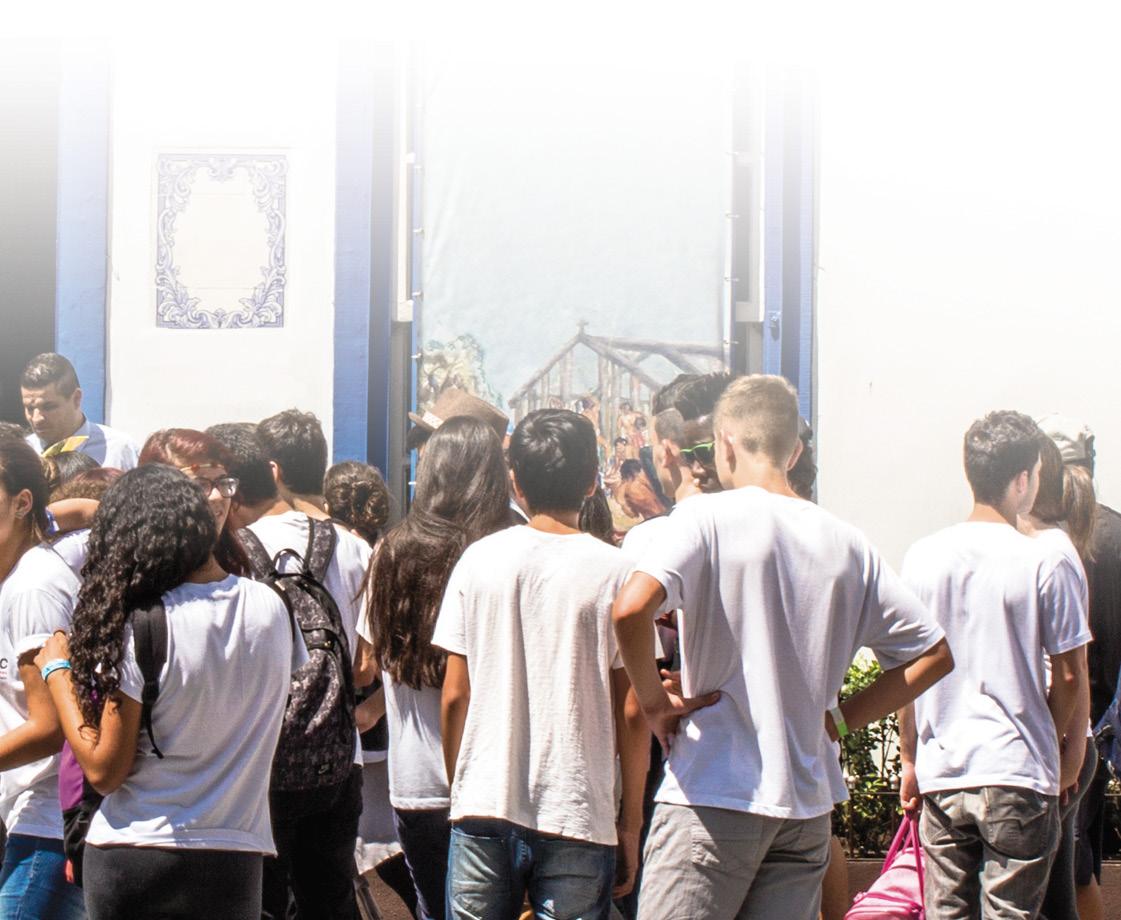

Pregunta esencial: What factors support student learning and success?
Así se dice 7: Las evaluaciones y las tareas
How are students evaluated and how can they be successful in school? Learn to give advice about study habits.
Observa 2: Expressing obligation

Learn how to say what people “have to” or “must” do.
Así se dice 8: Las reglas en la escuela 43
What rules must you follow in school and why are these rules important? Learn to give examples of how upholding school rules impacts student learning
Así se dice 9: El ambiente de la escuela 47
How do students and teachers create a positive classroom environment and how does that impact learning? Learn to explain cause and effect between what actions we take and our school environment.

En camino B: Cómo tener éxito en tu escuela
Incorporate everything you’ve learned in this section to orient visiting students to the evaluation system and rules of your school. How can they be successful?

Síntesis de gramática y vocabulario
De vuelta a clases
Actividad 17
Paso 1: Reflexionar y compartir




Primero escribe tus respuestas a las siguientes preguntas. Después, con un/a compañero/a compartan sus respuestas.

















• A todos los estudiantes les interesa tener éxito (to be successful) en la escuela. ¿Cómo sabes que tienes éxito en tus clases?






• ¿Es importante para tu familia tu éxito en la escuela? ¿Cómo sabes?


• ¿Por qué es importante para ti tener éxito en la escuela?




Así se dice 7: Las evaluaciones y las tareas aprobar un examen/una clase las calificaciones dar un examen los deberes




evaluar (la evaluación) pedir ayuda reprobar un examen/una clase sacar una buena o mala nota
tener éxito tomar un examen





¿Cómo sabes si tienes éxito en la escuela?
¡Tengo éxito!
Estrategias
Interpretive Listening and Reading
Sometimes it can be overwhelming to read or listen to something in Spanish. We often get distracted by the information we don’t understand and it prevents us from making sense of what we have the skills to comprehend. Here are some strategies to help you when listening and reading in Spanish:
• Listen and look for words you already know.
• Make predictions from titles and images that can give you clues.
• Listen or look for cognates.
• Use context to guess the meaning of what you see or hear.
• Visualize what you see or hear to create a mind movie.
Watch the listening and reading strategies video in Explorer for more tips to help you understand spoken and written Spanish.

Paso 2A: Leer y escribir
Lee el cuento sobre Andrés, un amigo del colegio de David. Utiliza las imágenes de la página anterior para entender el vocabulario nuevo de Así se dice 7.
Es miércoles y como siempre, Andrés llega al colegio sin hacer los deberes. Sus profes no están contentos con él. Le dicen casi todos los días que sus cali caciones van a ser malas si no empieza a estudiar más. Andrés está triste también porque quiere ser veterinario un día y necesita aprender y tener éxito en todas las asignaturas si quiere ir a la universidad.
Hay una evaluación hoy en la clase de Biología pero Andrés no tiene miedo porque es sobre los animales. Le gustan mucho los animales y presta mucha atención en esta clase. Por eso no necesita estudiar. Su profe evalúa a los alumnos por escrito y oralmente. Cuando Andrés da exámenes en esta clase, siempre saca buenas notas.
En sus otras clases reprueba muchos exámenes pero no en Ciencias. Aprueba todos los exámenes de Ciencias porque son importantes para su futuro. ¡Menos mal que los profesores de sus otras asignaturas no le toman un examen hoy!
Paso 2B: Conversar y justificar
a. Conversa con un/a compañero/a y respondan a las siguientes preguntas.
b. Busquen evidencia en el texto para justificar sus respuestas.
1. ¿Qué día es?
2. ¿Por qué están enfadados con él los profesores de Andrés?
3. ¿Qué va a pasar si Andrés no empieza a trabajar?
4. ¿Cuál es la profesión que le gusta a Andrés?
5. ¿En qué clase tiene una evaluación hoy?
6. ¿Cómo evalúa su profe de Ciencias?
7. ¿En qué clase aprueba los exámenes casi siempre y por qué?
Enfoque cultural
Práctica cultural: Dar un examen vs. tomar un examen


Several countries in South America, including Argentina, Chile, Ecuador, Peru, and Uruguay, use the term “dar un examen” when a student takes a test, and the term “tomar un examen” when a teacher gives a test to students.

At the same time, in Spanish you would say that the student “saca buenas/malas notas”, gets good/bad grades, which means the student earns the grades. You would never say, “La profesora me da una F en el examen” (The teacher gives me an F on the exam), you would say, “Yo saco una F en el examen.”
Conexiones
How do you think these di erences in language re ect how students take responsibility for their learning in Latin American countries?
Paso 3: Practicar con el vocabulario

Decide cuál de estas explicaciones o sinónimos corresponde con los términos de vocabulario de Así se dice 7.
1. no tener la nota aceptable para pasar 4. la tarea
2. tener una nota aceptable para pasar 5. las notas
3. tener entre el 0 y el 100% 6. un examen
¡Prepárate!
Los estudiantes de Ecuador necesitan saber cómo es el sistema de evaluación en tu colegio para tener éxito durante su tiempo en la escuela.
a. Utiliza el vocabulario de Así se dice 7 para explicar cómo los profesores en tu escuela evalúan a sus estudiantes.
b. Explica en dos oraciones: ¿Qué haces para preparar tus evaluaciones?
Guayaquil, Ecuador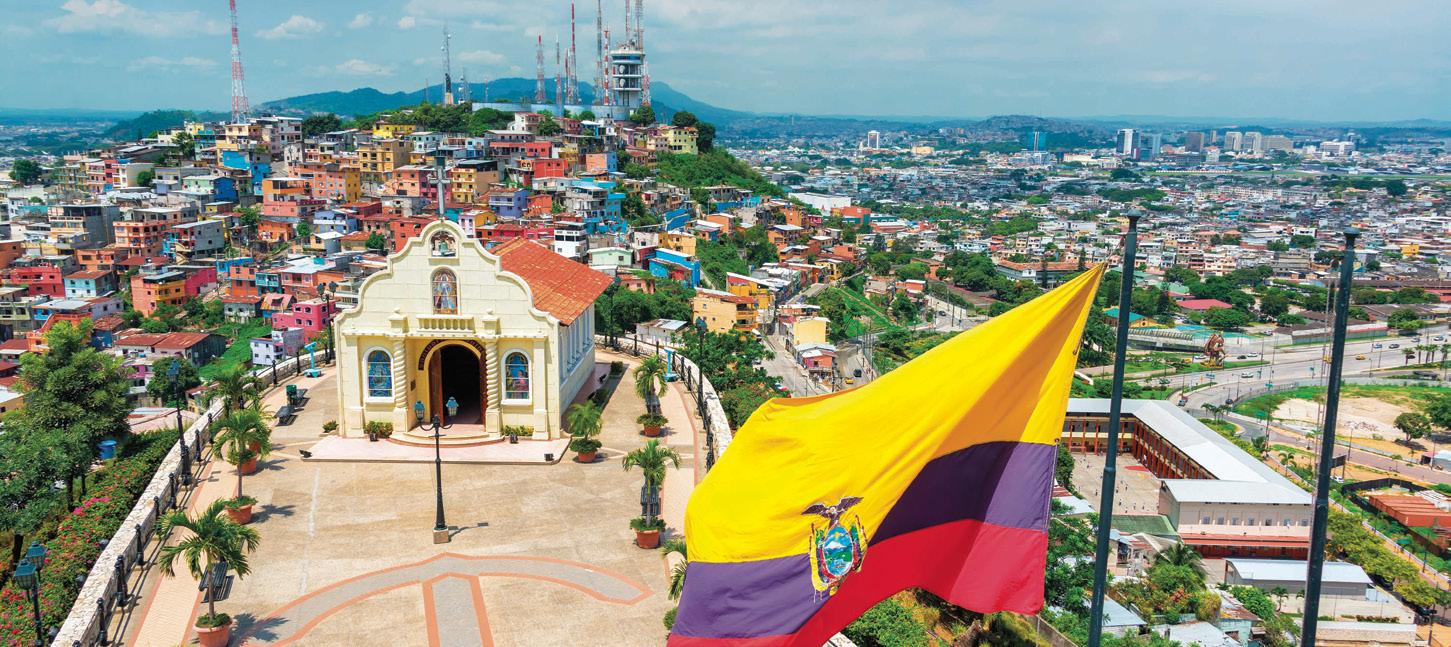
Recuerda: Los verbos que cambian de raíz
Do you remember the pattern for stem-changing verbs?
Why does reprobar change?

• “En sus otras clases reprueba muchos exámenes…”
Why does aprobar change?

• “Aprueba todos los exámenes de Ciencias…”

Mi progreso comunicativo
I can recognize ways to be successful in school from someone speaking about the topic.
Actividad 18
¿Qué necesitas hacer para sacar buenas notas?
Paso 1A: Conversar:
Entrevista (interview) a tu compañero/a con las siguientes preguntas. Toma apuntes de sus respuestas.
Estudiante A
1. ¿Qué haces para organizar tus deberes y materiales para estudiar?
2. ¿Cuánto tiempo estudias para una evaluación?
3. ¿En qué clases tienes muchos deberes?
Estudiante B
1. ¿Qué haces cuando vas a tener una evaluación en una clase?

2. ¿En qué asignatura tienes buenas calificaciones siempre? ¿Por qué?
3. ¿Qué asignatura evalúa más frecuentemente?
Paso 1B: Escribir y presentar
Prepárate para compartir con la clase la información que sabes ahora de tu compañero/a. Escribe cuatro oraciones sobre sus hábitos de estudio.
Paso 2A: Observar
a. Escucha a David mientras habla de sus notas y cómo tener éxito en su escuela.
b. Anota lo que escuchas sobre los siguientes temas:
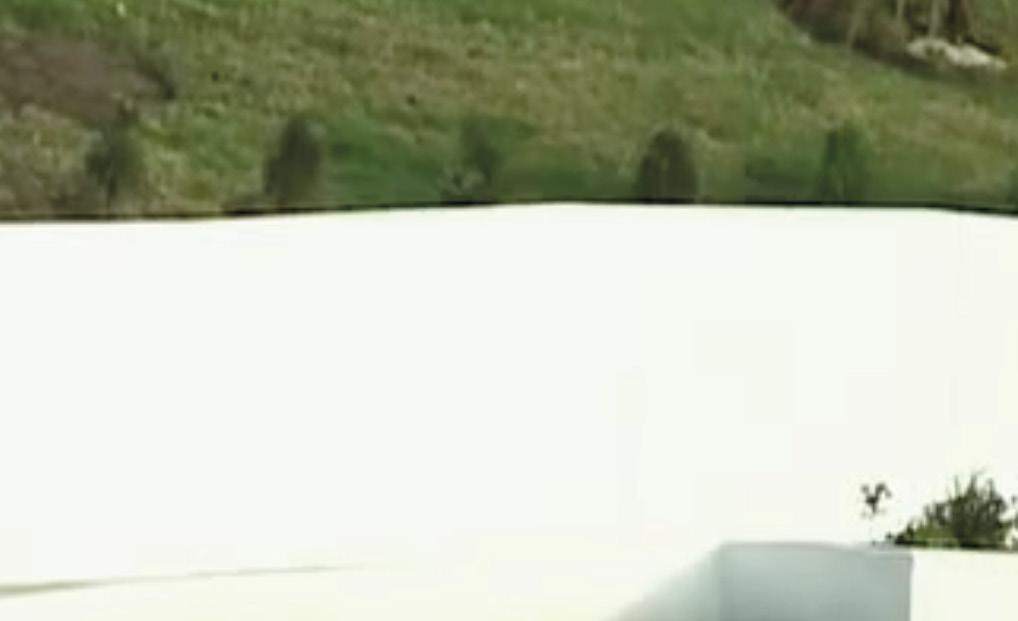
• las materias que le gustan y no le gustan a David
• cómo son las notas en su escuela
• qué tiene que hacer un estudiante en su escuela para sacar buenas notas

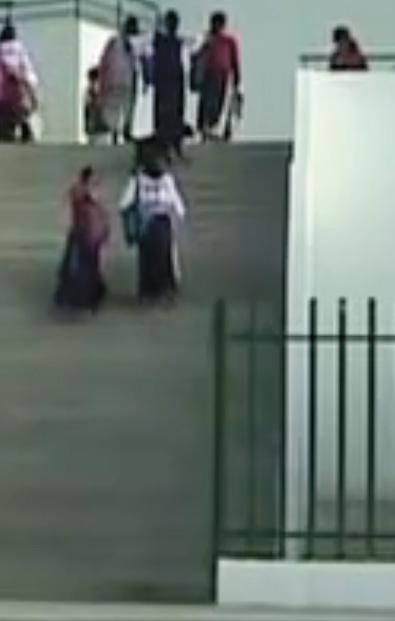
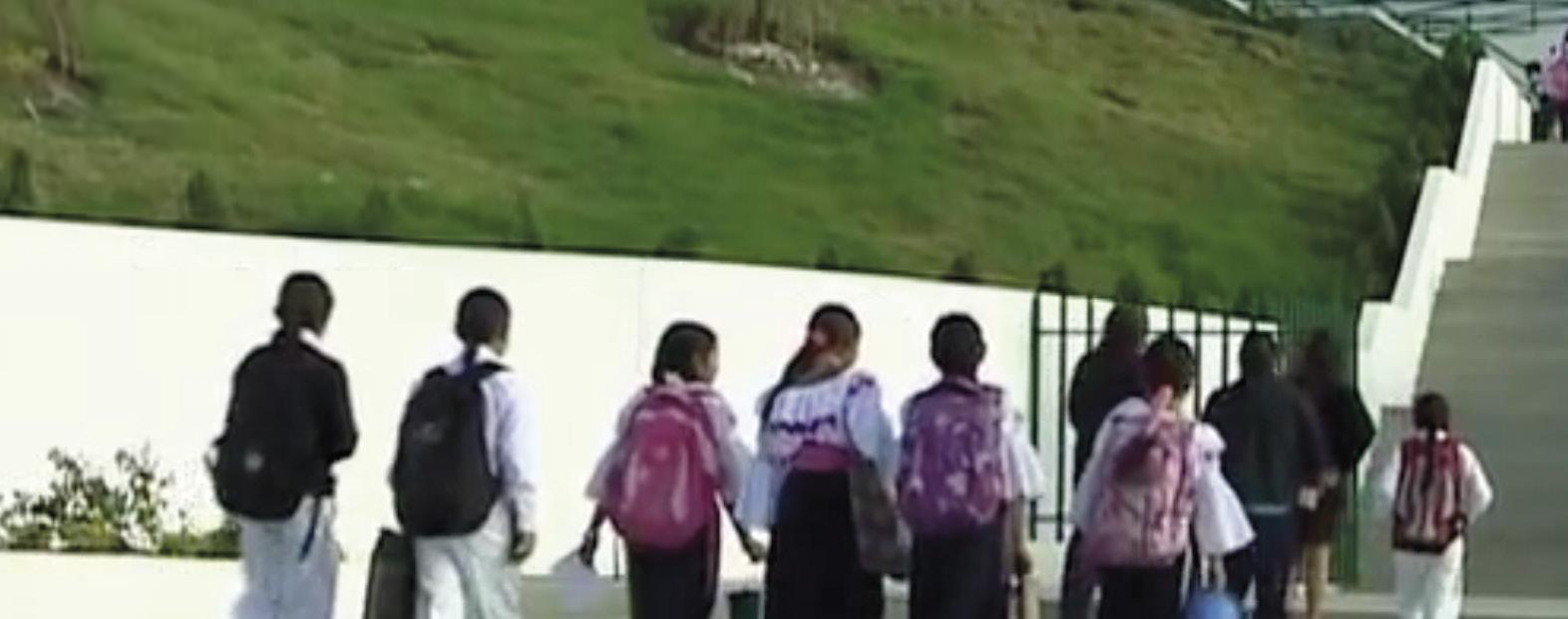
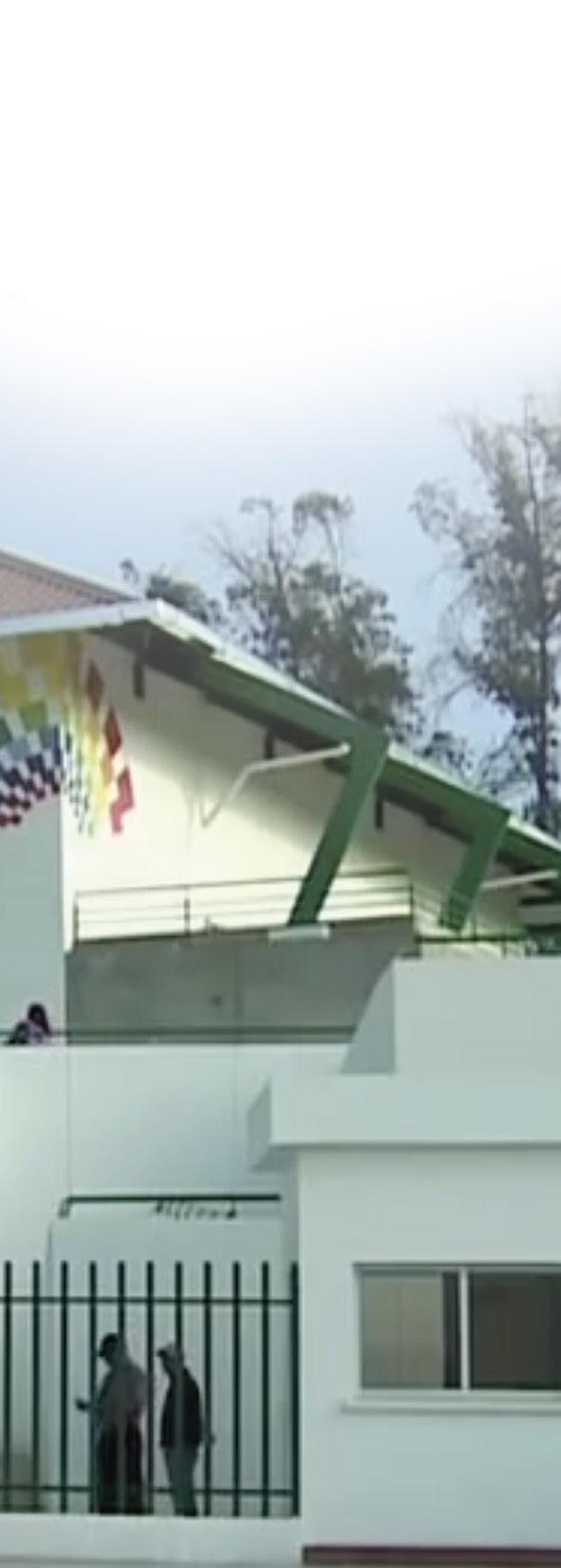
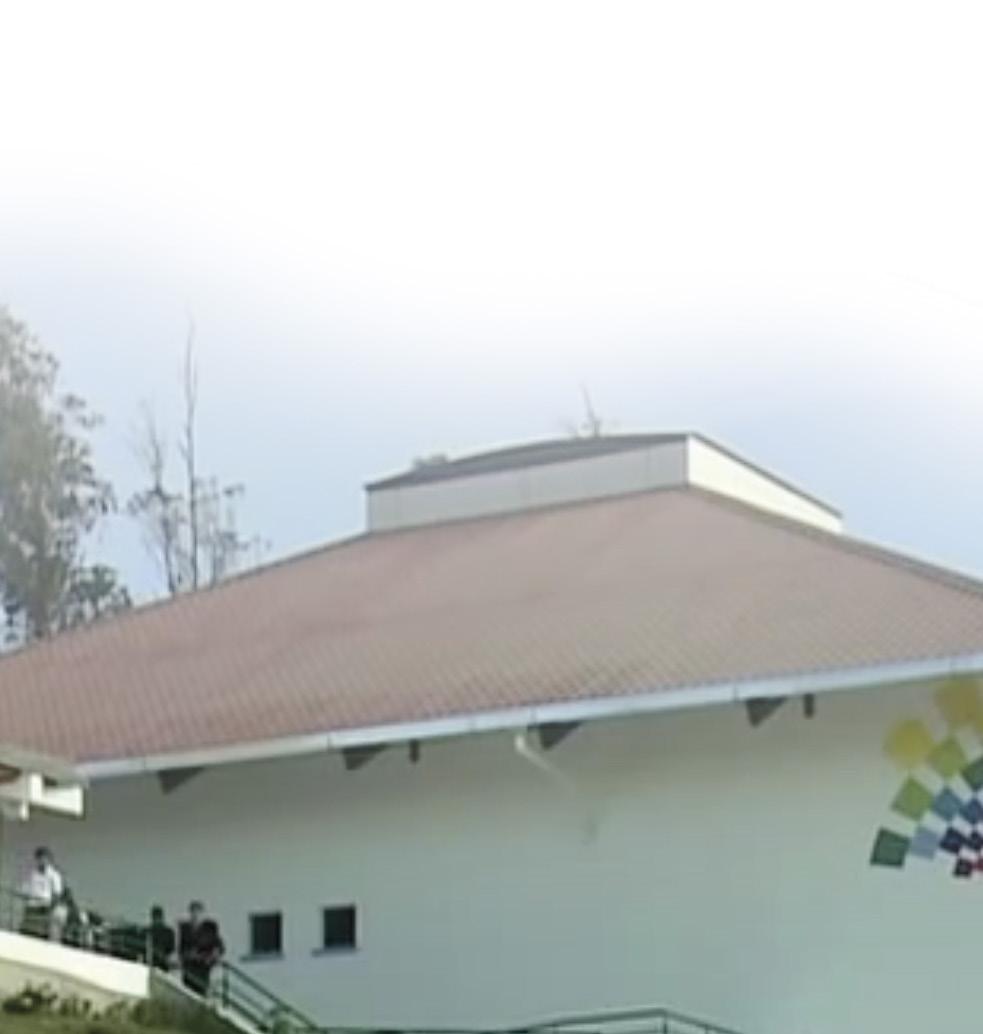

De vuelta a clases
Paso 2B: Conversar
Con un/a compañero/a, hablen sobre estas preguntas:
1. ¿Cuál de sus materias (asignaturas) le gusta más a David y por qué?
2. ¿Cuál de las materias le gusta menos a David y por qué?
3. ¿Sobre cuánto (out of what number) son las notas en su colegio?
4. ¿Con qué nota aprueba una materia?
5. ¿Cuántas oportunidades tiene para aprobar una materia?
6. ¿Qué pasa si no aprueba una materia?
Paso 3A: Comparar
Utiliza el diagrama de Venn para comparar las evaluaciones en tu colegio con el de David.
Evaluaciones en mi colegio Evaluaciones en el colegio de David
Paso 3B: Hablar en grupo
a. Conversa con tus compañeros en un grupo pequeño sobre las siguientes preguntas.
b. Justifica tus respuestas con ejemplos de tu escuela y de la escuela de David.
•
•
•
¿En qué se parecen (son similares) los dos colegios?
¿Qué diferencias hay entre los dos sistemas de evaluación?
¿En qué colegio es más difícil aprobar una materia?
Enfoque cultural
Práctica cultural: El uso de tecnología para tener éxito en la escuela
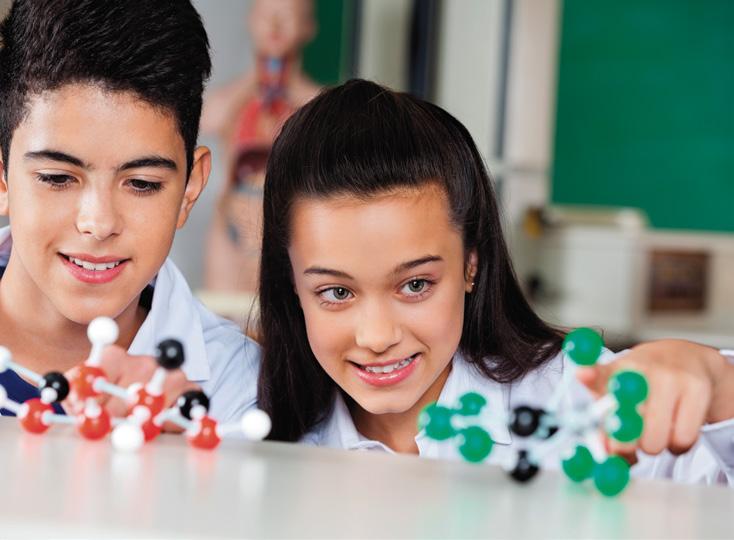
When students in Latin America have smartphones, many develop ways to use their phones to help stay organized and motivate them to study and get good grades. Watch this student explain her methods and come up with your own!
Conexiones
How can technology hinder us from getting good grades? How can it help?

Mi progreso intercultural
I can describe how students in different countries view success in school.
Observa 2

Expressing obligation



Mi profesora de Química es la Sra. Ramirez. Era tu profe el año pasado, ¿no? ¿Qué hayque hacer para sacar buenas notas en su clase?






¿Qué observas?
Tienes que hacer los deberes todos los días porque la clase es muy difícil. También debes llegar a tiempo a su clase.

1. What do you notice about the words in bold used to talk about what students “have to” or “should” do to be successful in their classes?
2. Discuss what you notice with a partner and note your observations on the graphic organizer you’ll find in Explorer.

¡Prepárate!

Una nueva estudiante de Ecuador, Elena, te va acompañar a tus clases mañana para conocer mejor a los profesores y aprender cómo puedes tener éxito en las clases este año escolar. Al final del día Elena te llama para hacerte unas preguntas sobre el éxito escolar.


a. En la guía digital, escucha sus preguntas.
b. Después graba una respuesta en que le ofreces consejos (advice) para tener éxito.
Modelo


Elena: ¿Qué necesito hacer en la clase de Ciencias para sacar una buena nota?

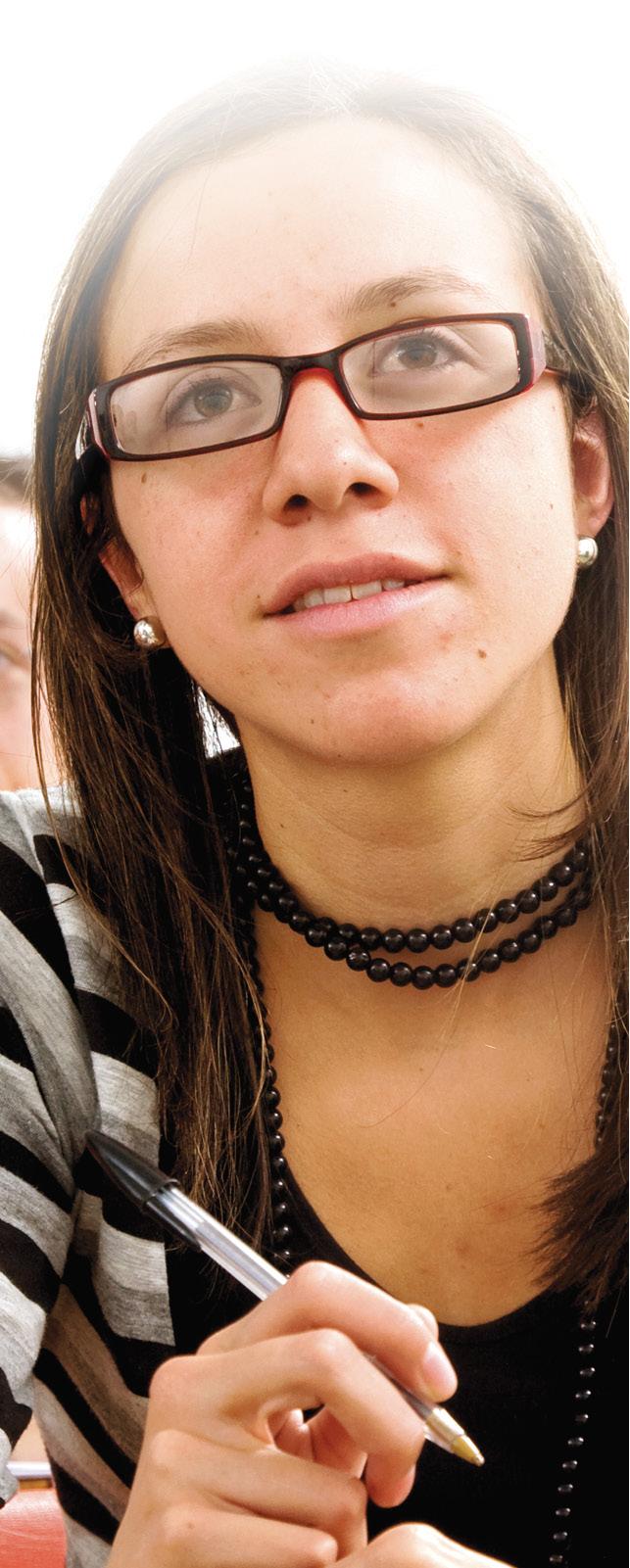
Tú: Siempre hay que hacer los deberes y prestar atención al profesor durante las lecciones. También debes escribir apuntes y hacer preguntas si no entiendes algo.




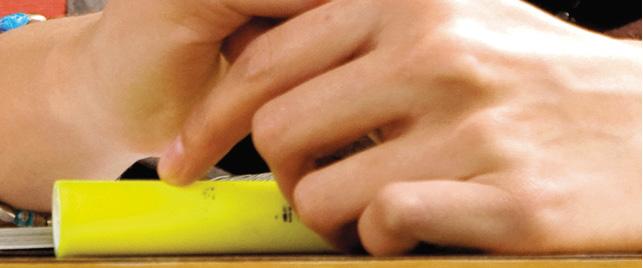
Mi progreso comunicativo


I can explain how to be successful in school.
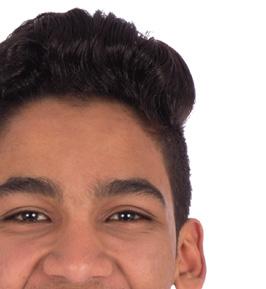
Actividad 19
¿Sigues las reglas en tu escuela?
Paso 1A: Emparejar


Todas las escuelas y clases tienen reglas (o normas) para crear un ambiente positivo y productivo. Tenemos normas porque queremos una estructura en la escuela para poder aprender bien y tener éxito.






Mira la columna a la derecha. ¿Cuáles son las normas en tu escuela?












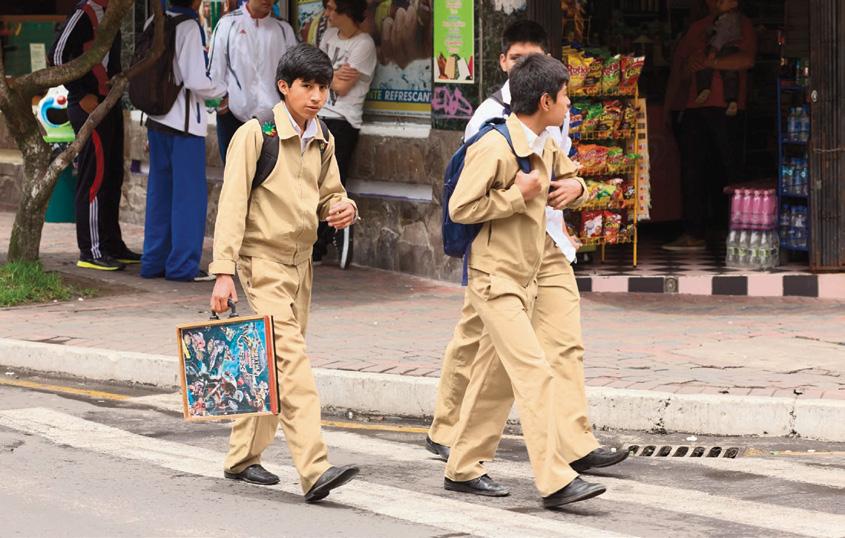
Empareja las siguientes frases con la palabra correspondiente.
clase comienza a las 8:00 a.m.


contestar una pregunta
sacar buenas notas
ir al baño

en las clases de Álgebra, Español, Historia
a los profesores y compañeros
los libros y materiales



Así se dice 8: Las reglas en la escuela cuidar el salón y los materiales
a clases
permiso para

cumplir con las tareas prestar atención
levantar la mano

cuidar





respetar
pedir permiso
cumplir con la tarea
prestar atención


llegar a tiempo
llegar a tiempo respetar
Enfoque cultural Producto cultural: El uso de los uniformes escolares
In Latin America school uniforms are just as common in public schools as in private schools. Generally public school uniforms are very simple; the students wear navy blue or beige pants or skirts, and white shirts. Private school uniforms are more sophisticated.
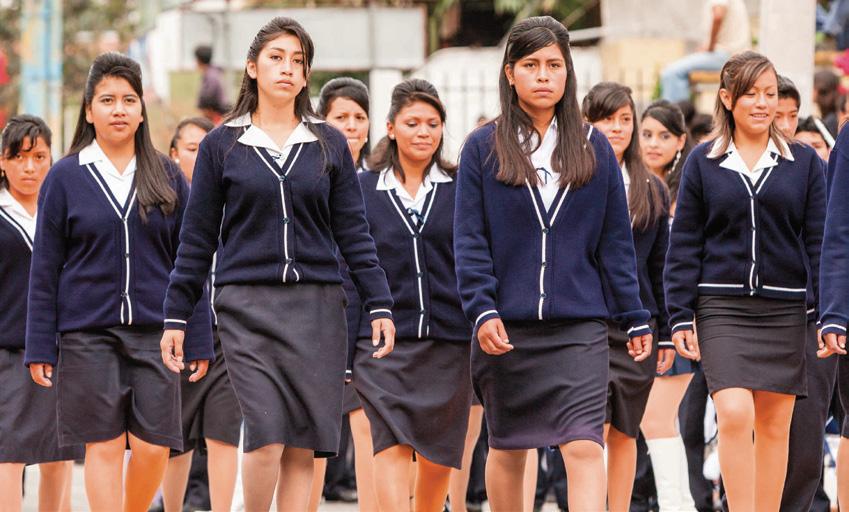
Conexiones
What are some reasons to wear school uniforms?





Paso 1B: Imaginar
Lee las siguientes preguntas y selecciona la respuesta correcta. ¿Qué hay que hacer en cada escenario?
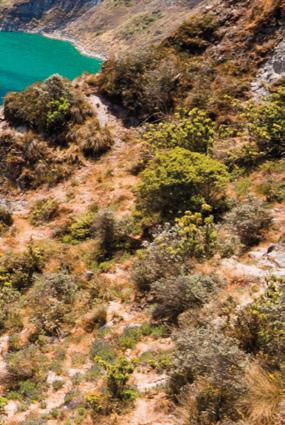
1. Quieres hacer una pregunta a tu profesor/a de Ciencias.
Hay que pedir permiso y salir al baño. Hay que levantar la mano.
2. Te dan tus nuevos libros para la clase de Español.
Hay que llegar a tiempo a la clase de Español.
Hay que poner el nombre en los libros y cuidarlos.
3. Necesitas ir a la oficina de la consejera.







Hay que pedir permiso para salir de clase. Hay que hablar por teléfono a la consejera.
4. Quieres sacar buenas notas en la clase.
Tienes que cuidar el salón.
Tienes que completar todas las tareas.
5. La clase de música empieza a las 10:45 de la mañana.
Hay que llegar a tiempo a clase.
Hay que poner tu instrumento en el casillero.
Enfoque cultural Práctica cultural: Los profesores cambian aulas
In Ecuador and other Spanish-speaking countries, students do not change classrooms during the day. Rather, students stay in the same room all day and their di erent teachers come to their classroom to teach their speci c subject. That’s why David says, “Mi colegio es muy bueno porque los profesores vienen organizados, son puntuales. Claro que hay veces que no, por la razón que tienen algún problema familiar o se olvidaron o algo así”. So in this case, coming to class on time is a rule that teachers have to follow! When the teacher comes into the room, the students (who are already there) stand up next to their desks to show respect for the teacher. In colleges and universities in South America, students also stand up when their professor enters the room.


Conexiones
What do you think about a school day when you don’t move around and the teachers come to you? How is standing up next to your desk a sign of respect for teachers?
De vuelta a clases
Paso 2: Asociaciones
¿Cómo se relacionan las normas de la escuela con el aprendizaje (learning)? Empareja las frases de la izquierda con la acción de la derecha.
1. Para mostrar respeto al profesor a. debes pedir permiso.
2. Para sacar buenas notas en el examen b. debes llegar a tiempo.
3. Para mantener un buen ambiente en la clase c. debes hacer preguntas en clase.


4. Para entender mejor cuando estás confundido d. debes saludar al entrar a clase.



5. Para reusar los libros el próximo año e. debes estudiar.
6. Para no perder los primeros minutos de la clase f. debes seguir las normas.
7. Para salir de la clase g. debes hacer las tareas.
8. Para seguir la información de la clase h. debes cuidar los materiales.
Paso 3: Reflexionar
a. Piensa honestamente en tu comportamiento (behavior) en tus clases. Utiliza la reflexión en la guía digital para ayudarte.
b. Responde a las siguientes preguntas:

• ¿Cuáles son algunas de las normas que debes seguir en tu escuela?
¿Qué reglas sigues en tus clases?
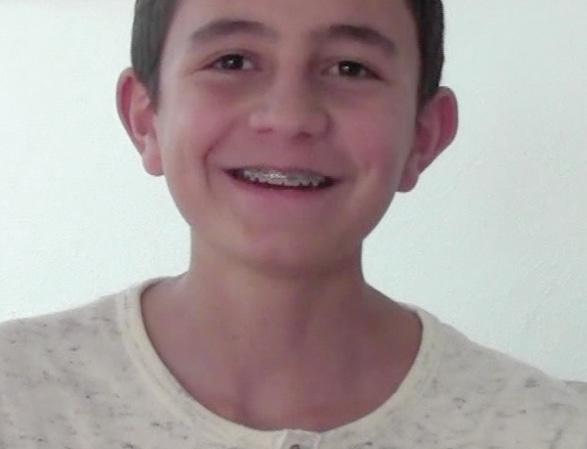

¿Qué puedes hacer para participar y ayudar más en tus clases?
c. Deja un mensaje de voz para tu profesor/a con la autoevaluación de tu comportamiento en tus clases.
Enfoque cultural
Producto cultural: Llevar el carnet estudiantil
In Ecuador and other Spanish-speaking countries, students must have their student identi cation card (carnet de estudiante) with them at all times. Students can use this as a library card or to enter school events, but it also ensures them access to bene ts for students like reduced fare on the local buses that many students take to school.
Conexiones
When and how do you use your student ID card? Is this similar or di erent to how student ID cards are used by Ecuadorian students?

Claro que siempre un profesor te va a poner a veces los exámenes medio difíciles, pero hay que estudiar.
Tú siempre tienes que obedecer al profesor, hacer los deberes, respetar a los directivos…
I can describe my behavior in school.



Mi progreso comunicativo
Actividad 20
¿Por qué es importante seguir las reglas de la escuela?
Paso 1: Observar y escribir
a. Mira las fotos de las dos clases.
b. Completa el organizador gráfico con las acciones (o verbos) para describir qué hacen los estudiantes y la profesora en las fotos.
Paso 2: Conversar
Con un/a compañero/a, hablen sobre estas preguntas:

1. ¿Qué hacen los estudiantes y la profesora en la clase A?
2. ¿Qué hacen los estudiantes y la profesora en la clase B?

3. ¿Qué clase es más tranquila? ¿Más desorganizada?
4. ¿En qué clase pueden los estudiantes aprender mejor? ¿Por qué?
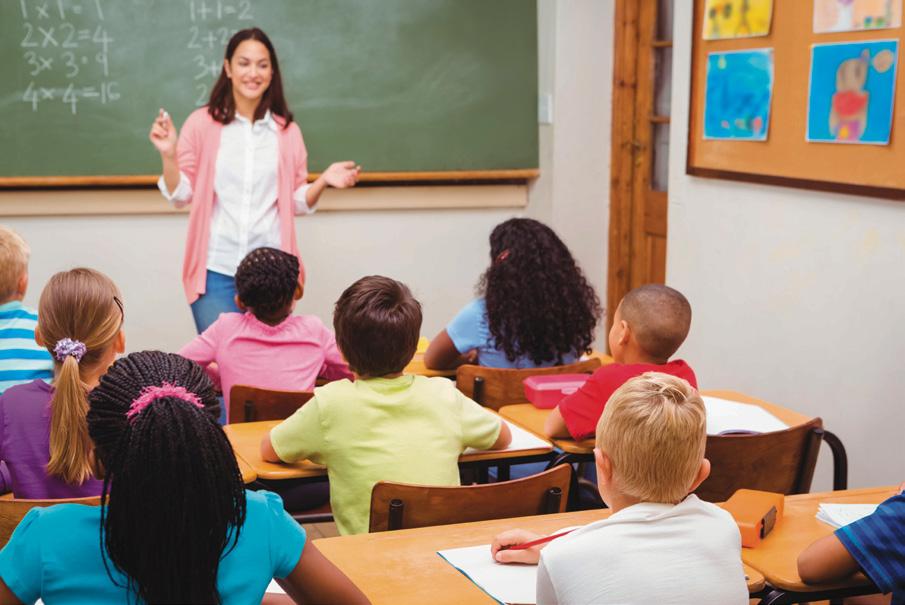


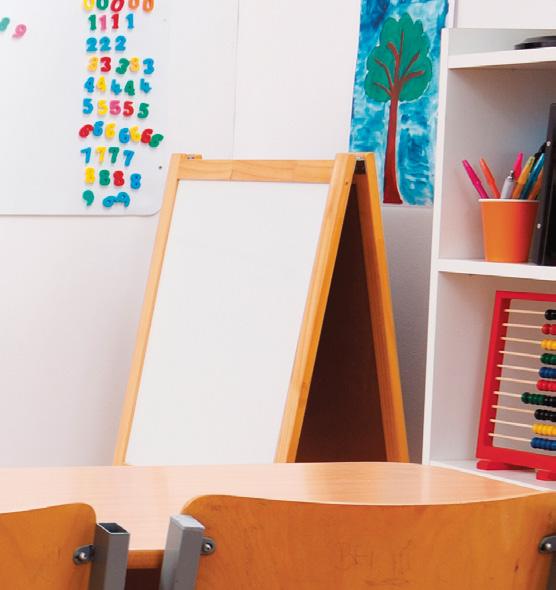

Paso 3: Escribir
Escribe una oración para describir cómo las siguientes reglas influyen en el éxito escolar de los estudiantes en una clase.
• respetar al/la profesor/a y a los otros estudiantes
• prestar atención cuando alguien habla
• cuidar el salón y los materiales

Modelo
Cuando los estudiantes cumplen con las tareas, el profesor no tiene que repasar y puede enseñar nueva información.
Mi progreso comunicativo
I can give examples of how classroom rules impact learning.

De vuelta a clases
Actividad 21
¿Cómo te sientes en las clases?

Paso 1: Escribir y compartir
El ambiente (environment) en las clases depende de las acciones del profesor y de los estudiantes.
a. Revisa el vocabulario de Así se dice 9 para completar el organizador gráfico según el modelo.
b. Añade otras acciones que contribuyen a un ambiente positivo o negativo en la clase.
c. Comparte tus ideas adicionales con un/a compañero/a.
Acciones que contribuyen a un ambiente positivo
Estudiantes Profesores respetan al/a la profesor/ason acogedores
Acciones que contribuyen a un ambiente negativo Estudiantes Profesores

interrumpen al/a la profesor/a no prestan atención a sus estudiantes
Así se dice 9
El ambiente de la escuela abierto/a académico/a acogedor/a inclusivo/a respetuoso/a tolerante tranquilo/a Problemas en la escuela el acoso escolar faltar el respeto insultar interrumpir obedecer/desobedecer portarse mal
¿Te acuerdas de las emociones?
cómodo/a confundido/a contento/a incómodo/a nervioso/a preocupado/a seguro/a tranquilo/a
Mi progreso comunicativo
I can describe how students and teachers create a positive classroom environment.
Paso 2: Imaginar
Piensa en las situaciones anteriores, mencionadas en Paso 1. ¿Cómo te sientes (How do you feel) cuando los estudiantes y profesores hacen una de estas cosas? Conversa con un/a compañero/a.
Modelo
Cuando los estudiantes interrumpen al profesor, me siento… Cuando la profesora sonríe a la clase, me siento…
Paso 3: Describir
Conversa con un/a compañero/a sobre tus experiencias en las clases: ¿Cuáles son las clases que en tu opinión tienen un ambiente positivo?
• ¿Qué hacen o NO hacen los profesores para crear y mantener un ambiente positivo en la clase?
• ¿Qué hacen o NO hacen los estudiantes para crear y mantener un ambiente positivo en la clase?
¡Prepárate!
¿Puedes describir el ambiente en tus clases? ¿Puedes explicar qué hacen tus profesores y los estudiantes para crear un ambiente positivo en la clase? Da ejemplos en la guía digital.
Actividad 22
¿Cómo es un ambiente positivo en la clase?
Paso 1: Pensar y escribir
Piensa en cómo es un ambiente positivo en la clase. Escribe tus ideas en el organizador gráfico de “Veo / Escucho / Me siento”.
• ¿Qué ves en una clase con un ambiente positivo? ¿Qué hacen los estudiantes y qué hace el profesor?
• ¿Qué escuchas, qué dice el profesor y qué dicen los estudiantes?
• ¿Cómo te sientes en una clase con un ambiente positivo?
En una clase con un ambiente positivo…
Me siento
Cuenca, Ecuador
Veo Escucho
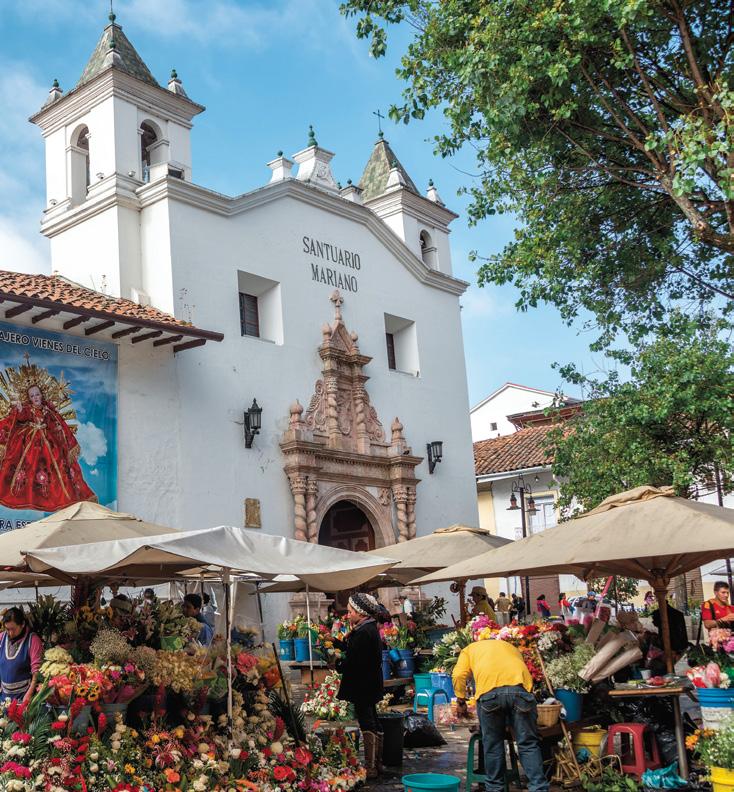
De vuelta a clases
Paso 2: Conversar




a. Comparte tus ideas con un/a compañero/a.

b. Si tu compañero/a tiene otras ideas, añádelas a tu organizador gráfico.

Paso 3A: Pensar y organizar
Mañana vas a participar en una presentación para los estudiantes internacionales de Ecuador. Para preparar la presentación escribe tus ideas sobre estos temas:
• ¿Qué hacen los estudiantes en una clase con un ambiente positivo?

• ¿Qué hace el profesor en una clase con un ambiente positivo?

Paso 3B: Practicar

Visita la guía digital para grabar una práctica de la información que vas a presentar mañana a los estudiantes internacionales de Ecuador. Incluye:





1. ¿Cómo es una clase con un ambiente positivo?
2. ¿Qué debe hacer un/a profesor/a para contribuir a un ambiente positivo?







3. ¿Qué tienen que hacer los estudiantes para crear un ambiente positivo?


4. ¿Qué no deben hacer los estudiantes para mantener un ambiente positivo?






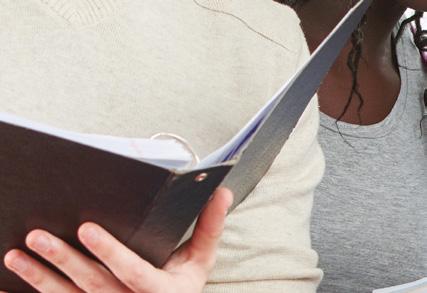
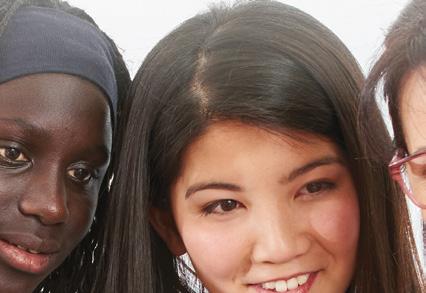

Mi progreso comunicativo
I can describe how students and teachers create a positive classroom environment.

Actividad 23
¿Cómo aprendes en diferentes tipos de ambientes?

Paso 1: Conversar Con un/a compañero/a conversen acerca de los siguientes temas:

1. ¿Es más fácil para ti enfocarte en ciertas clases? ¿Por qué?
2. ¿Prefieres ir a unas clases más que a otras? ¿Por qué?

3. Describe las acciones de los profesores en las clases en las que aprendes mejor.
4. Describe las acciones de los estudiantes en las clases en las que aprendes mejor.
5. ¿Qué clases te parecen más prácticas para tu vida?
6. ¿En qué clases crees que la mayoría de los estudiantes pone más esfuerzo? ¿Por qué?
7. ¿Crees que los profesores más estrictos tienen un mejor ambiente en la clase o es lo opuesto?
Paso 2A: Observar y anotar

Mientras ves el video de la Escuela del Milenio Sumak Yachana Huasi presta atención a Kuri Farinango, un estudiante de esta escuela, cuando describe el ambiente de su escuela.


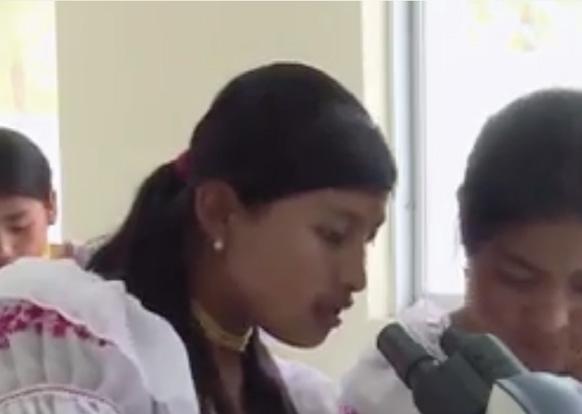


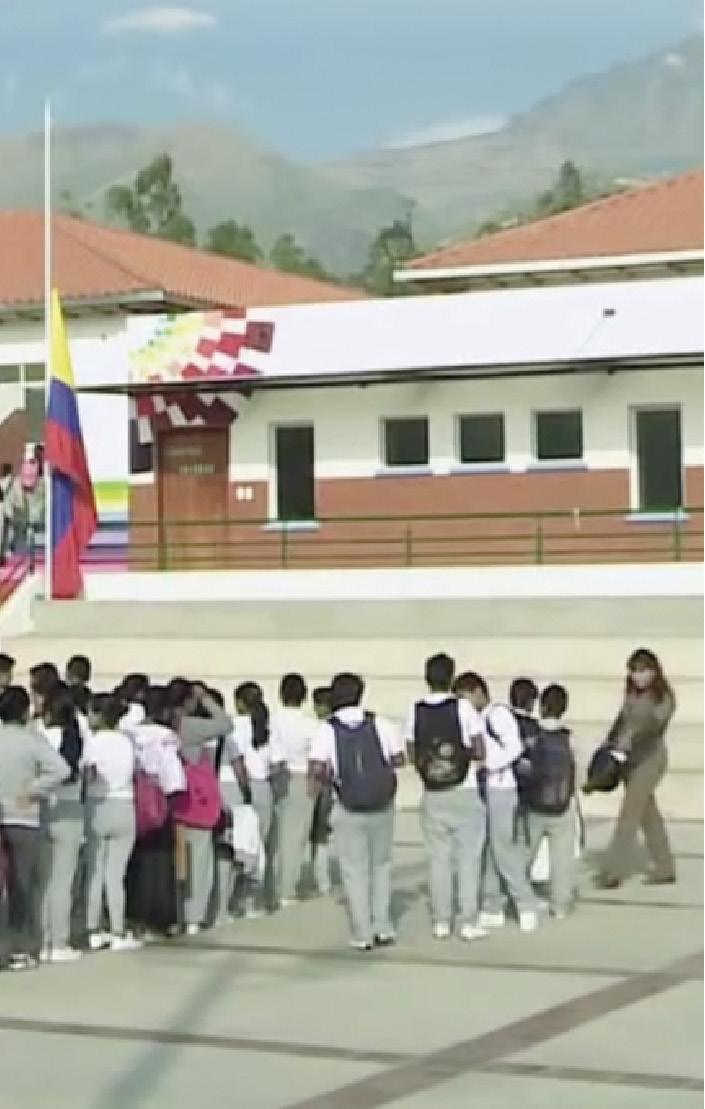
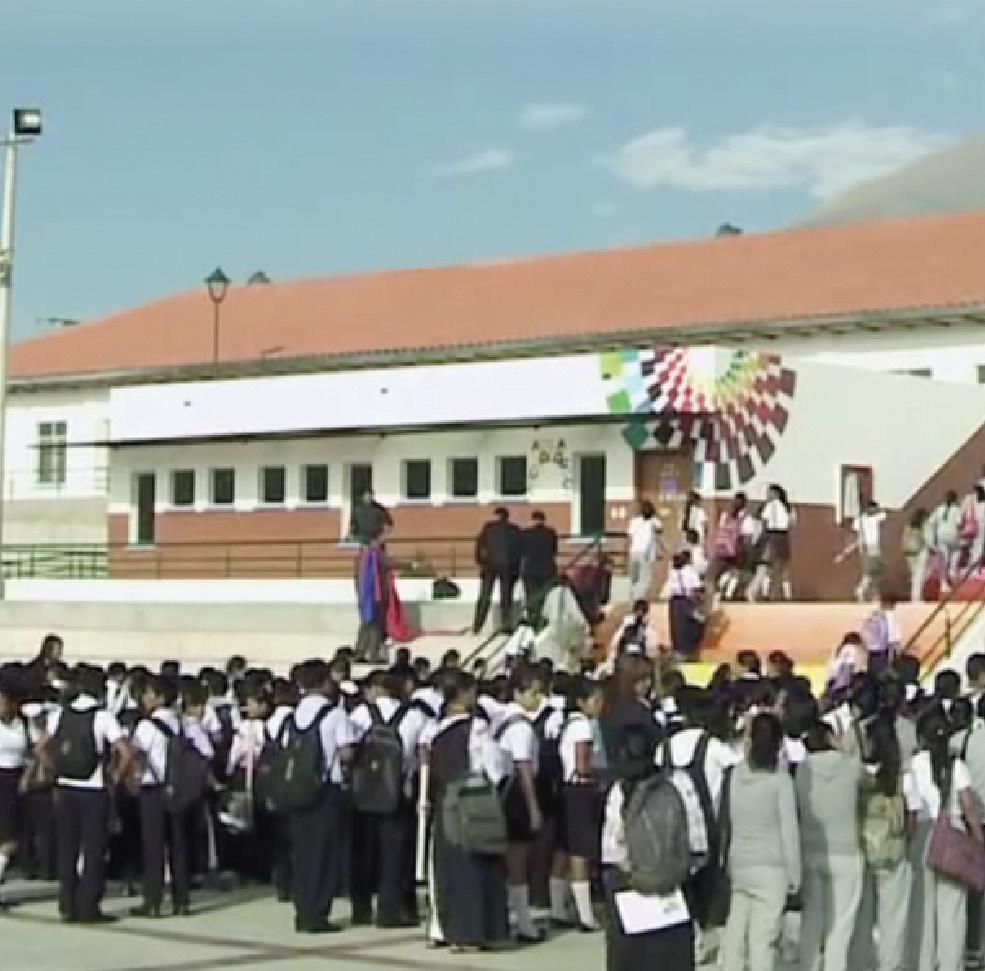
De vuelta a clases
Enfoque cultural
Producto cultural: Escuelas bilingües en Ecuador
In Ecuador there are some bilingual schools, where students who are native speakers of Quichua can learn in their native language. Members of the community, who are native speakers as well, teach these classes. Subjects are taught in both languages and all students learn about academics, culture and language.
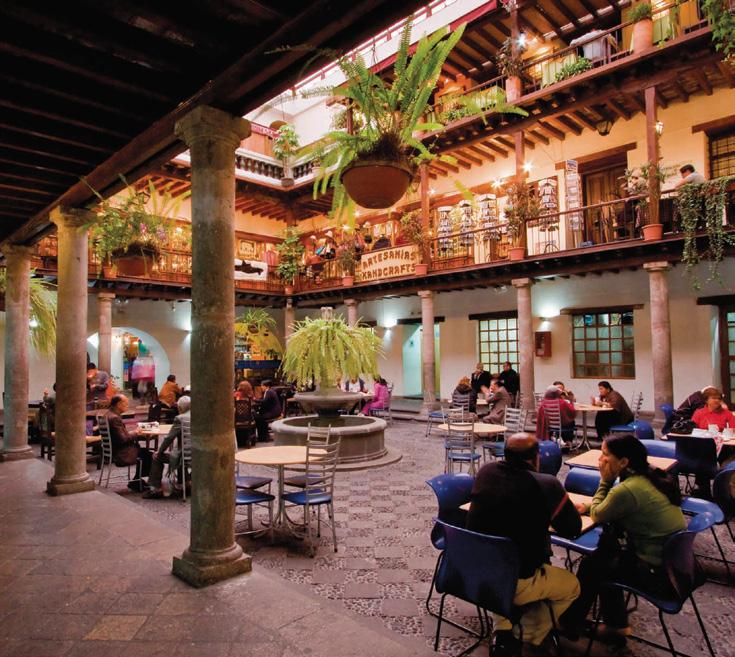
Conexiones
What do you think are the bene ts of a bilingual education?
Además se dice indígenas - indigenous (native to a region) rechazados - rejected vestimenta - clothes idioma natal - native language mestizos - someone of indigenous and European heritage quichua - one of the indigenous languages spoken in Ecuador Paso 2B: Ver y comprender
a. Lee las siguientes oraciones y escribe si el hecho es cierto (C) o falso (F).
b. Si la información subrayada con línea es falsa, escribe la información correcta.
1. Los indígenas se sentían orgullosos (proud) de su vestimenta en sus otras escuelas.
2. El idioma natal de los estudiantes indígenas es el español.
3. Todos los estudiantes en el colegio Sumak Yachana Huasi toman clases en quichua.
4. El ambiente en esta escuela es más inclusivo que otras escuelas que no son bilingües.
Reflexión intercultural
1. Have you ever attended a school that provided all instruction in a language other than your mother tongue? If yes, describe what that was/is like. If not, take a few moments to reflect on what it might be like to learn science, math or history in a second language.
2. Do you think that bilingual schools in Ecuador, like Sumak Yachana Huasi, are improving educational opportunities for all students by conducting classes in the different languages spoken throughout the country instead of solely in Spanish?
3. How might teaching all students quichua create a more positive learning environment for the indigenous students?
4. How is this bilingual school meeting the needs of the students in the community it serves?
Quito, Ecuador
Mi progreso intercultural
I can recognize how bilingual education in Ecuador is improving learning opportunities for indigenous students.
Comunica
En camino B
Cómo tener éxito en tu escuela
You have been paired with a student and his/her family from Ecuador. This exchange student will be arriving at your school soon for an exchange program, and he/she needs to be prepared. The student and their family need to know how the evaluation system works in your school, what the rules and the environment are like at your school, as well as how to be successful.
Paso 1: Escuchar y tomar apuntes
Listen to David as he describes his school. Take notes as he talks about his grades, the school environment and rules.

Paso 2: Leer y escribir

Read an email from one of the students from Ecuador. Reply to the questions in his email about how to be successful in your school.
Paso 3: Presentar tu colegio
Prepare a one-page pamphlet with images that you can send to the new student and his/her family, so they know how to be successful in your school.


• What do students need to do in your school to get good grades?


• What are the rules that students must follow in school?
• What kind of environment is there in different classes at your school? What should students do to contribute to a positive class environment?







Síntesis de gramática
Verbos regulares terminados en: -ar, -er & -ir To conjugate regular verbs, you need to drop the ending (ar, er, ir) and add a new ending for each form. Here you can find some examples: caminar yo camino nosotros caminamos tú caminas vosotros camináis Ud. camina Uds. caminan él/ella camina ellos/ellas caminan
Modelo
Nosotros caminamos a la escuela todos los días. comer yo como nosotros comemos tú comes vosotros coméis Ud. come Uds. comen él/ella come ellos/ellas comen Modelo ¿Comes en la cafetería de la escuela? vivir yo vivo nosotros vivimos tú vives vosotros vivís Ud. vive Uds. viven él/ella vive ellos/ellas viven
Modelo
Vivo cerca de la escuela.
Verbos con cambios en la raíz: These verbs have changes in the stem (root) in all the forms except in the nosotros and vosotros forms. They are also called “boot verbs,” due to the shape of the conjugation chart. There are different kinds: Verbs that change e ie p ensar (to think) yo pienso nosotros pensamos tú piensas vosotros pensáis Ud. piensa Uds. piensan él/ella piensa ellos/ellas piensan
Modelo
Yo pienso jugar fútbol en el otoño. Verbs that change o ue aprobar (to pass a class/exam) yo apruebo nosotros aprobamos tú apruebas vosotros aprobáis Ud. aprueba Uds. aprueban él/ella aprueba ellos/ellas aprueban
Modelo
Mis compañeros aprueban el examen de español. Verbs that change e i p edir (to ask for) yo pido nosotros pedimos tú pides vosotros pedís Ud. pide Uds. piden él/ella pide ellos/ellas piden
Modelo
Daniel pide permiso para ir al baño en todas las clases.
Uso del verbo gustar: If you want to express likes/dislikes in Spanish, use the verb gustar. The verb gustar is conjugated differently.
• Use gusta when talking about a singular item that you like.



• Use gustan when talking about more than one thing that you like.
• If you want to say that you do not like something you need to use the word “no” before the pronoun.


• To talk about what other people like, use the appropriate pronoun.

me gusta(n) nos gusta(n) te gusta(n) os gusta(n) le gusta(n) les gusta(n)
Modelo
Me gusta aprender español.
A Pedro no le gustan las clases de Ciencias. No nos gustan los colegios muy grandes.

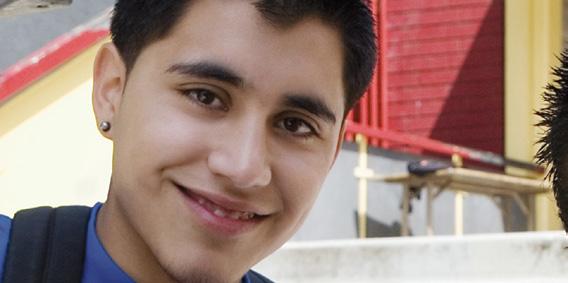
There are other verbs that are similar to gustar, like encantar (to love).




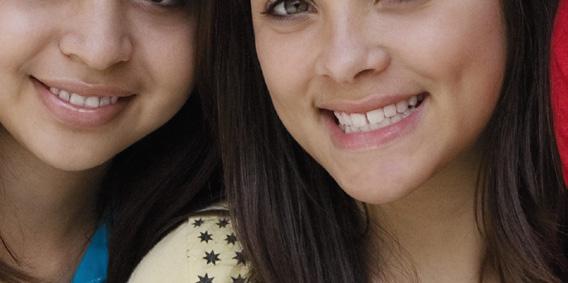


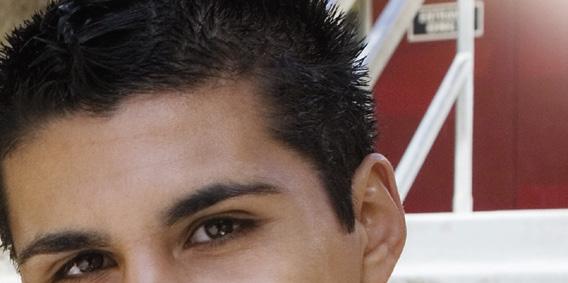
To express obligation: Use hay que + infinitive or tener que + infinitive when you need to express the obligation to do something.

Modelo
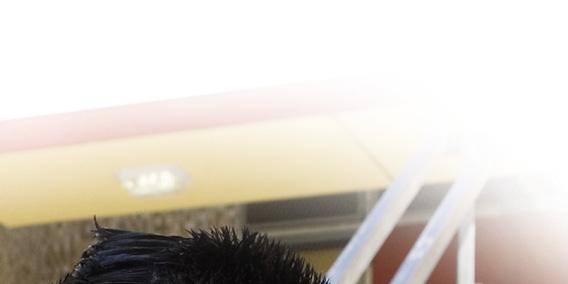

• Hay que estudiar para sacar buenas notas.
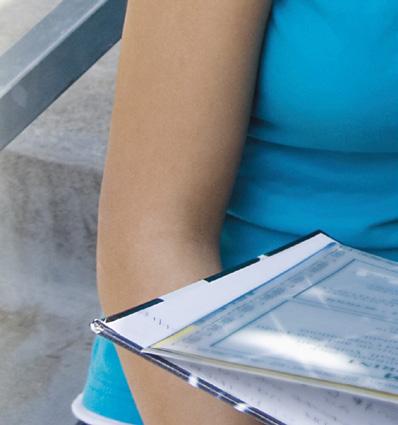

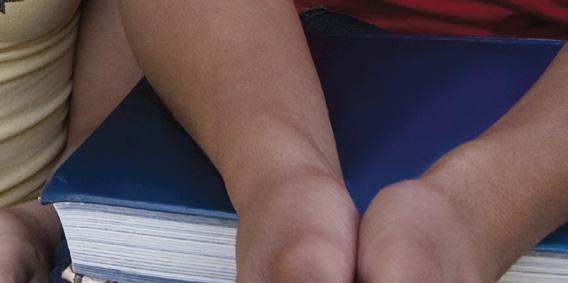
• Tengo que tomar una clase de Química este año.

Vocabulario





Así se dice 7: Las evaluaciones y las tareas aprobar un examen/una clase - to pass an exam/class las calificaciones - grades dar un examen - to take a test (as a student) los deberes - homework evaluar (la evaluación) - evaluation; exam

pedir ayuda - to ask for help reprobar un examen/una clase - to fail an exam/class sacar una buena o mala nota - to earn a good/bad grade tener éxito - to be successful tomar un examen - to give a test (as a teacher)




Así se dice 8: Las reglas en la escuela cuidar el salón y los materiales - to take care of the classroom and materials cumplir con las tareas - to do homework llegar a tiempo - to arrive on time pedir permiso para… - to request permission to… prestar atención - to pay attention respetar - to respect



Así se dice 9

El ambiente de la escuela abierto/a - open académico/a - academic acogedor/a - welcoming; nurturing inclusivo/a - welcomes all types of students respetuoso/a - respectful tolerante - tolerant tranquilo/a - peaceful; calm


Problemas en la escuela el acoso escolar - bullying faltar el respeto - to be disrespectful insultar - to offend; to insult interrumpir - to interrupt llegar tarde - to arrive late obedecer/desobedecer - to obey; to disobey






Sugerencias para escribir:
En mi escuela ideal, hay…
- In my school there is (are)…
Los estudiantes tienen clases de… Students have…classes
Los profesores son…
- The teachers are…
En las clases, los profesores… In class, teachers…

Los estudiantes…
Students…


El ambiente de la escuela es… The school environment…
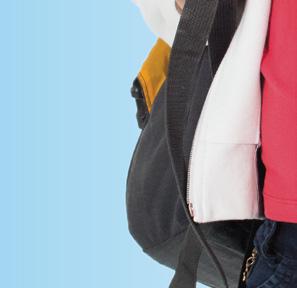
En mi escuela ideal, hay que… In my ideal school…

Los estudiantes tienen que…
- Students have to…
Vive entre culturas

Una escuela ideal
Pregunta esencial: How do schools in different cultural contexts meet the needs of their students?

A large technology company has decided to invest in education by opening new schools throughout North and South America. The company’s goal is to create schools that meet the specific needs of the communities they will serve. They are very inspired by the bilingual schools that have been designed and built in recent years in Ecuador.




They have asked students throughout the Americas to participate in a contest to design an ideal school. First, students should observe Sumak Yachana Huasi, a bilingual school in Cotacachi, Ecuador. Based on this model, they should design an ideal school focusing on two big ideas:
• How does the culture of a particular community present unique needs for a school?


• What are some key elements that are essential to a successful school, anywhere?


Interpretive Assessment
Paso 1: Mirar y anotar
Watch the video about the bilingual school, Sumak Yachana Huasi, in Ecuador.
a. Note what unit vocabulary you hear or see in the video.
b. Complete statements about this school to show what you understood.
Interpersonal Assessment






Paso 2: Reflexionar y conversar



a. Reflect on what you have learned about the bilingual school in Ecuador, Sumak Yachana Huasi, in this unit. Organize your ideas in response to the questions in your Explorer course.
b. Participate in group conversations and prepare for your final presentation by sharing your ideas and learning from your classmates. See questions in your Explorer course.





Presentational Assessment




Paso 3: Presentar tu escuela ideal

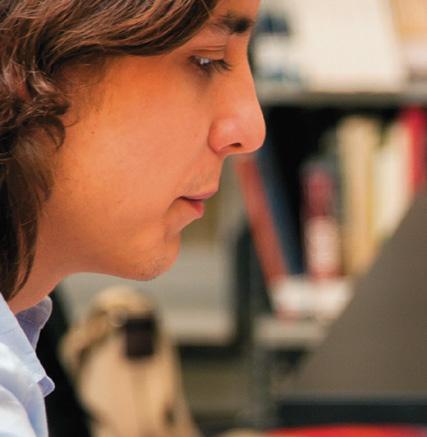

a. Create a written proposal for what you believe is an ideal school that you will present to your peers. As you design, think about how the bilingual school Sumak Yachana Huasi is meeting the needs of the students in that community by emphasizing interculturality.
Include the following information about your school in your presentation:



Can-do Statements
Can-do Statements (Appendix A) . . .
Rubrics (Appendix B) . . . . . . . . . . . . .
AP® and IB
Correlation Guide (Appendix C) . . . 374
Can-do Statements
Unidad 1: De vuelta a clases
Mi progreso intercultural
I can compare my school to schools in Andean Spanish-speaking countries.*
I can compare my school schedule to a school schedule from a Spanish-speaking country.
I can describe how technology meets the needs of students and creates learning opportunities.
I can explain how teachers support student learning in different cultural contexts.
Mi progreso comunicativo
I can describe and compare school buildings.
I can recognize people who work at schools when their jobs are described.
I can ask and answer questions about my class schedule.
I can express preferences about classes and classroom activities.
I can exchange information to describe my teachers.
I can draw comparisons between different people.
I can describe the attributes of an ideal teacher.
I can give examples of what schools include and offer that meets their students’ needs.
I can describe how students in different countries view success in school.
I can recognize how bilingual education in Ecuador is improving learning opportunities for indigenous students.
I can identify extracurricular activities when I hear them described.
I can give opinions about what extracurricular activities schools should offer.
I can recognize ways to be successful in school from someone speaking about the topic.
I can explain how to be successful in school.
I can describe my behavior in school.
I can give examples of how classroom rules impact learning.
I can describe how students and teachers create a positive classroom environment.
Can-Do Statements are Wayside Publishing’s alone and not based on the
Can-Do Statements.
Statements
Unidad 2: La cultura de una familia
Mi progreso intercultural
I can recognize how descriptive and figurative language is used in literature to describe family.
I can compare and contrast perspectives on family from different cultures.
I can compare greeting and leave-taking practices in Spanish-speaking cultures with those of my culture.
Mi progreso comunicativo
I can describe family structures.
I can compare family structures.
I can draw comparisons between family members.
I can describe family members.
I can explain how people in a household schedule their daily routines.
I can narrate my daily routine and my family’s daily routine.
I can describe customs my family regularly observed in the past.
I can ask and answer questions about what I used to do when I was young.
I can express some information about family values in Mexico.
I can describe what roles in the family used to be like and how they have changed.
I can describe how technology impacts family life.
I can reflect on and share some of my family’s values.
I can comprehend descriptions of family members doing household chores.
I can describe household responsibilities within my family.
I can exchange information about how the individuals in my family help around the house.
Statements
Unidad 3: Un mundo hecho por comunidades
Mi progreso intercultural
I can identify the Spanish colonial influence in Latin American communities.
I can compare and contrast the layout of my community with that of a Spanishspeaking community.
I can identify some icons and celebrations that express the shared identity of a community.
I can identify some of the cultural differences between shopping in an outdoor market or in a supermarket.
I know how and when to bargain in culturally appropriate ways.
I can explain why different modes of transportation are used in communities across Spanish-speaking cultures.
Mi progreso comunicativo
I can describe places and their location in a community.
I can identify what people do at different places in their community.
I can use appropriate vocabulary to bargain in a relevant cultural context. I can retell what I did at various places in my community.
I can describe how people traveled by various modes of transportation.
I can ask for and give directions to get around a community.
I can use a city map to help me find my way in Central American communities.
I can identify unique ways to give directions in Costa Rica.
I can describe how my own and other cultures honor and celebrate the cultural diversity of a community.
I can explain how collaboration among community members benefits the community as a whole.
I can explain why international volunteers make a difference in Latin American communities.
I can describe how people and communities celebrate their cultures and ancestry.
I can describe how people contributed to community projects and celebrations.
I can identify ways that individuals made a difference in their communities.
I can encourage others to get involved in a community project.
Can-do Statements
Unidad 4: En la cocina de mi abuela
Mi progreso intercultural
I can compare typical meals and ingredients used in Caribbean cooking and in my own community.
I can identify what food would be culturally appropriate to serve at different times of the day in Spanish-speaking cultures.
Mi progreso comunicativo
I can identify ingredients commonly used in Caribbean cooking.
I can talk about the foods I like to eat and when I typically eat them.
I can express and explain my food preferences.
I can describe the flavors and ingredients in a variety of dishes.
I can understand and identify what I hear when someone describes the flavors of a dish.
I can retell actions in the past to explain how I prepared a meal.
I can tell an adult how to make a familiar recipe.
I can ask and answer questions about how to prepare various dishes.
I can invite friends over for a gathering and name the food items that will be served.
I can describe and compare traditional and modern approaches to healthcare in Cuba and my community.
I can ask and answer questions about activities in the past.
I can describe my symptoms to someone when I am sick.
I can understand when someone describes how they felt when they were sick in order to identify their illness.
I can describe how I felt when I was sick in the past.
I can give advice about what to do based on different health-related symptoms.
I can ask and answer questions about homemade remedies.
I can answer questions about my symptoms.
Can-do Statements
Unidad 5: Vida social
Mi progreso intercultural
I can describe how friends greet one another in other cultures.
I can describe culturally appropriate norms when attending a social or family event in Spanish-speaking countries.
I can compare a variety of leisure-time activities popular in Peru with those in my community.
Mi progreso comunicativo
I can describe my social habits and preferences.
I can ask and answer questions about technology use and social habits.
I can use some culturally appropriate expressions to extend, accept and politely refuse an invitation.
I can retell past events about spending time with friends and/or family in the community.
I can ask and answer questions about past events related to time with friends and family.
I can narrate past outdoor adventures including completed actions and descriptions of background information.
I can use formal language to show respect in Spanish.
I can investigate prices in Peru and compare with prices for similar products where I live.
I can identify where to buy certain clothing items.
I can describe what clothes to wear for different occasions.
I can ask and answer questions about purchases in a store.
I can exchange information about prices and discounts on different items.
I can report on a purchase I made and how much I spent and saved.
I can ask for and give information about prices, styles, and sizes of clothing or models and prices of other goods.
I can talk about how much items cost.
I can exchange information about what items I purchased and for whom.
Unidad 6: Un viaje al extranjero
Mi progreso intercultural
I can identify appropriate steps to take and ways to interact in an airport in a Spanish-speaking country.
I can describe how to show respect and understanding in community-based tourism.
I can compare the differences between staying in a hotel and in a family’s home.
Mi progreso comunicativo
I can follow suggestions for getting around an airport when I read them or when someone tells me what to do.
I can tell a Spanish-speaking friend how to get around an airport.
I can narrate a story about a past travel experience.
I can exchange basic and necessary travel information in the airport.
I can communicate basic needs to a flight attendant.
I can talk about my preferences when flying on an airplane.
I can share tips for flying on a plane.
I can explain how to plan for a longdistance bus trip.
I can describe the practice and perspective of dining in a casa de familia when traveling.
I can explain the importance of respectful tourism while visiting historic sites.
I can explain the importance of supporting artisanal crafts when visiting a new community.
I can initiate, sustain and close a conversation about how to arrive at a specific destination.
I can talk about the benefits of community-based tourism and how to be a responsible traveler.
I can describe una casa de familia.
I can give advice on where to stay depending on preferences.
I can retell what happened in a restaurant after hearing a conversation.
I can order and make simple requests in a restaurant.
I can ask and answer questions about destinations while traveling.
I can give advice to travelers about how to respectfully visit sites in another country.
Level 2 EntreCulturas Analytic Growth Rubric
Interpretive Reading, Listening, Audiovisual, and Viewing
LEVEL 2 TARGET: NOVICE HIGH - INTERMEDIATE LOW
DOMAINS
HOW WELL DO I UNDERSTAND?
MAIN IDEA AND/OR DETAILS
WHAT WORDS AND STRUCTURES DO I UNDERSTAND?
VOCABULARY AND STRUCTURES IN CONTEXT
NOVICE MID NOVICE HIGH INTERMEDIATE LOW INTERMEDIATE MID
I can recognize and understand some basic information with memorized words and phrases.
I can identify pieces of information and sometimes the main idea(s) without explanation when the idea is familiar, short, and simple.
I can identify the main idea(s) and some details when the idea is familiar, short, and simple.
I can recognize words and phrases, including cognates, and borrowed words in text or speech from well-practiced topics.
I can understand words, phrases, simple sentences, and some structures in short, simple texts or sentence-length speech, one utterance at a time, with support, related to familiar topics of study.
I can identify words, phrases, highfrequency expressions, and some learned structures in short, simple, loosely connected texts or sentence-length speech, one utterance at a time, related to familiar topics of study.
I can identify the main idea(s) and a few supporting details when the idea is related to everyday life, personal interests, and studies.
I can identify some words, phrases, and structures in various time frames (e.g., past, future) in simple, loosely connected texts or straightforward speech related to everyday life and personal interests and studies.
HOW WELL CAN I UNDERSTAND UNFAMILIAR LANGUAGE?
CONTEXT CLUES
I can understand some basic meaning when authentic texts or speech on very familiar topics include cognates and/or visual clues.
I can understand basic meaning when short, non-complex authentic texts or speech include cognates and visual clues, on familiar topics.
I can understand literal meaning from authentic texts or speech on familiar topics and from highly predictable texts related to daily life.
I can understand literal meaning from authentic texts on familiar topics and from predictable texts related to daily life and personal interests or studies.
DOMAINS
HOW WELL CAN I INFER MEANING BEYOND WHAT I READ OR HEAR?
INFERENCES
NOVICE MID NOVICE HIGH INTERMEDIATE LOW INTERMEDIATE MID
I can make limited inferences based on visual clues, organizational layout, background knowledge, keywords, in ection and/or body language.
I can make a few inferences based on visual clues, organizational layout, background knowledge, keywords, in ection and/or body language.
I can make some inferences based on the main idea and information such as visual clues, organizational layout, background knowledge, keywords, in ection and/or body language.
I can make inferences based on the main idea and information such as visual clues, organizational layout, background knowledge, keywords, in ection and/or body language.
HOW INTERCULTURAL AM I?
INTERCULTURALITY
*Based on classroom tasks/activities/ intercultural re ections and outside classroom experiences.
I can identify a few cultural products, practices, perspectives including cultural behaviors and expressions related to daily life.
I can identify some cultural products, practices, perspectives, including cultural behaviors and expressions related to daily life.
I can describe cultural products, practices, perspectives, including cultural behaviors and expressions related to daily life.
I can compare cultural products, practices, perspectives, including cultural behaviors and expressions related to daily life.
Level 2 EntreCulturas Analytic Growth Rubric
Interpersonal Communication: Speaking and Writing
LEVEL 2 TARGET: NOVICE HIGH - INTERMEDIATE LOW
DOMAINS NOVICE MID NOVICE HIGH INTERMEDIATE LOW INTERMEDIATE MID
HOW WELL DO I MAINTAIN THE CONVERSATION?
QUALITY OF INTERACTION
I have some di culty maintaining simple conversation by using isolated words and memorized phrases.
I speak with frequent hesitation, pauses, and/or repetition.
I can participate in short social interactions by asking and answering simple questions and relying heavily on learned phrases and short or incomplete sentences.
I speak with hesitation, pauses, and/or repetition.
I can sustain the conversation by relying on phrases, simple sentences and a few appropriate questions. I attempt to self-correct but speak with hesitation, pauses, and/or repetition.
I can start and sustain the conversation by asking appropriate questions and responding with a series of sentences.
I can rephrase, selfcorrect and use circumlocution. I speak with some hesitation, pauses, and/or repetition.
WHAT LANGUAGE/ WORDS DO I USE?
VOCABULARY IN CONTEXT
I can use a limited number of highly practiced words and expressions to identify familiar objects and actions.
I can use learned words and phrases to interact with others in tasks and activities on familiar topics.
I can use a variety of new and previously learned words and phrases to interact with others on a range of familiar topics.
I can use a variety of words, expressions, and personalized vocabulary to interact with others on a wide range of topics and begin to expand vocabulary within a topic.
HOW DO I USE LANGUAGE?
FUNCTION AND TEXT TYPE
I can ask and respond to highly predictable questions with words, lists, and memorized phrases. I am beginning to communicate beyond the word level, but my errors often interfere with the message.
I can use phrases, simple sentences, and questions. I am beginning to create original sentences with simple details, but errors sometimes interfere with the message.
I can combine words and phrases to create original sentences in present time with a few details on familiar topics.
I can sometimes vary the time frames (e.g., past, future), but errors may interfere with the message.
I can use a series of sentences to describe or explain with details, using a variety of time frames (e.g., past, future), but I make frequent errors in complex structures.
I can combine simple sentences using connectors or transitions.
HOW WELL AM I UNDERSTOOD ?
COMPREHENSIBILITY
I am somewhat understood by someone accustomed to a language learner.
I am often understood by someone accustomed to a language learner.
I am usually understood by someone accustomed to a language learner.
I am easily understood by someone accustomed to a language learner.
DOMAINS
HOW WELL DO I UNDERSTAND?
COMPREHENSION
NOVICE MID NOVICE HIGH INTERMEDIATE LOW INTERMEDIATE MID
I can understand some familiar language, one phrase at a time. I rely on visual clues, repetition, and/or a slowed rate of speech.
I can understand pieces of information and sometimes the main idea in straightforward language that uses familiar structures. I occasionally rely on visual clues, repetition, and/or a slowed rate of speech.
I can understand the main idea in short, simple messages and conversations and in sentence-length speech that uses familiar structures. I rely on restatement, paraphrasing, and/or contextual clues.
I can understand the main ideas in messages and conversations on a variety of everyday topics and personal interests. I can understand extended speech but with frequent gaps in comprehension.
HOW INTERCULTURAL AM I?
INTERCULTURALITY
*Based on classroom tasks/activities/ intercultural re ections and outside classroom experiences.
I can apply my knowledge of cultural products, practices, and perspectives in order to interact with respect and understanding.
I can apply my knowledge of cultural products, practices, and perspectives in order to interact with respect and understanding.
I can apply my knowledge of cultural products, practices, and perspectives in order to interact with respect and understanding.
I can apply my knowledge of cultural products, practices, and perspectives in order to interact with respect and understanding.
Level 2 EntreCulturas Analytic Growth Rubric
Presentational Speaking
LEVEL 2 TARGET: NOVICE HIGH - INTERMEDIATE LOW
DOMAINS NOVICE MID NOVICE HIGH INTERMEDIATE LOW INTERMEDIATE MID
WHAT LANGUAGE/ WORDS DO I USE?
VOCABULARY IN CONTEXT
I can use a limited number of words and expressions to identify objects and actions in familiar contexts.
I can use words and expressions that I have practiced to present familiar topics.
I can use a variety of new and previously learned words and phrases to present a range of familiar topics.
I can use a variety of words, expressions, and personalized vocabulary to present a wide range of familiar topics. I am beginning to use expanded vocabulary within a topic of study.
HOW DO I USE LANGUAGE?
FUNCTION AND TEXT TYPE
I can use highly predictable words, lists, and memorized phrases in very familiar contexts.
I can use phrases, simple sentences, and questions. I am beginning to create original sentences with some simple details in familiar contexts.
I can use a series of simple sentences by combining words and phrases to create original sentences with some details and elaboration in familiar contexts.
I can use a series of sentences to describe or explain with some detail and elaboration using connector words to create original sentences in contexts related to familiar topics and studies.
HOW WELL AM I UNDERSTOOD ?
COMPREHENSIBILITY
HOW ACCURATE AM I?
STRUCTURES
I am somewhat understood by someone accustomed to a language learner.
I can use mostly memorized words and some basic structures with frequent errors.
I am often understood by someone accustomed to a language learner.
I can use basic structures in present time with some errors, relying on memorized phrases.
I am usually understood by someone accustomed to a language learner.
I can use basic structures with some variety in time frames (e.g., past, future) with some errors.
I am easily understood by someone accustomed to a language learner.
I can use basic structures in a variety of time frames (e.g., past, future), including some complex structures with connectors and transitions but may have frequent errors.
HOW WELL DO I DELIVER MY MESSAGE?
DELIVERY, FLUENCY, VISUALS, IMPACT ON AUDIENCE
HOW INTERCULTURAL AM I?
INTERCULTURALITY
I can deliver my message using isolated words and memorized phrases, speaking with frequent hesitation, pauses, and/or repetition.
I can apply my knowledge of cultural products, practices, and perspectives in order to interact with respect and understanding.
I can deliver my message by relying on learned phrases and short or incomplete sentences, speaking with hesitation, pauses, and/or repetition.
I can apply my knowledge of cultural products, practices, and perspectives in order to interact with respect and understanding.
I can deliver my message by relying on phrases and simple sentences, speaking with hesitation, pauses, and/or repetition.
I can apply my knowledge of cultural products, practices, and perspectives in order to interact with respect and understanding.
I can deliver my message by using a series of sentences. I can self- correct some of the time, speaking with some hesitation, pauses, and/or repetition.
I can apply my knowledge of cultural products, practices, and perspectives in order to interact with respect and understanding.
Level 2 EntreCulturas Analytic Growth Rubric
Presentational Writing
LEVEL 2 TARGET: NOVICE HIGH - INTERMEDIATE LOW
DOMAINS NOVICE MID NOVICE HIGH INTERMEDIATE LOW INTERMEDIATE MID
WHAT LANGUAGE/ WORDS DO I USE?
VOCABULARY IN CONTEXT
I can use a limited number of memorized words and phrases in context.
I can use words and expressions that I have practiced on familiar topics.
I can use a variety of new and previously learned words and phrases on a range of familiar topics.
I can use a variety of words, expressions, and personalized vocabulary on a wide range of familiar topics.
I am beginning to use expanded vocabulary within a topic.
HOW DO I USE LANGUAGE?
FUNCTION AND TEXT TYPE
I can supply information in a form, chart, or organizer.
I can write lists and memorized phrases on familiar topics.
I can write short messages, postcards, and simple notes on familiar topics related to everyday life. I can use learned vocabulary and structures to create simple sentences and questions on very familiar topics. I can add simple details.
I can write a series of simple sentences on familiar topics. I can create original sentences and questions using some connectors. I can describe or explain with some detail and elaboration.
I can write on a wide variety of familiar topics using connected sentences in paragraphs.
I can describe or explain events and experiences with details and elaboration.
I am beginning to provide clari cation or justi cation.
HOW WELL AM I UNDERSTOOD ? COMPREHENSIBILITY
HOW WELL DO I USE THE LANGUAGE?
LANGUAGE CONTROL
I am somewhat understood by someone accustomed to a language learner..
I am beginning to use basic structures with frequent errors.
I am often understood by someone accustomed to a language learner..
I can use basic structures in present time with some errors.
I am usually understood by someone accustomed to a language learner..
I can use basic structures with some variety in time frames (e.g., past, future) but more errors may occur.
I am easily understood by someone accustomed to a language learner..
I can use basic structures in a variety of time frames. I can use some connectors and transitions to combine sentences including complex structures but with frequent errors.
HOW WELL DO I COMPLETE THE TASK?
IDEAS AND ORGANIZATION
HOW INTERCULTURAL AM I?
INTERCULTURALITY
I can complete the task with familiar content. My ideas are minimally developed and lack organization.
I can apply my knowledge of cultural products, practices, and perspectives in order to convey respect and understanding in writing.
I can complete the task with familiar content and some examples. My ideas are somewhat developed and organized.
I can apply my knowledge of cultural products, practices, and perspectives in order to convey respect and understanding in writing.
I can complete the task with familiar content using some details and examples. My ideas are mostly developed and organized.
I can apply my knowledge of cultural products, practices, and perspectives in order to convey respect and understanding in writing.
I can complete the task with appropriate content, details, and adequate examples. My ideas are adequately developed and organized.
I can apply my knowledge of cultural products, practices, and perspectives in order to convey respect and understanding in writing.
Level 2 EntreCulturas Holistic Rubric
Interpretive Reading, Listening, and Viewing: Written, Print, Audio, Visual and Audio Visual Resources
LEVEL 2 TARGET: NOVICE HIGH – INTERMEDIATE LOW Daily work, formative assessments.
This is still a goal.
Can do this with help.
Can do this independently.1
INTERPRETIVE: READING, LISTENING, AND VIEWING 123
NM • Recognizes and understands memorized words, phrases, and basic information in text or speech in familiar contexts.
• Makes limited inferences from visual and/or contextual clues and cognates or may use other interpretive strategies.
• Identi es a few cultural products, practices, and perspectives related to daily life, including cultural behaviors and expressions.*
NH • Understands and identi es words, phrases, questions, simple sentences, and sometimes the main idea in short pieces of informational text or speech in familiar contexts.
• Makes a few inferences from visual and/or contextual clues, cognates, and keywords or uses other interpretive strategies.
• Identi es some cultural products, practices, and perspectives related to daily life, including cultural behaviors and expressions.*
IL • Understands and identi es the main idea and key details in short, simple, loosely connected texts or speech in familiar contexts.
• Makes some inferences from visual and/or contextual clues, cognates, and keywords or uses other interpretive strategies.
• Describes cultural products, practices, and perspectives related to daily life, including cultural behaviors and expressions.**
IM • Identi es main ideas and a few supporting details in various time frames (e.g., past, future) in loosely connected texts or speech related to personal interests and studies.
• Makes appropriate inferences from visual and/or contextual clues, cognates, keywords, and some details or uses other interpretive strategies.
• Compares cultural products, practices, and perspectives related to daily life, including cultural behaviors and expressions.**
LEARNER SELF-REFLECTION: WHAT INTERPRETIVE STRATEGIES CAN I USE TO HELP ME UNDERSTAND WHAT I READ/HEARD/VIEWED?
READING
What strategies can I use to make myself understood?
I preview titles, photos, layout, and visuals, etc.
I skim the text for cognates and familiar words and phrases.
I scan the text for speci c details.
I make predictions based on context, prior knowledge, and/or experience.
LISTENING/VIEWING
What strategies did I use to help me understand what I heard?
I listen/watch for emotional reactions.
I listen for time/time frames.
I listen for intonation and in ection.
I listen for cognates, familiar words, phrases, and wordorder patterns.
Level 2 EntreCulturas Holistic Rubric
Interpersonal Communication: Speaking, Listening, and Writing
LEVEL 2 TARGET: NOVICE HIGH – INTERMEDIATE LOW
Daily class work, participation, class discussions, pair work, group work, and formative assessments.
NM
NH
IL
This is still a goal.
Can do this with help.
Can do this independently.1
INTERPERSONAL COMMUNICATION: SPEAKING, LISTENING, AND WRITING
• Communicates with some memorized words and expressions in familiar contexts, but needs continual repetition. Some interference from rst language.
• Maintains limited simple conversations with frequent hesitation, pauses, and/or repetition.
• Makes limited inferences from visual and/or contextual clues, or cognates.
• Applies knowledge of cultural products, practices, and perspectives in order to interact with respect and understanding.*
• Communicates and exchanges information with learned words, phrases, simple sentences, and sometimes the main idea/simple details in familiar contexts. Some interference from rst language.
• Participates in short social interactions by asking and answering simple questions with hesitation, pauses, and/or repetition, using a few communication strategies.
• Makes a few inferences from visual and/or contextual clues, cognates, or other language features.
• Applies knowledge of cultural products, practices, and perspectives in order to interact with respect and understanding.*
• Communicates and exchanges information with a variety of new and learned words, phrases, and original sentences in present tense with some details in familiar contexts. Limited interference from rst language.
• Participates in social interactions by asking and answering a few appropriate questions with hesitation, pauses, and/or repetition, using some communication strategies.
• Makes some inferences from visual and/or contextual clues, cognates, or other language features.
• Applies knowledge of cultural products, practices, and perspectives in order to interact with respect and understanding.**
IM • Communicates with a variety of expressions and personalized vocabulary with a series of sentences to describe details in a variety of time frames in daily life. A few errors may interfere with the message.
• Participates in conversations by asking and answering a variety of questions with some hesitation, pauses, and/or repetition, using a variety of communication strategies.
• Makes appropriate inferences from visual and/or contextual clues, cognates, or other language features.
• Applies knowledge of cultural products, practices, and perspectives in order to interact with respect and understanding.**
SPEAKING/WRITING
What strategies can I use to make myself understood?
I repeat words and phrases.
I use facial expressions, gestures, and appropriate openings and closings.
I self-correct when I am not understood.
I imitate modeled words.
I restate and rephrase using di erent words.
I build upon what I’ve heard/read and elaborate in my response.
I use level-appropriate vocabulary in familiar and contextualized situations.
LISTENING
What strategies did I use to help me understand what I heard?
I ask for clari cation or repetition.
I repeat statements as questions for clari cation.
I listen for intonation and in ection.
I listen for cognates, familiar words, phrases, and wordorder patterns.
I indicate lack of understanding.
I ask questions.
LEARNER SELF-REFLECTION: WHAT COMMUNICATION STRATEGIES CAN I USE TO HELP ME UNDERSTAND AND MAKE MYSELF UNDERSTOOD?Adapted from Je erson County Public Schools World Languages: Performance Assessment Rubrics (Kentucky).
Level 2 EntreCulturas Holistic Rubric
Presentational Speaking
LEVEL 2 TARGET: NOVICE HIGH – INTERMEDIATE LOW
Daily class work, participation, share out or present to class, present to a group, formative assessments, and using the Explorer audio and video recording feature.
PRESENTATIONAL SPEAKING
This is still a goal.
Can do this with help.
Can do this independently.1
123
NM • Uses some memorized words and expressions in familiar contexts. Some interference from rst language.
• Delivers message using some highly practiced basic structures with frequent errors. Speaks with frequent hesitation, pauses, and/or repetition.
• Makes limited use of gestures, self-correction, and examples/visuals to support the message.
• Applies knowledge of cultural products, practices, and perspectives in order to interact with respect and understanding.*
NH • Uses most highly practiced/learned words, phrases, and simple sentences in familiar contexts. Some interference from rst language.
• Delivers message using present time frame with some errors and some memorized new structures. Speaks with hesitation, pauses, and/or repetition.
• Makes some use of gestures, self-correction, and examples/visuals to support the message, or a few other communication strategies.
• Applies knowledge of cultural products, practices, and perspectives in order to interact with respect and understanding.*
IL
• Uses new and previously learned words and phrases in a series of simple sentences/ questions to describe or explain with some details and elaboration in familiar contexts. Limited interference from rst language.
• Delivers message using basic structures with some variety in time frames (e.g., past, future) with some errors. Speaks with hesitation, pauses, and/or repetition.
• Makes appropriate use of gestures, self-correction, and examples/visuals to support the message, or other communication strategies.
• Applies knowledge of cultural products, practices, and perspectives in order to interact with respect and understanding.**
IM
• Uses a variety of expressions and personalized vocabulary in a series of sentences to describe or explain with details and elaboration in familiar contexts. A few errors may interfere with the message.
• Delivers message using a variety of basic time frames (e.g., past, future) using connectors and transitions, including complex structures with frequent errors. Speaks with some hesitation, pauses, and/or repetition.
• Makes consistent use of gestures, self-correction, and examples/visuals to support the message, and other communication strategies.
• Applies knowledge of cultural products, practices, and perspectives in order to interact with respect and understanding.**
LEARNER SELF-REFLECTION: WHAT COMMUNICATION STRATEGIES DID I USE TO MAKE MYSELF UNDERSTOOD TO MY AUDIENCE?
PRESENTATIONAL SPEAKING
I organize my presentation in a clear manner.
I use facial expressions and gestures.
I self-correct when I make mistakes.
I present my own ideas.
I use examples to support my message.
I use visuals to support meaning.
I include a hook to gain the audience’s attention.
I notice the reaction of the audience during the presentation.
I repeat or rephrase if the audience doesn’t understand.
I project my voice so the audience can hear me.
I practice my presentation before I present to the audience.
Level 2 EntreCulturas Holistic Rubric
Presentational Writing
LEVEL 2 TARGET: NOVICE HIGH – INTERMEDIATE LOW
Daily written class work, forms, organizers, charts, messages, notes, formative assessments, and using the Explorer tasks, surveys, discussion forums, and more.
PRESENTATIONAL WRITING
1 This is still a goal.
Can do this with help.
Can do this independently.1
123
NM
• Uses memorized words, expressions, and short sentences in somewhat organized and familiar contexts. Frequent interference from rst language.
• Completes the task with some highly practiced basic structures with frequent errors. Ideas lack development and organization.
• Makes limited use of presentational writing strategies.
• Applies knowledge of cultural products, practices, and perspectives in order to convey respect and understanding in writing.*
NH
• Uses highly practiced/learned words, phrases, questions, and simple sentences to write short, simple messages with simple details in familiar contexts. Some interference from rst language.
• Completes the task using present time frame and some memorized new structures. Ideas are partially developed and somewhat organized.
• Makes some use of drafting, outlining, or peer review, or other presentational writing strategies.
• Applies knowledge of cultural products, practices, and perspectives in order to convey respect and understanding in writing.*
IL
• Uses new and previously learned words and phrases in a series of original and simple sentences/questions to describe or explain in some detail, using supporting examples and elaboration in familiar contexts. Limited interference from rst language.
• Completes the task using basic structures with some variety in time frames (e.g., past, future) with signi cant errors. Ideas are mostly developed and organized.
• Makes appropriate use of drafting, outlining, peer review, or other presentational writing strategies.
• Applies knowledge of cultural products, practices, and perspectives in order to convey respect and understanding in writing.**
IM • Uses a variety of expressions and personalized vocabulary and connected sentences in paragraphs to describe with details, supporting examples, and elaboration; beginning to provide clari cation or justi cation on a wide variety of familiar topics. A few errors may interfere with the message.
• Completes the task using a variety of basic time frames (e.g., past, future), using connectors and transitions, including complex structures, with frequent errors. Ideas are adequately developed and organized.
• Makes consistent use of drafting, outlining, peer review, and other presentational writing strategies.
• Applies knowledge of cultural products, practices, and perspectives in order to convey respect and understanding in writing.**
LEARNER SELF-REFLECTION: WHAT COMMUNICATION STRATEGIES CAN I USE TO MAKE MY MESSAGE UNDERSTOOD TO THE READER?
PRESENTATIONAL WRITING
I organize my presentation in a clear manner.
I include a hook to gain the reader’s attention.
I present my own ideas.
I write an outline before I begin to write.
I cite my sources if I have done research on the topic.
I write a draft of my message.
I use examples to support my message.
I ask someone to peer edit my draft before I submit it.
I check all spelling and grammar before I submit it.
I make sure my writing is clear and my handwriting is legible.
Unidad 1
Integrated Performance Assessment Rubric
NOVICE HIGHNOVICE LOW
INTERMEDIATE LOW
INTERMEDIATE MID
TASK COMPONENTS
Correctly recognizes a few memorized target vocabulary words related to the topic.
Correctly recognizes most of the target vocabulary related to the topic.
Correctly recognizes most of the unit target vocabulary related to the topic.
Correctly recognizes almost all of the vocabulary related to the topic.
Recognizes key words Student checks the key words they hear or see on a checklist about the school in Ecuador.
DOMAINS
Identi es a few main ideas and attempts to correct a few of the false statements but not may not be accurate evidence from the video.
Identi es some of the main ideas and can correct some of the false statements with somewhat accurate evidence from the video.
Identi es most of the main ideas and can correct most of the false statements with accurate evidence from the video.
Identi es almost all the main ideas and can correct almost all of the false statements with accurate evidence from the video.
Identi es main ideas Student answers true or false statements based on main ideas of the video and corrects false statements with evidence from the video.
a.Answers a few of the questions with some accurate information.
b. May contribute limited relevant content to the conversation using memorized words and phrases, and may attempt simple sentences. Has some di culty maintaining simple conversation by using isolated words and memorized phrases. Speaks with frequent hesitation, pauses, and/or repetition.
INTERPRETIVE ASSESSMENT
Paso 1a Interpretive audiovisual
Paso 1b
Interpretive reading andaudiovisual
a. Answers some of the questions with some accurate information.
b. Contributes some relevant content and simple details to the conversation using mostly familiar words and phrases in simple sentences related to the topic. Participates in the conversation by asking and answering simple questions and relying heavily on learned phrases and short or incomplete sentences. Speaks with hesitation, pauses, and/or repetition.
The proposal includes a few of the task components Uses some familiar words, unit vocabulary, and memorized phrases and attempts simple sentences.
The proposal includes some of the task components with a few original ideas, some simple details and minimal elaboration. Uses learned vocabulary and structures to write simple sentences.
Attempts to describe intercultural knowledge on how an ideal school can support various cultures.
Describes some intercultural knowledge on how an ideal school can support various cultures.
a. Answers most of the questions with mostly accurate information.
a. Answers almost all the questions with accurate information.
Participates in a conversation
b. Contributes mostly relevant content with some details using a variety of unit vocabulary, and expressions, in simple original sentences Sustains the conversation by relying on phrases and simple sentences.Asks a few appropriate questions and attempts to self-correct, speaks with hesitation, pauses, and/or repetition.
b. Contributes almost all relevant content with details and some elaboration using a variety of vocabulary and expressions responding with a series of sentences. Starts and sustains the conversation by asking appropriate questions and responding with a series of sentences. Rephrases, selfcorrects and speaks with some hesitation, pauses, and/or repetition.
a. Student individually answers a series of questions about the school in Ecuador in order to prepare for small group conversation.
b. Student interacts with classmates, contributing and adding additional information about the school including:
INTERPERSONAL SPEAKING ASSESSMENT
location
classrooms
students who attend
classes
Paso 2a and 2b Interpersonal Speaking
languages
clothing/uniforms
what teachers and students do in class
similarities and di erences
how the school respects students’ cultures
The proposal includes most of the task components with some original ideas, some details and elaboration.
Uses the unit vocabulary and structures with ease in a series of simple and some original sentences using some connectors.
The proposal includes almost all the task components with some original ideas, details, and elaboration. Uses a wide variety of vocabulary and basic structures with accuracy in connected sentences in paragraphs.
Designs an ideal school Student creates a proposal for an ideal school including:
the school building & facilities
course o erings
engaging classroom activities
PRESENTATIONAL WRITING ASSESSMENT
role of teachers
extracurricular opportunities
what students need to be successful
Adequately describes intercultural knowledge on how an ideal school can support various cultures.
Appropriately describes intercultural knowledge on how an ideal school can support various cultures.
Paso 3
school rules
school environment
Student describes intercultural knowledge of how an ideal school can support various cultures represented in the community
Interculturality Part of Paso 3
Mi familia del futuro
Unidad 2
Integrated Performance Assessment Rubric
NOVICE HIGHNOVICE MID
Identi es a limited number of the statements from the audio recording, correctly as true or false. Makes minimal corrections to the false statements using minimal evidence from the audio recording.
Identi es some of the statements from the audio recording, correctly as true or false. Makes some of the corrections to the false statements using some evidence from the audio recording.
INTERMEDIATE LOW
INTERMEDIATE MID
TASK COMPONENTS
DOMAINS
Identi es most of the statements from the audio recording, correctly as true or false. Makes most of the corrections to the false statements using adequate evidence from the audio recording.
Identi es all or almost all of the statements from the audio recording, correctly as true or false. Makes all or almost all of the corrections to the false statements using speci c evidence from the audio recording.
Identi es main ideas Student listens to audio recordings of Mexican teens to determine whether information is true or false, and rewrites false statements with the correct information according to the audio recording.
INTERPRETIVE ASSESSMENT Interpretive Listening Paso 1
Partially completes the task with limited relevant information.
Completes the task with some relevant information and limited details.
Completes the task with mostly relevant information and details.
Completes the task with completely relevant information and details.
Makes comparisons Student compares his or her family life to one of the featured speakers.
Comparaciones Culturales
Responds to questions with words and memorized phrases mostly in the present tense. Somewhat understood despite frequent errors.
Combines familiar words and phrases to create simple sentences with simple details in the present tense and limited use of the imperfect tense. Often understood despite frequent errors.
Combines familiar words and phrases to create original sentences in the present tense tense and some use in the imperfect tense; provides some details and elaborates on the topic. Usually understood despite some errors.
Combines a variety of vocabulary to create strings of sentences using connectors to describe and explain in the present tense tense and in the imperfect tense; provides details and elaborates on the topic. Easily understood despite a few errors.
Participates in a conversation Student asks and responds to given questions about family experiences and what kind of family he or she hopes for in the future. Student is able to make him/ herself understood in the context of a conversation with a peer.
INTERPERSONAL ASSESSMENT Interpersonal Speaking Paso 2
Writes a basic list of features describing future family with minimal references to past family experiences. Writes with little detail using mostly memorized phrases and simple sentences; uses ir + a + in nitive with some errors and uses the imperfect tense minimally with frequent errors that interfere with the message. Adds a few details.
Writes a partially developed and somewhat organized letter describing a future family with some references to past family experiences.
Writes mostly simple sentences using ir + a + in nitive and imperfect tense with some errors that may interfere with the message; may use some connectors, and describes with simple details and minimal elaboration.
Writes a mostly developed and organized letter describing a future family with references to past family experiences. Writes a series of original sentences using ir + a + in nitive and the imperfect tense with some errors; uses some connectors for sentence variety, and describes with some detail and elaboration.
Writes a well developed and organized letter describing a future family with references to past family experiences. Writes original connected sentences in paragraphs with minimal errors using ir + a +in nitive and the imperfect tense; uses connectors and transitions for sentence variety, and describes with detail and elaboration.
Writes about past and future family Student describes hopes for a future family in a letter, referencing past family experiences.
Addresses minimal criteria on the unit checklist.
Addresses some of the criteria on the unit checklist.
Addresses most of the criteria on the unit checklist.
Addresses all or almost all the criteria on the unit checklist.
Minimally references knowledge of cultural practices related to family life.
Somewhat references knowledge of one or two cultural practices related to family life.
Adequately references knowledge of two or more cultural practices related to family life.
Appropriately references knowledge of two or more cultural practices related to family life.
Student references two cultural practices related to family life in Spanish-speaking countries that he or she would or would not like to incorporate into a future family or household.
PRESENTATIONAL ASSESSMENT Presentational Writing Paso 3
Interculturality
Part of Paso 3
comunidad hecho por comunidades
Unidad 3
Integrated Performance Assessment Rubric
NOVICE HIGHNOVICE MID
Identi es limited, basic information and makes limited inferences in order to supply minimal information from the audio recording.
Sometimes identi es the main idea and makes a few inferences in order to supply some of the information from the audio recording.
INTERMEDIATE LOW
INTERMEDIATE MID
TASK COMPONENTS
DOMAINS
Identi es the main idea and makes some inferences in order to supply most of the missing information from the audio recording.
Identi es the main idea and makes inferences in order to supply all or almost all of the missing information from the audio recording.
Identi es main idea and makes inferences Student listens to a volunteer describe a recent international community service trip and supplies the missing information about the volunteer’s experience.
INTERPRETIVE ASSESSMENT
Interpretive Listening Paso 1
Includes a few of the task’s components following the checklist provided to create a partially developed and somewhat organized promotional yer. Describes the service project and experiences with only memorized words and phrases in the preterit. Uses a few memorized informal commands to promote the community service project.
Includes some of the task’s components following the checklist provided to create a mostly developed and mostly organized promotional yer.
Includes most of the task’s components following the checklist provided to create an adequately developed and organized promotional yer.
Describes the service project and experiences using somewhat accurate preterit tense with simple details. Uses some informal commands with limited accuracy (some combination of negative, a rmative, and irregular) to convince other students to participate.
Describes or explains the service project and experiences using mostly accurate preterit tense with some detail and elaboration.
Uses most informal commands appropriately and with some accuracy (negative, a rmative, and/ or irregular) and one or two connectors to convince other students to participate.
Includes all the task’s components following the checklist provided to create a well developed and well organized promotional yer. Describes and explains the volunteer’s experiences using accurate preterit tense with details and elaboration. Uses a variety of appropriate and mostly accurate informal commands (negative, a rmative, and irregular) and some connectors to convince another student to participate.
Creates a promotional yer Student creates a promotional yer to present information about the volunteer’s community service project in Nicaragua (in Paso 1) at a Community Service Fair, including:
• Information about the country, the festivals or celebrations.
• The volunteer’s service project.
PRESENTATIONAL ASSESSMENT Presentational Writing Paso 2
• How communities bene t from international service projects.
Convincing a peer to participate in this type of project.
•
Prepares a few memorized questions to ask about volunteer projects and service opportunities. Maintains a simple conversation with some difficulty by using words and memorized phrases. Speaks with frequent hesitation, pauses, and/or repetition. Somewhat understood despite frequent errors.
Prepares simple questions to learn about past volunteer projects and service opportunities. Maintains a short social conversation by asking and answering simple questions and relying on learned phrases and short or incomplete sentences. Speaks with hesitation, pauses, and/or repetition. Often understood despite errors.
Prepares adequate questions to learn about past volunteer projects and service opportunities. Maintains a conversation by relying on phrases and simple sentences; asks a few questions and attempts to self-correct.
Speaks with hesitation, pauses, and/or repetition. Usually understood despite some errors.
Prepares appropriate questions to learn about past volunteer projects and service opportunities. Maintains a conversation by asking appropriate questions and responding with a series of sentences. Speaks with some hesitation, pauses, and/or repetition. Easily understood despite a few errors.
Asks a partner about a service project
• Student prepares and asks questions about volunteer projects and service opportunities.
INTERPERSONAL ASSESSMENT
• Students responds to questions about a community service project.
Interpersonal Speaking Paso 3
Minimally describes one way international volunteers make a positive impact in Latin American communities.
Somewhat describes one way international volunteers make a positive impact in Latin American communities.
Adequately describes one way international volunteers make a positive impact in Latin American communities.
Appropriately describes one way international volunteers make a positive impact in Latin American communities.
Student describes one way Latin American communities bene t from international volunteer projects.
Interculturality
Part of Paso 2
Remedios caseros durante una visita
Unidad 4
Integrated Performance Assessment Rubric
NOVICE HIGHNOVICE MID
INTERMEDIATE LOW
INTERMEDIATE MID
TASK COMPONENTS
Identi es and records a few symptoms on the organizer.
Identi es and records some of the students’ symptoms on the organizer.
Identi es and records most of the students’ symptoms on the organizer.
Identi es and records all or almost all of the students’ symptoms on the organizer.
Identi es main ideas Student listens to audio recordings of young people describing their symptoms, records the symptoms, and matches them with given images.
Responds to highly predictable questions with words or a memorized answer in the present tense, and errors often interfere with the message. Somewhat understood despite frequent errors.
Responds to some of the interview questions with simple information, providing a few simple details on the topic. Uses familiar words and phrases to create simple sentences in the present tense, and errors sometimes interfere with the message. Often understood despite errors.
Responds to most of the interview questions with appropriate content, providing some details and elaborating on the topic. Uses familiar words and phrases to create original sentences in the present tense, although errors may interfere with the message. Usually understood despite some errors.
Responds to all or almost all of the interview questions with appropriate content, providing details and elaborating on the topic. Uses a variety of vocabulary to create a series of sentences using connectors to describe and explain in the present tense. Easily understood despite a few errors.
Participates in a conversation Student responds to questions from an adult about how he/she is currently feeling. Student conveys how he/ she feels in the context of a conversation with an adult.
DOMAINS
INTERPRETIVE ASSESSMENT
Interpretive Listening Paso 1
INTERPERSONAL ASSESSMENT Interpersonal Speaking Paso 2
Leaves a brief message with limited words and expressions; uses memorized words and phrases, and may attempt using preterit or imperfect tenses and/ or formal commands with frequent errors that interfere with the message. Speaks with frequent hesitation, pauses, and/ or repetition; somewhat understood despite frequent errors.
Leaves a somewhat complete message with simple details using mostly simple sentences; relies on learned uses of imperfect and preterit tenses and/ or formal commands with some errors that may interfere with the message.
Leaves a mostly complete message with some detail and elaboration using a series of simple sentences; uses the imperfect and preterit tenses and formal commands with some errors.
Speaks with hesitation, pauses, and/or repetition; often understood despite frequent errors.
Speaks with hesitation, pauses, and/or repetition; usually understood despite some errors. Addresses most of the criteria on the unit checklist.
Addresses limited criteria on the unit checklist.
Addresses some of the criteria on the unit checklist.
Minimally describes a homemade remedy from a Spanish-speaking country.
Somewhat describes a homemade remedy from a Spanish-speaking country.
Adequately describes a homemade remedy from a Spanish-speaking country.
Leaves a complete and detailed message using a series of sentences in the preterit and imperfect tenses and formal commands with a few errors; uses some connectors and transitions with errors. Self-corrects some of the time and speaks with some hesitation, pauses, and/or repetition; easily understood despite a few errors. Addresses all or almost all of the criteria on the unit checklist.
Leaves a message for an adult with information and advice Student introduces him/ herself, describes his/her recent symptoms in the imperfect tense, narrates in the preterit tense how his/ her host mother prepared a remedy, and gives formal commands explaining how to prepare the same remedy.
PRESENTATIONAL ASSESSMENT Presentational Speaking Paso 3
Appropriately describes a homemade remedy from a Spanish-speaking country.
Student describes a homemade remedy for treating illness recommended in a Spanish-speaking country.
Interculturality Part of Paso 3
Una aventura en Perú
Unidad 5
Integrated Performance Assessment Rubric
NOVICE HIGHNOVICE MID
INTERMEDIATE LOW
INTERMEDIATE MID
TASK COMPONENTS
Reads and identi es the three preferred outdoor sports/activities.
Describes a few of the the required details about each sport in the organizer.
Reads and identi es the three preferred outdoor sports/activities.
Describes some of the the required details about each sport in the organizer.
Reads and identi es the three preferred outdoor sports/activities. Describes most of the required details about each sport in the organizer.
Reads and identi es the three preferred outdoor sports/activities. Describes all or almost all of the required details about each sport in the organizer.
Identi es and describes details Student views images and reads captions to identify three outdoor sports/ activities in which he/she would like to participate. Uses organizer to record simple details on the three selections.
Asks and responds to a few of the interview questions and records minimal information using limited appropriate forms of verbs. Responds to questions with words and memorized phrases mostly in the present tense.
Asks and responds to some of the interview questions and records some of the information using some appropriate forms of verbs. Responds to questions with familiar words and phrases in simple sentences to describe and explain.
Asks and responds to most of the interview questions and records most of the information using mostly appropriate forms of verbs. Responds to questions with familiar words and phrases in original sentences to describe and explain.
Demonstrates minimal accurate use of present tense, regular imperfect tense, and preterit tense, with frequent errors in the irregular verb forms that interfere with the message. Provides limited or no details on the topic. Somewhat understood despite frequent errors.
Demonstrates somewhat accurate use of present tense, regular imperfect tense, and preterit tense, with errors in the irregular verb forms that sometimes interfere with the message. Provides a few simple details on the topic. Often understood despite errors.
Demonstrates mostly accurate use of present tense and regular imperfect and preterit tenses, with some errors in the irregular verb forms that may interfere with the message. Provides some details and elaborates on the topic. Usually understood despite some errors.
Asks and responds to all or almost all of the interview questions and records almost all of the information using the appropriate forms of verbs. Responds to questions with a variety of vocabulary in strings of sentences using connectors to describe and explain. Demonstrates accurate use of regular and irregular verbs in present, imperfect, and preterit tenses. Provides details and elaborates on the topic. Easily understood despite a few errors.
Participates in an interview Student asks and answers interview questions with three classmates regarding:
Preference for outdoor activity/sport
DOMAINS
INTERPRETIVE ASSESSMENT
Interpretive Listening Paso 1
Previous participation
Other sports in the past
INTERPERSONAL ASSESSMENT
Equipment owned
Equipment needed
Sports new to student Student is able to ask, respond, and record information using present, preterit, and imperfect tenses.
Interpersonal Speaking Paso 2
Integrated Performance Assessment Rubric
NOVICE HIGHNOVICE MID
INTERMEDIATE LOW
INTERMEDIATE MID
TASK COMPONENTS
Delivers basic information with or without technology. May add a few details. Delivers message using mostly words and memorized phrases and attempts memorized preterit or imperfect tenses with frequent errors that interfere with the message. Speaks with frequent hesitation, pauses, and/ or repetition. Addresses limited criteria on the unit checklist.
Delivers a somewhat complete and organized presentation using technology. Describes with simple details and minimal elaboration. Delivers message relying on learned phrases and short or incomplete sentences Uses mostly simple sentences using mostly present tense,and the preterit and imperfect tenses with frequent errors that may interfere with the message. Speaks with hesitation, pauses, and/or repetition. Addresses some of the criteria on the unit checklist.
Delivers a mostly complete and organized presentation using technology. Describes with some details and elaboration. Delivers message relying on phrases and simple sentences using the preterit and imperfect tenses with some errors. Speaks with hesitation, pauses, and/or repetition. Addresses most of the criteria on the unit checklist.
Delivers a complete and well organized presentation using technology on a past sports adventure. Describes with details and elaboration. Delivers message using a series of sentences using the preterit and imperfect tenses with a few errors; uses some connectors and transitions with errors. Self-corrects some of the time and speaks with some hesitation, pauses, and/or repetition. Addresses all or almost all of the criteria on the unit checklist.
Presents on past sport adventure in Peru Student retells past sport adventure, including:
Team members
Location • Sport
Weather • Clothing and equipment
PRESENTATIONAL ASSESSMENT
Likes/dislikes about the adventure Student includes details about equipment rental or purchase and prices. Student uses technology for the presentation.
Presentational Speaking Paso 3
Minimally describes one or two cultural outdoor sports or activities that are not practiced in his/ her home community.
Somewhat describes two cultural outdoor sports or activities that are not practiced in his/her home community.
Adequately describes two cultural outdoor sports or activities that are not practiced in his/ her home community.
Appropriately describes two cultural outdoor sports or activities that are not practiced in his/ her home community.
Student describes two cultural outdoor sports or activities that are not practiced in his/her home community.
Interculturality
Part of Paso 3
Cómo ser un viajero y no un turista
Unidad 6
Integrated Performance Assessment Rubric
NOVICE HIGHNOVICE MID
INTERMEDIATE LOW
INTERMEDIATE MID
TASK COMPONENTS
Identi es at least three of the correct answers in the questionnaire about the role of tourism in the community.
Identi es some (at least half) of the correct answers in the questionnaire about the role of tourism in the community.
Identi es most of the correct answers in the questionnaire about the role of tourism in the community.
Identi es all or almost all of the correct answers in the questionnaire about the role of tourism in the community.
Identi es main ideas Student views a video and identi es main ideas about the role of tourism in Argentine rural communities by answering a multiple choice questionnaire.
Selects one topic and minimally participates in a conversation using minimal culturally appropriate questions and responding with memorized words and phrases to explain the situation. Uses a limited number of highly practiced words and expression, asking and responding to highly predictable questions with words, lists and memorized phrases.
Maintains a simple conversation with di culty by using isolated words and memorized phrases. Speaks with frequent hesitation, pauses, and/or repetition. Understood with di culty due to frequent errors.
Selects one topic and participates in one conversation using some culturally appropriate questions and responding with a few details to explain the situation. Combines some familiar words and phrases, some expressions, and basic structures with errors,to create, short, simple sentences. Participates in short interactions by asking and answering simple questions, relying heavily on learned phrases and short or incomplete sentences. Speaks with hesitation, pauses, and/or repetition. May use circumlocution. Often understood despite frequent errors.
Selects two topics and participates fully in two conversations using culturally appropriate questions and responding with some details to explain the situation.
Combines familiar vocabulary, expressions, and basic structures in simple sentences. Sustains the conversation by relying on phrases and simple sentences. Can self-correct but speaks with hesitation, pauses, and/or repetition. May use circumlocution. Usually understood despite some errors.
Selects two topics and participates fully in two conversations using culturally appropriate questions and responding with details and elaboration to explain the situation. Accurately combines a variety of vocabulary, expressions, and a variety of structures, as needed, in strings of original sentences. Sustains the conversation by asking appropriate questions and responding with a series of sentences. Rephrases, self-corrects, and uses circumlocution. Speaks with some hesitation, pauses, and/or repetition. Easily understood despite a few errors.
Participates in a conversation Student participates in interactions on travel scenarios to demonstrate how to communicate and interact while traveling, including conversations:
• In a family home/hotel
• During dinner time at the family home
• About responsible and respectful tourism.
Student is able to ask and respond to questions using the vocabulary and structures learned in the unit.
DOMAINS
INTERPRETIVE ASSESSMENT
Interpretive Audiovisual Paso 1
INTERPERSONAL ASSESSMENT
Interpersonal Speaking Paso 2
Integrated Performance Assessment Rubric
NOVICE HIGHNOVICE MID
INTERMEDIATE LOW
INTERMEDIATE MID
TASK COMPONENTS
Presents basic information in a traveler’s guide with or without technology. May include a few examples and minimal details. Uses a few simple phrases. Uses a few memorized formal commands with frequent errors. Addresses limited criteria on the unit checklist.
Presents a partially developed and somewhat organized traveler’s guide with or without technology. Includes some relevant examples and a few details. Uses familiar vocabulary to create simple sentences. Uses formal commands with some errors. Addresses some of the criteria on the unit checklist.
Delivers a mostly complete and organized presentation using technology. Describes with some details and elaboration. Presents a mostly developed and organized traveler’s guide with or without technology. Includes relevant examples and some details. Uses original connected sentences with some transitions. Uses mostly appropriate formal commands with some errors. Addresses most of the criteria on the unit checklist.
Presents a well developed and organized traveler’s guide with or without technology. Includes relevant details and examples. Uses original connected sentences using transitions. Uses appropriate formal commands with minimal errors. Addresses all or almost all of the criteria on the unit checklist.
Creates a traveler’s guide Student creates a travel guide with Spanish travel expressions and travel advice, including: Travel expressions, such as:
At the airport
At a bus station
At a hotel or family home
At a restaurant Advice on how to be a respectful traveler:
PRESENTATIONAL ASSESSMENT
At a family home
In towns and communities
With di erent members of the community Tips on:
How to navigate the airport
Presentational Writing
Paso 3
How to decide where to stay
Trying new food.
Student uses formal commands and has the option of using technology.
Minimally demonstrates how to interact with local communities while traveling abroad.
Somewhat demonstrates how to interact with local communities while traveling abroad.
Adequately demonstrates how to interact with local communities while traveling abroad.
Appropriately demonstrates how to interact with local communities while traveling abroad.
Student demonstrates how to interact appropriately with local communities while traveling abroad.
Interculturality
Part of Paso 2
EntreCulturas 2 Correlation Guide (AP®)
AP® THEME
1. LOS DESAFÍOS MUNDIALES
Los temas económicos
Los temas del medio ambiente
El pensamiento losó co y la religión
La población y la demografía
El bienestar social
La conciencia social
2. LA CIENCIA Y LA TECNOLOGÍA
El acceso a la tecnología
Los efectos de la tecnología en el individuo y en la sociedad
El cuidado de la salud y la medicina
Las innovaciones tecnológicas
Los fenómenos naturales
La ciencia y la ética
3. LA VIDA CONTEMPORÁNEA
La educación y las carreras profesionales
El entretenimiento y la diversión
Los viajes y el ocio
Los estilos de vida
Las relaciones personales
Las tradiciones y los valores sociales
trabajo voluntario
4. LAS IDENTIDADES PERSONALES Y PÚBLICAS
La enajenación y la asimilación
Los héroes y los personajes históricos
La identidad nacional y la identidad étnica
Las creencias personales
Los intereses personales
autoestima
THEME
LAS FAMILIAS Y LAS COMUNIDADES
Las tradiciones y los valores
Las comunidades educativas
La estructura de la familia
La ciudadanía global
La geografía humana
Las redes sociales
6. LA BELLEZA Y LA ESTÉTICA
La arquitectura
De niciones de la belleza
De niciones de la creatividad
La moda y el diseño
El lenguaje y la literatura
Las artes visuales y escénicas
THEME
Glossary Spanish-English
This glossary gives the meanings of words and phrases as used in this book.
a bordo on board (6) a cuadros plaid (5) a la derecha de to the right of (1, 3) a la izquierda de to the left of (1, 3) a rayas striped (5) abierto/a open (1) abordar to board (the train, plane) (6) abrazarse to embrace (2) el abrigo coat (6) abrocharse el cinturón de seguridad to fasten seat belts (6) el/la abuelo/a grandfather/grandmother (2) aburrido/a boring (1) aburrirse to get bored (5) académico/a academic (1) acogedor/a welcoming (1, 2) el acoso escolar bullying (1) acostarse (oue) to lie down (2) actual current (1) el acuario aquarium (6) el/la adolescente adolescent (2) el/la adulto/a adult (2) la aerolínea airline (6) agradable pleasant (1) agregar to add (4) el aguacate avocado (4) ahorrar to save (5) el ajo garlic (4) al lado de next to (1, 3) alegre happy (2) las alergias allergies (4) el Álgebra algebra (1) ¿Algo más? Anything else? (6) alguien someone (6) algún/alguna some, any (6) alguna vez sometime (6) alimentar a la(s) mascota(s) to feed the pets (2) allá there (3)
f. - feminine irreg. - irregular verb m. - masculine pl. - plural re . - re exive verb
Verb conjugations:
(e→ ie): like pensar (pienso, pensamos)
(e→ ie/i): like preferir (pre ero, preferimos, pre rió)
(e→ i): like servir (sirvo, servimos, sirvió) (í): like variar (varío, variamos)
(o→ ue): like volver (vuelvo, volvemos)
(o→ ue/u): like dormir (duermo, dormimos, durmió)
Regional variations:
C.R. - Costa Rica Esp. - España Méx. - México L.A. - Latinoamérica
P.R. - Puerto Rico
R.D. - República Dominicana
allí there, over there (3) el almacén general store (5) almorzar (oue) to have lunch (1, 3, 4) el alojamiento accommodation (6) alojarse to stay (6) alquilar to rent (5) al recién recently (3) alto/a tall (2) amable nice, polite (1, 2) amarillo/a yellow (5) el ambiente environment (1) la amistad friendship (2) analizar to analyze (1) anaranjado/a orange (5) andar en bicicleta to ride a bicycle (2, 3, 5, 6)
andar en moto to ride a motorcycle (3) el andén platform (6) el andinismo to go mountaineering (climbing) (5) animar a los estudiantes to encourage students (1) el aniversario anniversary (3) el año pasado last year (5) los aparatos machines (2) los apartamentos apartments (3) el aperitivo appetizer (6) apoyar to support (3) el apoyo support (2) aprender de memoria to memorize (1) aprobar un examen (oue) to pass a test (1)
el árbol familiar family tree (2) arder to burn (4) las arepas corn tortillas (Venezuela, Colombia) (4)
la arquitectura colonial colonial architecture (3)
la arquitectura moderna modern architecture (3) arreglar to fix (3) arreglar la habitación to clean, organize the bedroom (2) arreglarse el pelo to fix your hair (2) arreglarse las uñas to paint your nails (2)
el arroz con leche rice pudding (4) el arroz con pollo chicken and rice (4) el Arte art (1)
la artesanía crafts (6) los/las artesanos/as craftsmen/ craftswomen (6) los artículos de buceo diving equipment (5) los artículos de pesca fishing equipment (5) asado/a roasted (4) las asignaturas subjects (1) el/la asistente de vuelo flight attendant (6) el/la asistente del director school principal’s assistant (1) aterrizar to land (6)
atravesar (eie) to go across (3) el auditorio auditorium (1) el aula de clase classroom (1) el autobús bus (3) la avenida avenue (3) el avión plane (6) ayer yesterday (5) ayudar to help (3) ayudar a los estudiantes to help students (1) ayudar en casa to help in the house (2) ayudar en la comunidad to help in the community (2) el azúcar sugar (4, 6) azul blue (5) bajar de to get off (transportation) (3) bajar del avión to get off the plane (6) bajar información de internet to download information from the Internet (1) bajo/a short (2) bailar to dance (5) el baloncesto basketball (1) bañarse to take a bath (2) el banco bank (3) la Banda band (1) la bandera flag (3) barato/a cheap (5) la barba beard (2) barrer to sweep (2) el barrio neighborhood (3) el barro mud (6) el batido shake (4) la batidora beater (4) batir to beat (4) las bebidas calientes hot drinks (4) las bebidas frías cold drinks (4) las bebidas típicas typical drinks (4) la biblioteca library (1, 3) el/la bibliotecario/a librarian (1) la bicicleta de montaña mountain bicycle (5) el bigote mustache (2)
los binoculares binoculars (5)
la Biología biology (1) el/la bisabuelo/a great-grandfather/greatgrandmother (2) el/la bisnieto/a great-grandchild (2) blanco/a white (5)
el bloqueador solar sun screen (5) los blue jeans bluejeans (6) la blusa blouse (6) la boca mouth (4, 5) el bocadillo sandwich (4) la bolero bowling alley (5) la boletería ticket booth, window (6) el boleto de ida y vuelta round trip ticket (6)
el bolígrafo pen (1)
la bolsa de dormir sleeping bag (5) las bolsas resellables resalable bags (6) las botas boots (5)
la botella de agua bottle of water (5) la boutique boutique (5) el brazo arm (4, 5) broncearse to tan (5)
la brújula compass (5) bucear to scuba dive (5)
Bueno, voy a comprar(lo/la/los/las) Well, I am going to buy it (them) (5) el bus bus (3) buscar to look for (3) Busco . . . I look for . . . (5) la cabeza head (4, 5) el café coffee shop (3), coffee (4)
la cafetería cafeteria (1) los calcetines socks (5) la calculadora calculator (1) el Cálculo calculus (1)
el caldo de pollo chicken broth (4) caliente hot (4) calificar to grade (1)
las calificaciones grades callado/a quiet (2)
la calle street (3) calvo/a bald (2)
la cama matrimonial (doble) queen bed (6) la cama simple twin bed (6) la cámara camera (5) cambiar de línea to change lines (6) caminar to walk (3, 5, 6) el camión truck, bus (Méx.) (3)
la camioneta light truck (3)
la camisa shirt (6) el/la campesino/a peasant (6) el campo countryside (6) el campo deportivo sports field (1) la cancha de tenis tennis court (1) la canela cinnamon (4) el canotaje canoeing (5) cariñoso/a affectionate (2) las carnes meats (4) la carnicería butcher shop (3) caro/a expensive (5) la carpa tent (5) la carpeta binder (1) la carretera highway (3) los carritos de compras shopping carts (3) el carro car (3)
la casa de familia family home (6) casado/a married (2) la cáscara peel (4) casero/a homemade (4) los casilleros lockers (1) la catedral cathedral (3) la cebolla onion (4) la cena dinner (4) cenar to have dinner (3, 4) el centro town center (3) el centro comercial shopping center, area (3) cepillarse el pelo to brush your hair (2) cepillarse los dientes to brush your teeth (2) el cepillo de dientes toothbrush (2) cerca de near (to) (1, 3) los cereales cereals (4) el chaleco salvavidas life vest (5) el champú shampoo (2)
las chanclas flip flops (5)
la chaqueta jacket (6) ¡Chévere! Cool! (5)
las chicharritas fried green plantains (4)
el chicharrón fried pork rind (4) los chiles chiles (4)
el chocolate chocolate (4) el cibercafé cybercafe (3) cien one hundred (5)
las Ciencias Sociales social sciences (1) el cilantro cilantro (4) cincuenta fifty (5)
el cine movie theater (3)
la cinta conveyor belt (6)
la ciudad city (3)
la clase turística tourist class (6)
la clínica clinic (1)
el club de ajedrez chess club (1)
el club de periodismo journalism club (1)
el club de . . . club of . . . (1) la cobija blanket (6)
el coche car (Esp.) (3)
la cocina kitchen or stove (4) cocinar to cook (2, 4) el/la cocinero/a cook (1)
el coco coconut (4)
la colaboración collaboration (3) colaborar to collaborate (6) los colores colors (5) comer to eat (4, 6) comer juntos/as to eat together (2) comer platos exóticos to eat exotic dishes (2)
comercial comercial (3) cómico/a funny (1, 2)
la comida food, dinner, lunch (4)
el comino cumin (4) el/la compañero/a classmate (1)
la compañía de transporte transportation company (6) comparar to compare (2) compartir con to share with (2)
comprar to buy (3) comprar en línea to buy online (5) comprensivo/a understanding (1) la computadora computer (1) comunicarse to communicate (5) las comunidades ancestrales ancestral communities (6) comunitario/a community (6) con cupones with coupons (5) con tarjeta de crédito with a credit card (5) con tarjeta de débito with a debit card (5) con un cheque with a check (5) los condominios condominiums (3) conectarse a las redes sociales to connect with others via social media, on the Internet (5) conectarse al internet to connect to the Internet (5) conmemorar to commemorate (3) el/la consejero/a school counselor (1) conservar to conserve (6)
el consultorio médico medical office (3) el control de seguridad security (6) conversar con la familia to talk with your family (2) el Coro choir (1) el correo post office (3) correr to run (3, 5) cortar el césped to mow the lawn (2) corto/a short (5) costar (oue) to cost (5) las costumbres customs, traditions (3, 6) el cuello neck (5) crear to create (3) crear una página web to create a web page (1)
la cruce crossing, intersection (3) cruzar to cross (3) el cuaderno notebook (1) la cuadra street block (3) ¿Cuál es tu número de zapatos? What size shoes do you wear? (5)
¿Cuántas personas son? How many people in your party? (6) ¿Cuánto cuesta(n)? How much does it (do they) cost? (4)
¿Cuánto es? How much is it? (4) cuarenta forty (5) la cuchara spoon (6) la cucharada tablespoon (4) la cucharita teaspoon (4) el cuchillo knife (4, 6) el cuello neck (4) la cuenta check (6) cuidar a los niños to babysit (2) cuidar a los pequeños to babysit (2) cuidar el salón y los materiales to take care of the classroom and school supplies (1) culpar a otros to blame others (2) los cultivos crops (3) cumplir con las tareas to do homework (1) da la vuelta turn around (3) la Danza dance (1) dar ejemplos to provide examples (1) dar un paseo to go out for a walk (2) dar un examen to take a test as a student (S. Amer.) (1)
dar(se) la mano to shake hands (2) ¡De acuerdo! Me gustaría . . . Agreed! I would like to . . . (5) de bolitas polka dots (5) de la casa specialty of the house (6) de flores flowery fabric (5) de puntos polka dots (5) debajo de under (1, 3) debatir to debate (1) los deberes homework decir “por favor” y “gracias” (ei) to say please and thank you (2) decir la verdad (ei) to tell the truth (2) declarar bienes to declare goods at customs (6) los dedos fingers (4) los dedos del pie toes (4)
dejar el equipaje to drop off, check in luggage (6) dejar las maletas to drop off, check in suitcases (6) dejar un paquete to drop off a package (3) delante de in front, opposite of (1) dele keep going (3) delgado/a thin, slender (2) delicioso/a delicious (4) los deportes sports (1) deportivo/a sport (1) desagradable unpleasant (1) desayunar to have breakfast (3, 4, 6) el desayuno breakfast (4) el descuento discount (5) el desfile parade (3) desobedecer a to disobey (1, 2) el desodorante deodorant (2) desordenado/a disorganized (2) desorganizado/a disorganized (1) despedirse (e
i) to say goodbye (2) despegar to take off (6) despertarse (e
ie) to wake up (2) los destinos destinations (5) los destinos turísticos tourist destinations (6) el detector de metales metal detector (6) dibujar to draw (1) el Dibujo drawing (1) el diccionario dictionary (1) los dientes teeth (4) diez ten (5) difícil difficult (1) dinámico/a dynamic (1) el/la director/a school principal (1) disfrutar to enjoy (2) distante distant (1) la diversión diversion, fun (2) divertido/a fun (1), entertaining (2) divertirse (e
ie) to have fun (5) el/la divorciado/a divorced (2) doblar to turn (3) doblar la ropa to fold clothes (2)
dormir (oue) to sleep (5) doscientos two hundred (5) ducharse to take a shower (2) dulce sweet (4) duro/a hard (4)
¿Le puedo traer otra talla? May I bring you another size? (5) el edificio building (3)
la Educación Cívica civic education (1)
la Educación Física physical education (1) educado/a well-mannered (2) las empanadas meat, vegetable turnover (4) empaquetado/a packaged (3) empezar (eie) to begin (1, 3)
el/la empleado/a del aeropuerto airport employee (6) los/las empleados/as employees (3)
la empresa de transporte transportation company (6) en efectivo in cash (5) en honor a in honor of (3) ¿En qué le puedo servir? How may I help you? (5)
encantar to love (4) las enchiladas enchiladas (4) encima de on top of (1) encontrarse to meet with (5) el/la enfermero/a nurse (1) enfrente de facing (1, 3)
la ensalada salad (4) ensayar to rehearse (1) enseñar to teach (1, 3)
la entrada food eaten before main dish (4) entrar en línea to go online (2) el/la entrenador/a trainer (1) entrenar to train (1) entretenido/a entertaining (1) el equipaje luggage (6)
el equipaje de mano carry-on luggage (6) el equipo deportivo sports equipment (5)
el equipo de natación swim team (1) escalar en montaña to go mountain climbing (5) escalar en roca to go rock climbing (5)
los escalofríos chills (4) escribir to write (1) escribir ensayos to write essays (1) escribir para el periódico to write for the newspaper (1) el escritorio desk (1)
la escuela school (3) el esfuerzo effort (3) es bonito/a it’s pretty (5) es hermoso/a it’s beautiful (5) es lindo/a it’s pretty (5) la espalda back (4, 5) la espátula spatula (4) espectacular spectacular (4) el espectáculo de baile dance show (6) el espectáculo de danza dance show (6) esperar to wait for (3) el/la esposo/a husband/wife (2) esquiar to ski (5) la esquina corner (3) los esquís snow skis (5) está hinchado/a it’s swollen (4) está inflamado/a it’s inflamed (4) está de moda it’s fashionable (5) está nublado it’s cloudy (6) está pasado de moda it’s outdated (5) esta mañana this morning (5) esta tarde this afternoon (5) estaba emocionado/a I was excited (5) estaba feliz I was happy (5) estaba pensando en I was thinking about (5) estaba preocupado/a I was worried (5) la estación de servicio service station (3) el estadio stadium (5) los estantes shelves (3) estar mal del estómago to have an upset stomach (4) estar nublado to be cloudy (5) estar resfriado/a to have a cold (4) estar ventoso to be very windy (5) la estatua statue (3) el este East (3)
el estilo de vida lifestyle (6) el estómago stomach (4) estornudar to sneeze (4) estricto/a strict (1) estudiar to study (1) evaluar to evaluate (1) la evaluación evaluation (1) exigente demanding (1) las expectativas expectations (2) explicar to explain (1) explorar to explore (3) explorar el campo to explore the countryside (2) explorar la ciudad to explore the city (2)
la exposición de arte art exhibition (5)
la exposición de fotografía photography exhibition (5) fácil easy (1) facturar el equipaje to check luggage (6)
la falda skirt (5) faltar el respeto to be disrespectful (1) la farmacia pharmacy (3) feo/a ugly (2)
la ferretería hardware store (3) los festivales festivals (3) la fiebre fever (4) las fiestas patrias national holidays (3) la figura figure (6)
la finca farm (3)
la Física physics (1) el flan flan (4) la forma de vida way of life (6) formar parte de to belong to, to be part of (2) formar parte de un equipo, club to be part of a team, club (1) el Francés French (1) freír (ei) to fry (4) los frijoles beans (4) frío/a cold (4) frito/a fried (4)
la fruta del tiempo seasonal fruit (4) las frutas fruits (4)
los fuegos artificiales fireworks (3) el fútbol soccer (1) las gafas de sol sunglasses (5) las gafas para nadar swim goggles (5)
la galería de arte art gallery (5) la ganga bargain (5) la garganta throat (4) gastar to spend (5) el/la gato/a cat (2) generoso/a generous (1, 2)
la Geografía geography (1)
la Geometría geometry (1) el gimnasio gymnasium (1, 3) la gira turística tour (6) el gobierno estudiantil student government (1) golpear to hit (2) gordo/a fat (2) la gorra cap (6) grabar videos to record videos (1) gracioso/a funny (2) grande large (5) los granos grain (4) la gripe flu (4) gritar to yell (2) guapo/a handsome/pretty (2) la guayaba guava (4) el/la guía tour guide (6) la habitación simple, doble single, double room (6) hace calor it’s hot (6) hace frío it’s cold (6) hace viento it’s windy (6) hacer atletismo to do track (1) hacer una búsqueda en internet to do a search on the Internet (1) hacer calor to be hot (5) hacer la cama to make the bed (2) hacer cola to stand in line (6) hacer deporte to do sports (2) hacer experimentos to do experiments (1) hacer fresco to be cool (5)
hacer frío to be cold (5) hacer gymnasia do to gymnastics (1) hacer kayaking to kayak (5) hacer planes to make plans (5) hacer presentaciones to do presentations (1) hacer un proyecto to do a project (1) hacer senderismo to go hiking (5) hacer snowboarding to snowboard (5) hacer sol to be sunny (5) hacer surf to surf (5) hacer viento to be windy (5) la harina flour (4) hecho/a a mano handmade (6) el/la hermanastro/a step brother/sister (2) el/la hermano/a brother/sister (2) hervir (eie) to boil (4) el/la hijo/a son/daughter (2) el/la hijo/a del medio middle child (2) el/la hijo/a mayor oldest child (2) el/la hijo/a menor youngest child (2) el/la hijo/a único/a only child (2) honesto/a honest (2) la hora del almuerzo lunch time (1) la hora de embarque boarding time (6) la hora del té afternoon tea break (4) los horarios schedules (6) hornear to cook in the oven, to bake (4) el horno oven (4) horrible horrible (4) el hospedaje lodging (6) el hospital hospital (3) el hotel hotel (6) el idioma natal native language (1) la iglesia church (3) el imán magnet (6) impaciente impatient (2) el impermeable raincoat (5) inclusivo/a welcomes all types of students (1) los/las indígenas indigenous people (1) industrial industrial (3)
la infección de . . . the infection in . . . (4) la inflamación inflammation (4) la Informática information technology (1) la infusión herbal tea (4) injusto/a unfair (1) instalar to install (3) el instrumento instrument (1) insultar to insult (1) intercambiar con un/a to exchange with a (1) interrumpir to interrupt (1) investigar to investigate (1) el invierno winter (6) invitar to invite (5) ir al cine to go to the movie theater (3) ir a la escuela to go to school (5) ir a fiestas to go to parties (5) ir al centro comercial to go to the shopping center (5) ir al gimnasio to go to the gym (5) ir al museo to go to the museum (5) ir a un partido de . . . to go to a . . . game/ match (5) ir a pie to go by foot (3) ir a la playa to go to the beach (5) ir al restaurante to go to the restaurant (5) ir al supermercado to go to the supermarket (5) ir de caminata to go for a walk (2) ir de campamento to go camping (2) ir de compras to go shopping (3) ir de paseo to go on an outing (3) ir de vacaciones to go on vacation (2) ir en tren to go by train (3) el jabón soap (2) jamás never (6) el jarabe cough syrup (4) el jengibre ginger (4) joven young (2) las joyas jewelry (6) la joyería jewelry store (3) jugar (uue) to play (1)
jugar básquetbol (u
ue) to play basketball (5)
jugar béisbol (u
ue) to play baseball (5) jugar fútbol (u
ue) to play soccer (5) jugar juegos de mesa (uue) to play table games (2)
jugar con amigos (u
ue) to play with friends (5)
jugar con muñecas (u
ue) to play with dolls (2)
jugar (con) videojuegos (uue) to play videogames (2)
jugar en un partido de . . . (uue) to play a game of . . . (1) juntos/as together (2, 3) justo/a fair (1) el kayak kayak (5) el laboratorio laboratory (1) el laboratorio de ciencias science lab (1) la lagartija lizard (2) el lago lake (6) los lápices de colores colored pencils (1) el lápiz pencil (1) largo/a long (5) lavar los platos to wash the dishes (2) lavar la ropa to wash clothes (2) lavarse la cara to wash your face (2) lavarse las manos to wash your hands (2) lavarse el pelo to wash your hair (2)
¿Le gusta este/a . . . ? Do you (formal) like this one? (5)
Le traigo . . . I bring you (formal) . . . (6) la leche milk (4) leer to read (5)
leer comics to read comics (2) las legumbres legumes (4) lejos de far from (1, 3) la lengua tongue (4) los lentes de contacto contact lenses (6) el letrero sign (6) levantarse to get up (2) el libro book (1) licuar to make liquid (4) el limón lemon (4)
la limonada lemonade (4) limpiar el polvo todust (2) la linterna (eléctrica) (electric) flashlight (5)
la Literatura literature (1) el llavero key chain, ring (6) llegar to arrive (3) llegar a tiempo to arrive on time (1) llevar to wear clothes, to carry (3, 5, 6) llevar uniforme to wear a uniform (1) llevarse bien to get along (2) llover (o
ue) to rain (5) llueve it rains (6) los lugares places (3) macerar to marinate (4) la madrastra stepmother (2) la madre mother (2) el/la maestro/a teacher (1) el maíz corn (4) la mamá mom (2) mandar mensajes de texto to send text messages (2) mandar una carta to send a letter (3) mandón/mandona bossy (2) manejar to drive (3) las manos hands (4, 5) las mansiones mansions (3) mantener (eie) to maintain (6) el maquillaje makeup (2) maquillarse to put on makeup (2) el marido husband (2) los mariscos seafood (4) marrón brown (5) más grande que bigger than (2) más pequeño/a que smaller than (2) la mascota pet (2, 3) las Matemáticas mathematics (1) los materiales escolares school supplies (1) mayor older (2) me arde it burns (4) Me duele . . . My . . . hurts (4) Me falta . . . I need . . . (6)
¡Me gustaría! Yes, I would like! (5)
Me gustaría invitarlo/la a . . . si usted está libre. I would like to invite you (formal) to . . . if you are free. (5)
Me gustaría probármelo/la. I would like to try it on. (5) me pica it itches (4)
Me trae . . .por favor. Bring me . . . please. (6) mediano/a medium (5) el/la medio/a hermano/a half brother/ sister (2) mejorar to improve (3) menor younger (2) mentir (eie) to lie (2)
el menú menu (6)
el mercado market (3, 4) merendar (eie) to have a snack (4)
la merienda snack (4) el/la mesero/a waiter/waitress (6)
la mezquita mosque (3) el/la mestizo/a child of parents of different ethnicities (1)
el metro metro (3, 6) mezclar to mix (4)
la miel de abeja honey (4) mimado/a spoiled (2) mirar to look (6) mirar películas to watch movies (1) mirar un partido to watch a game, match (5)
mirarse en el espejo to look at yourself in the mirror (2)
la mochila backpack (1)
los modos de transporte means of transportation (3) moler (oue) to grind (4) molestoso/a annoying (2)
la montaña mountain (6) montar a caballo to ride a horse (5) montar en bicicleta de montaña to ride a mountain bike (5)
el monumento monument (3) morado/a purple (5)
moreno/a dark hair or dark skinned (2) el mostrador de la aerolínea airline ticket counter (6) mostrar (o
ue) to show (6) mostrar el pasaporte to show your passport (6) el móvil cell phone (1)
las muestras de artículos de aseo personal sample toiletries (6) la mujer wife (2) el museo museum (3) nada nothing (6) nadar to swim (5) nadie no one (6) la naturaleza nature (6) navegar en kayak to kayak (6) navegar en/por internet to surf the web (1)
Necesitamos una mesa para . . . We need a table for . . . (6) Necesito . . . I need . . . (5) negro/a black (5) No, no me gusta. Es feo/a. I don’t like it. It’s ugly. (5) nevar (eie) to snow (5) ni nor (6) ningún/ninguno/a none, not any (6) No sé, voy a pensarlo. I don’t know, I am going to think about it. (5) No/Me queda bien. It doesn’t fit/fits me well. (5) el norte North (3) Nos encontramos en . . . We can meet at . . . (5) Nos vemos a las . . . Let’s see each other at . . . (5) las notas notes (1) noventa ninety (5) nunca never (6) obedecer (a) to obey (1, 2) observar to observe (1) ochenta eighty (5) el oeste West (3) las ofertas special prices (5)
la oficina office (1)
los ojos eyes (4, 5)
la olla cooking pot (4) el ómnibus bus (6) ordenado/a organized (2) el orégano oregano (4) las orejas ears (4) organizado/a organized (1) el/la organizador/a organizer (3) organizar to organize (3) el orgullo pride (3)
la Orquesta orchestra (1) el otoño fall (6)
el padrastro step father (2)
el padre father (2) los padres parents (2) pagar to pay (5)
la paja straw (6)
el pájaro bird (2)
la panadería bakery (3) la pantalla screen (1) los pantalones pants (6) los pantalones cortos shorts (6) el papá dad (2)
la parada bus stop (3, 6)
la parada de metro metro stop (3)
la parada de tren train stop (3) el paraguas umbrella (6)
el parapente paragliding (5) parar to stop (3)
la pareja couple (2) los parientes relatives (2)
el parque park (3)
el parque de atracciones amusement park (6)
la parrilla grill (4) el/la participante participant (3) participar en concursos to participate in contests (1) participar en una función de teatro to participate in a school play (1) participar en un intercambio to participate in an exchange (1)
partir to depart (6) el pasaje ticket (6) el/la pasajero/a passenger (6) los pasaportes passports (6) pasar to pass (3) pasar la aspiradora to vacuum (2) pasar por la aduana to go through customs (6) pasar tiempo con to spend time with (5) pasar tiempo con amigos to spend time with friends (3) pasar tiempo con familia to spend time with family (3) pasear to take a walk, to stroll (5) la pashmina blanket (6) el pasillo hallway (1), aisle (6) la pastelería pastry shop (3) el patio de atrás backyard (3) el patio de en frente front yard (3) el/la peatón/peatona pedestrian (3) pedir (e
i) to order (6) pedir ayuda (e
i) to ask for help (1) pedir permiso para (e
i) to ask for permission for (1) pedir en el restaurante (e
i) to order in a restaurant (6) peinarse to comb your hair (2) pelar to peel (4) pelear(se) to fight (2) pelirrojo/a redhead (2) el pelo hair (4, 5) la pelota ball (1) pensar (e
ie) to think (4) pequeño/a small (5) perder el vuelo to miss the flight (6) perdido/a lost (3) perezoso/a lazy (2) el perfume perfume (2) el/la perro/a dog (2) el personal de limpieza janitors (1) pesado/a heavy, rich (4) la pescadería fish market (3) el pescado fish (4)
el/los pez/peces fish/fishes (2) picante spicy (4) me pica it burns (me) (4) picar to mince (4) picar comida to nibble food (5) las piedras stones (6) las piernas legs (4) los pies feet (4) la pimienta pepper (4, 6) pintar to paint (1) pintarse los labios to put on lipstick (2) pintarse el pelo to color your hair (2) pintarse las uñas to paint your nails (2) los pirotécnicos fireworks display (3) el piso apartment (3)
la pista para bolos bowling alley (5) el plátano verde plantain (4) el plato plate (6)
la playera t-shirt (Méx.) (5) la plaza square (3) poner la mesa to set the table (2) ponerse to put on (clothes, makeup) (2, 5) portarse mal to behave inappropriately (1) el portátil cell phone (1) los postres desserts (4) practicar deportes to practice sports (1) preparar la comida to prepare food, a meal (2) prestar atención to pay attention (1) la primavera spring (6) la primera clase first class (6) el/la primo/a cousin (2) el probador fitting room (5) probarse (oue) to try on (5) la procesión procession (3) los productos lácteos dairy products (4) el/la profesor/a profesor, teacher (1) el profesor de arte art teacher (1) la propina tip (6) proteger to protect (2, 6) el proyecto project (1) el pueblito small town (3) el pueblo town (3, 6)
la puerta de embarque boarding gate (6) los pulmones lungs (4) el pupitre student desk (1)
¿Qué le gustaría pedir? What would you like to order? (6)
Qué pena pero no puedo ir. Unfortunately, I can’t go. (5) Quedarse to stay (6) los quehaceres chores (2) ¿Qué hiciste anoche? What did you do last night? (5) quejón/quejona whiny (2) querer (e
ie) to want (4) las quesadillas quesadillas (4) el queso cheese (4) ¿Qué tal si . . .? How about if . . .? (5) el quíchua Quechua (1) ¿Quieres salir conmigo el (viernes)? Do you want to go out with me this (Friday)? (5)
Quisiera comprar . . . I would like to buy . . . (5)
¿Quisieras ir a . . .? Would you like to go to . . . ? (5) quitar la mesa to clear the table (2) rallado/a grated (4) rallar to grate (4)
el/la recepcionista receptionist (1) el receso recess, break (1) los rechazados refused (1) reciclar to recycle (3) recoger el equipaje to pick up the luggage (6) el recreo recess, break (1) los recuerdos souvenirs (6) las redes sociales social networks (2) los refrescos soft drinks (4) la refrigeradora refrigerator (4) regañar to scold (2) regatear to bargain (3) la remera t-shirt (Arg.) (5) los remos oars for rowing (5) renovar to renovate (3) repasar to review (1)
representar to represent (3) reprobar un examen (oue) to fail an exam (1) reservado/a reserved (2) residencial residential (3) resolver problemas de matemáticas (o
ue) to solve math problems (1) respetar to respect (1, 6) respetuoso/a respectful (1) respirar to breathe (4) el restaurante restaurant (3) reunirse to meet with (3, 5) rico/a delicious (4) el río river (6) riquísimo/a super delicious (4) rojo/a red (5) la ropa interior underwear (6) rosado/a pink (5) rubio/a blond (2) rural rural (3) sabroso/a tasty (4) sacar la basura to take out the garbage (2) sacar una buena/mala nota to get a good/ bad grade (1) sacar dinero del cajero automático to take out money of an automatic teller machine (3)
la sal salt (4, 6) la sala de computadoras computer classroom (1)
la sala de embarque boarding area (6) la sala de música music classroom (1) salado/a salty (4) salir to leave a place (3) salir a cenar to go out to dinner (2) el salón de clase classroom (1) saltear to sauté, to stir fry (4)
la Salud health (1) saludarse to greet each other (2) saludarse con abrazo to greet each other with an embrace (2) saludarse con beso to greet each other with a kiss (2) las sandalias sandals (6)
el sandboarding sandboarding (5) el sándwich sandwich (4) la sartén pan (4) el secador de pelo hair dryer (2) secarse las manos/el pelo to dry your hands/hair (2) el/la secretario/a secretary (1) seguir derecho (ei) to go straight (3) el segundo (plato) second course (4) el semáforo traffic light (3) la semana pasada last week (5) la señal de parada stop sign (3) sensible sensitive (2) sentirse mal (eie) to feel sick (4) ser voluntario/a to be a volunteer (3) serio/a serious (1, 2) la serpiente snake (2) el servicio de habitación room service (6) la servilleta napkin (6) sesenta sixty (5) setenta seventy (5) siempre always (6) la siesta afternoon nap (4) simbolizar to symbolize (3) el símbolo symbol (3) simpático/a nice (2) Sí, me gustaría mucho. Yes, I would like it very much. sincero/a sincere (1) la sobremesa post dinner conversation (4) el/la soltero/a unmarried man/woman (2) el sombrero hat (6) los/las sordos/as Deaf (2) sostenible sustainable (6) suave smooth (4) subir a to get on (transportation) (3) el subte subway (6) la sudadera sweat suit (6) el suéter sweater (6) el supermercado supermarket (3, 4) el sur South (3) surfear to surf (5) sustentable sustainable (6)
la tabla de picar cutting board (4) la tabla de snowboarding snowboard (5) la table de surf surfboard (5)
la tableta tablet (1) los tacos tacos (4)
la talla clothes size (5) los tamales tamales (4) el tamaño clothes size (5) también also, too (6) tampoco neither (6) el tanque de oxígeno oxygen tank (5) tapado/a covered (4) la taquilla ticket office (6) la tarjeta de crédito credit card (5)
la tarjeta de embarque boarding pass (6) las tarjetas cards (1)
la taza cup (4, 6) el tazón bowl (4) el té tea (4)
el té de manzanilla chamomile tea (4) ¿Te gustaría ir al/a la . . . conmigo? Would you like to go with me to . . . ? (5)
el teatro theater (1, 5) el teclado keyboard (1) los tejidos weave (6) el templo temple (3) el tenedor fork (6) tener calor (eie) to be hot (4) tener cuidado (eie) to be careful (3) tener dolor de . . . (eie) to feel pain in (4) tener éxito (eie) to be successful (1) tener frío (eie) to be cold (4) tener ganas de + infinitivo (eie) to have a desire, to want to do something + infinitive (4) tener hambre (eie) to be hungry (4) tener sed (eie) to be thirsty (4) tenía miedo I was afraid (5) tenía sueño I was sleepy (5)
Tengo una reservación a nombre de . . . I have a reservation under the name of . . . (6)
terco/a stubborn (2) la terminal terminal (6) terminar to finish (1) el termo de agua thermos of water (6) tibio/a lukewarm (4) el tiempo time (5) la tienda store (3, 4) la tienda de equipo deportivo sports store (5) tiene canas has gray hair (2) tiene el pelo corto has short hair (2) tiene el pelo largo has long hair (2) tiene el pelo liso has straight hair (2) tiene el pelo rizado has curly hair (2) ¿Tiene ese/a (esos, esas) . . . en color . . .? Do you have this (these) in . . . (color)? (5) las tijeras scissors (1) tímido/a shy (2) el/la tío abuelo/tía abuela great-uncle/greataunt (2) el/la tío/a uncle/aunt (2)
la toalla towel (2) tocar un instrumento to play an instrument (1) el tocino bacon (4) tolerante tolerant (1) tomar to take (3, 6) tomar apuntes to take notes (1) tomar asiento to be seated (6) tomar café to drink coffee (3, 4) tomar un examen to give a test, as a teacher (S. Amer.) (1) tomar té to drink tea (3) el tomate tomato (4) la tortilla de maíz corn tortilla (4) la tortilla española omelette (4)
la tortuga turtle (2) la tos cough (4) toser to cough (4) trabajador/a hard worker (1), hardworking (2) trabajar to work (1) trabajar con los colegas to work with
colleagues (1)
trabajar en conjunto to work together (3) las tradiciones traditions (3)
el traje de baño swimming suit (6) el traje de buzo diving suit (5) tranquilo/a peaceful, calm (1) el transporte transportation (6) treinta thirty (5) el trekking trekking (5) el tren train (3) trescientos/as three hundred (5) la Trigonometría trigonometry (1) el tur tour (6) el turismo tourism (6) urbano/a urban (3) usar to use (6) usar aparatos electrónicos to use appliances (2) usar las computadoras to use computers (1)
los valores moral values (2) ¡Vamos! Let’s go! (5) el vaso glass (6) los vegetales vegetables (4) veinte twenty (5)
vender to sell (5) la ventana window (6) ver la televisión to watch television (2) ver una película to see a movie (3) el verano summer (6) las verduras vegetables (4) verse to see each other (5) el vestido dress (6) la vestimenta clothing (1) vestirse (ei) to get dressed (2, 5) el viaje corto short trip (6) el viaje largo long trip (6) viejo/a old (2) el virus virus (4) visitar to visit (6) el vóleibol volleyball (1) el vómito vomit (4) el vuelo flight (6) el yogur yogurt (4) la yuca yucca (4) la zapatería shoe store (3) las zapatillas sandals (5) los zapatos shoes (6) la zona area (3)
Expresiones útiles Spanish-English
a menudo often (2, 5)
A mí me gusta también . . . I also like . . . (2)
A mí no me gustaría tampoco. I would not like it either. (2)
¡A mí también me interesa! I am also interested! (2) a veces sometimes (2, 4, 5)
¿Acepta(n) tarjetas de crédito? Do you accept credit cards? (5)
Adiós. Goodbye. (1) ahora now (2) al final at the end (3) anteayer the day before yesterday (3) antes before (2) Antes, los hombres/las mujeres tenían que . . . Before, men/women had to . . . (2) Aprendí que . . . I learned that . . . (5) así que so that (6)
Atentamente Sincerely (1) ayer yesterday (3, 5)
Buenos días. Good morning. (1) cada día each day (2) Calzo. . . I wear . . . (shoe size) (5) casi nunca almost never (4) casi siempre almost always (4) el centro commercial shopping center (5) Chao. Goodbye. (1)
¡Chévere! Cool! (5)
Combina bien. It matches well. (5) ¿Cómo le quedan esos zapatos? How do your shoes fit? (5)
¿Cómo le va? How are you (formal) doing? (3) con frecuencia frequently (4) Creo que. . . I believe that . . . (2) cuando when (6) cuando era niño/a when I was a child (2) ¿Cuánto cuesta(n)? How much does it/do
they cost? (5)
¿Cuánto vale? How much does it cost? (3)
¡Cuéntame más! Tell me more! (2) Cuesta(n) demasiado. It (they) cost too much. (5)
darle hasta pegar con. . . To go forward until you find . . . (3)
De acuerdo, quedamos en. . . We agreed to . . . (3) de niño/a as a child (2) de pequeño/a as a child (2) de vez en cuando every once in a while (2) después after (2, 4)
¡Dime más! Tell me more! (2, 5) el mes pasado last month (3)
En las comunidades de América Latina, hay . . . In Latin American communities, there are . . . (3)
En las familias antes, los hombres/las mujeres. . . In families before, men/ women . . . (2)
En mi comunidad hay. . . In my community there are . . . (3)
En mi comunidad y en las comunidades de América Latina . . . In my community and in Latin American communities . . . (3)
En muchas familias ahora, los hombres/ las mujeres. . . In many families now, men/women . . . (2)
¿En qué puedo servirle? How can I help you? (5)
¿En serio? Seriously? (2) entonces then (3, 6)
¡Es increíble! It’s incredible. (5)
Es muy caro/a, le doy. . . It’s very expensive, I can pay you . . . (3)
Es un buen lugar para una aventura de. . . It’s a good place for an adventure of . . . (5)
¿Está bien si viajo. . . ? Is it OK if I travel . . . ? (1)
¡Está Bueno/a! It’s very good! (4)
¡Está muy sabroso/a! It is very flavorful! (4)
Está(n) en rebaja. It’s/They are on sale. (5)
Estaba nublado. It was cloudy. (5)
Estaba pensando en. . . I was thinking about . . . (5)
Estaba soleado. It was sunny. (5)
Estimado Señor. . ./Estimada Señora. . . Esteemed Sir . . . /Madam (1)
¡Fenomenal! Phenomenal! (2)
finalmente finally (2, 3, 5)
frecuentemente frequently (2, 5)
Fuimos al mercado hace una semana. One week ago we went to the market. (3)
generalmente generally (2)
¡Genial! Fantastic! (5)
Hacía calor. It was hot. (5)
Hacía frío. It was cold. (5)
¡Hasta entonces! Until then! (5)
Hay muchos/as. . . There are many . . . (5) el/la hermanito/a little brother/sister (3)
Hola Hello (1)
Los hombres/Las mujeres en familias tradicionales. . . Men/Women in traditional families . . . (2)
Hoy en día Nowadays (2)
jugar videojuegos (uue) to play videogames (5)
¿Le gusta este/a. . . ? Do you (formal) like this one? (5)
Llovía. It was raining. (5)
Lo siento. I am sorry. (3)
Lo siento, pero estoy ocupado/a. I am sorry, but I am busy. (5)
Los hombres/Las mujeres (no) tenían que. . . Men/Women (didn’t) have to . . . (2)
Los hombres/Las mujeres en familias modernas. . . Men/Women in modern families (2)
luego later (3, 4) el macho male, boy (3)
Machu Picchu es un lugar histórico. Machu Picchu is a historic place. (5) más tarde later (2, 3)
Me castigan por. . . I get punished for . . . (2)
Me encanta(n). . . I love . . . (2)
¡Me encantaría! I would love to! (5)
Me fascina(n). . . I am interested in . . . (2)
Me gustaría pero lamentablemente no puedo, porque tengo que estudiar. I would like to but unfortunately I can’t because I have to study. (5)
Me gustaría. . . I would like . . . (1, 2)
Me interesa(n). . . I am interested in by (2)
Me quitan. . . They take . . . away from me (2)
mientras while (6)
Necesito un par de zapatos. I need a pair of shoes. (5)
Nevaba. It was snowing. (5)
No combina. It doesn’t match. (5)
___no es tan. . . como___. ____ is not as . . . as____. (2)
(No) Estoy seguro/a. I am (not) sure. (2)
¡No me digas! Really, you don’t say! (2)
(No) Me gustaría tanto recibir a___, porque. . . I would (not) like to host ___because . . . . (2)
No me permiten. . . They do not allow me . . . (2)
No sé si. . . I don’t know if . . . (2)
No tengo tanto dinero. I don’t have that much money. (3)
No, me quedan apretados. No, they are tight. (5)
(No) Es necesario cambiar porque. . . It’s (not) necessary to change because . . . (2)
(No) Estoy de acuerdo. I (don’t) agree. (2)
(No) Me interesa ir al/a la. . . I am (not) interested in going to the . . . (5)
(No) Me parece bien. . . I (don’t) think it’s good . . . (2)
(No) Tenemos. . . en mi comunidad In my community we (don’t) have . . . (3) normalmente normally (2)
el/los pantalón/los pantalones pants (5) los pantalones cortos shorts (5)
Pienso que. . . I think that . . . (2, 5) Prefiero recibir a___en mi casa, porque. . . I prefer to host____ in my house because . . . (2) primero/a first (2, 4) próximo/a next (2)
¿Puedes ir conmigo a . . . ? Can you go with me to . . . ? (5)
¿Puedo invitarte a. . . ? May I invite you to . . . ? (5)
¿Puedo pagar con. . . ? May I pay you with . . . ? (5)
pura vida good life (3)
¡Qué chévere! How cool! (2)
¡Qué genial! How great! (2)
¡Qué interesante! How interesting! (2)
¿Qué me dices, padre? What do you say, man? (3)
¿Qué número calza Ud.? What size do you wear? (5)
¡Qué rico/a! How tasty! (4)
¿Qué tal si . . . ? How about if . . . ? (5)
¿Qué tal si viajo . . . ? How about if I travel . . . ? (1)
¿Qué te parece si. . . ? What do you think if . . . ? (2)
Querido/a. . . Dear . . . (1)
Quisiera ir a. . . I would want to go to . . . (5)
Saludos. Greetings. (1)
Se lo dejo en. . . I will give it to you for . . . (3)
Se necesita. . . One needs . . . (5)
Se puede. . . One can/One may . . . (5)
Sé que. . . I know that . . . (2)
Si me llevo dos, ¿cuánto cuesta? If I buy two, how much will it be? (3)
Sí, me gusta mucho. Yes, I like it very much. (5)
Sí, me gustaría mucho. Yes, I would like
it very much. (5)
Sí, me quedan bien. Yes, they fit me well. (5)
¡Sí, por supuesto! Yes, of course! (5)
Solo cuesta(n). . . It (they) only cost(s) . . . (5)
También, quisiera saber. . . Also, I would like to know . . . (2)
Tenía miedo. I was afraid. (5) Tenía sueño. I was sleepy. (5) Tienes vacaciones en. . . You have vacation on . . . (1) todavía still (2) todo el tiempo all the time (5) todos los días every day (2, 5) tomar el sol to sunbathe (5) un poco a little (5) ¡Uy! Ouch!, Wow! (4)
¿Ya conoces el lugar? Do you already know the place? (2) ya no no longer (2)
Yo no prefiero. . . tampoco. I do not prefer . . .either. (2)
Yo no tengo clases. . . I don’t have school . . . (1)
Yo prefiero. . . también I also prefer . . . (2)
Yo puedo pasar por tu casa a las. . . I can stop by your house at (time) . . . (5)
Glossary English-Spanish
This glossary gives the meanings of words and phrases as used in this book.
academic académico/a (1) accommodation el alojamiento (6) to add agregar (4) adolescent el/la adolescente (2) adult el/la adulto/a (2) affectionate cariñoso/a (2) afternoon nap la siesta (4) afternoon tea break la hora del té (4) Agreed! I would like ¡De acuerdo! Me gustaría (5) airline ticket counter el mostrador de la aerolínea (6) airline la aerolínea (6) airport employee el/la empleado/a del aeropuerto (6) aisle el pasillo (6) algebra el Álgebra (1) allergies las alergias (4) also también (6) always siempre (6) amusement park el parque de atracciones (6) analyze analizar (1)
ancestral communities las comunidades ancestrales (6) anniversary el aniversario (3) annoying molestoso/a (2) Anything else? ¿Algo más? (6) apartment el piso (3) apartments los apartamentos (3) appetizer el aperitivo (6) aquarium el acuario (6) area la zona (3) arms los brazos (4, 5) to arrive legar (3) to arrive on time llegar a tiempo (1) art gallery la galería de arte (5) art show la exposición de arte (5) art teacher el/la profesor/a de arte (1) art el Arte (1)
f. - feminine irreg. - irregular verb m. - masculine pl. - plural re . - re exive verb
Verb conjugations: (e→ ie): like pensar (pienso, pensamos)
(e→ ie/i): like preferir (pre ero, preferimos, pre rió)
(e→ i): like servir (sirvo, servimos, sirvió) (í): like variar (varío, variamos)
(o→ ue): like volver (vuelvo, volvemos)
(o→ ue/u): like dormir (duermo, dormimos, durmió)
Regional variations: C.R. - Costa Rica Esp. - España Méx. - México L.A. - Latinoamérica
P.R. - Puerto Rico R.D. - República Dominicana
to ask for permission for pedir permiso para (ei) (1) auditorium el auditorio (1) avenue la avenida (3) avocado el aguacate (4) to babysit cuidar a los niños (2), cuidar a los pequeños (2) back la espalda (4, 5) backpack la mochila (1, 5) backyard el patio de atrás (3) bacon el tocino (4) to bake hornear (4) bakery la panadería (3) bald calvo/a (2) ball la pelota (1)
band la Banda (1) bank el banco (3) bargain la ganga (5) to bargain regatear (3) basketball el básquetbol (1) to be a volunteer ser voluntario/a (3) to be careful tener cuidado (eie) (3) to be cloudy estar nublado (5) to be cold (weather) hacer frío (5) to be cold tener frío (eie) (4) to be cool (weather) hacer fresco (5) to be disrespectful faltar el respeto (1) to be hot (weather) hacer calor (5) to be hot tener calor (eie) (4) to be hungry tener hambre (eie) (4) to be part of a team, club formar parte de un equipo, club (1) to be seated tomar asiento (6) to be sunny hacer sol (5) be thirsty tener sed (eie) (4) to be windy hacer viento (5) to be very windy estar ventoso (5) beans los frijoles (4) beard la barba (2) to beat batir (4) beater la batidora (4) to begin empezar (eie) (1, 3) to behave inappropriately portarse mal (1) to belong, to be part of formar parte de (2) bigger tan más grande que (2) binder la carpeta (1) binoculars los binoculares (5) biology la Biología (1) bird el pájaro (2) black negro/a (5) to blame others culpar a otros (2) blanket la cobija, la pashmina (6) blond rubio/a (2) blouse blusa (5, 6) blue azul (5) bluejeans los blue jeans (6) to board (the train, plane) abordar (el avión, tren) (6)
boarding area la sala de embarque (6) boarding gate la puerta de embarque (6) boarding pass la tarjeta de embarque (6) boarding time la hora de embarque (6) to boil hervir (eie) (4) book el libro (1) boots las botas (5, 6) boring aburrido/a (1) bossy mandón/mandona (2) boutique la boutique (5) bowl el tazón (4) bowling alley la bolera, la pista para bolos (5) breakfast el desayuno (4) to breathe respirar (4) Bring me . . . please. Me trae . . . por favor. (6) brother el hermano (2) brown marrón (5) to brush your hair cepillarse el pelo (2) to brush your teeth cepillarse los dientes (2) building el edificio (3) bullying acoso escolar (1) to burn arder (4) bus stop la parada de bus (3) bus el bus, el autobús (3), el ómnibus (6) butcher shop la carnicería (3) to buy comprar (3, 5) to buy online comprar en línea (5) cafetería la cafetería (1) calculator la calculadora (1) calculus el Cálculo (1) camera la cámara (5) canoeing el canotaje (5) cap la gorra (6) car el carro (L.A.), coche (Esp.) (3) cards las tarjetas (1) to carry llevar (3) carry on luggage el equipaje de mano (6) cathedral la catedral (3) cell phone el móvil (1), el portátil (1) cereals los cereales (4) chamomile tea el té de manzanilla (4) to change lines cambiar de línea (6)
cheap barato/a (5) check la cuenta (6) to check luggage facturar el equipaje (6) cheese el queso (4) chess club el club de ajedrez (1) chicken and rice el arroz con pollo (4) chicken broth el caldo de pollo (4) child of parents of different ethnicities el/la mestizo/a (1) chiles los chiles (4) chills los escalofríos (4) chocolate el chocolate (4) choir el Coro (1) chores quehaceres (2) church la iglesia (3) cilantro el cilantro (4) cinnamon la canela (4) city la ciudad (3) civic education la Educación Cívica (1) classmate el/la compañero/a (1) classroom el aula de clase, el salón de clase (1) to clean, to organize the bedroom arreglar la habitación (2) to clear the table quitar la mesa (2) clinic la clínica (1) clothes size la talla, el tamaño (5) clothes la ropa (5), la vestimenta (1) club of . . . el club de . . . (1) coat el abrigo (6) coconut el coco (4) coffee el café (4) coffee shop el café (3) cold drinks las bebidas frías (4) cold frío/a (4) to collaborate colaborar (3, 6) collaboration colaboración (3) colonial architecture la arquitectura colonial (3) to color your hair pintarse el pelo (2) colors los colores (5) colored pencils los lápices de colores (1) to comb your hair peinarse (2) comercial comercial (3)
to commemorate conmemorar (3) to communicate comunicarse (5) company (transportation) la compañía (de transporte), la empresa (de transporte) (6) to compare comparar (2) compass la brújula (5) computer classroom la sala de computadoras (1) computer la computadora (1) computer science la Informática (1) condominiums los condominios (3) to connect to the Internet conectarse al internet (5) to connect with others via social media conectarse a las redes sociales (5) to connect with others conectarse (5) to conserve conservar (6) contact lenses los lentes de contacto (6) conveyor belt la cinta (6) cook el/la cocinero/a (1) to cook cocinar (2, 4) to cook in the oven hornear (4) cooking pot la olla (4) Cool! ¡Chévere! (5) corn el maíz (4) corn tortilla la tortilla de maíz (4) corn tortillas (Venezuela, Colombia) las arepas (4) corner la esquina (3) to cost costar (oue) (5) cough la tos (4) to cough toser (4) cough syrup el jarabe (4) countryside el campo (6) couple la pareja (2) cousin el/la primo/a (2) covered tapado/a (4) crafts la artesanía (6) craftsmen/craftswomen los/las artesanos/ as (6) to create crear (3) to create a web page crear una página web (1) credit card la tarjeta de crédito (5)
crops los cultivos (3) to cross cruzar (3) crossing la cruce (3) cumin el comino (4) cup la taza (4, 6) current actual (1) customs las costumbres (3, 5) cutting board la tabla de picar (4) cybercafe el cibercafé (3) dairy products los productos lácteos (4) dance show el espectáculo de baile (6) to dance bailar (5) dance la Danza (1) dark hair or dark skinned moreno/a (2) daughter la hija (2) Deaf los/las sordos/as (2) to debate debatir (1) to declare goods at customs declarar bienes (6) delicious delicioso/a, rico/a (4) demanding exigente (1) deodorant el desodorante (2) to depart partir (6) desk el escritorio (1) desserts los postres (4) destinations los destinos (5) dictionary un diccionario (1) difficult difícil (1) dinner la cena, la comida (L.A.) (4) discount el descuento (5) to disobey desobedecer a (2) disorganized desordenado/a (1, 2) distant distante (1) diversion la diversión (2) diving equipment el equipo de buceo (5) diving suit el traje de buzo (5) divorced el/la divorciado/a (2) to do a project hacer un proyecto (1) to do a search on the Internet hacer una búsqueda en internet (1) to do experiments hacer experimentos (1) to do gymnastics hacer gimnasia (1) to do homework cumplir con las tareas (1)
to do presentations hacer presentaciones (1) to do track hacer atletismo (1)
Do you (formal) have this (these) in . . . (color)? ¿Tiene ese/a (esos/as) en color . . . ? (5)
Do you want to come with me this (Friday)? ¿Quieres salir conmigo el . . . (viernes)? (5)
Do you (formal) like this one? ¿Le gusta este/a . . . ? (5) dog el/la perro/a (2) double bed la cama matrimonial (doble) (6) to download information from the Internet bajar información de internet (1) to draw dibujar (1) drawing el Dibujo (1) dress el vestido (5, 6) to drink coffee tomar café (3, 4) to drink tea tomar té (3) to drive manejar (3) to drop off, check in luggage dejar el equipaje (6) to drop off a package dejar un paquete (3) to dry your hair secarse el pelo (2) to dust limpiar el polvo (2) dynamic dinámico/a (1) ears las orejas (4) East el este (3) easy fácil (1) to eat comer (4, 6) to eat breakfast desayunar (6) to eat exotic dishes comer platos exóticos (2) to eat together comer juntos/as (2) effort el esfuerzo (3) eighty ochenta (5) to embrace abrazarse (2) employees los/las empleados/as (3) enchiladas las enchiladas (4) to encourage students animar a los estudiantes (1) to enjoy disfrutar (2) entertaining entretenido/a (1), divertido/a (2) environment ambiente (1) to evaluate evaluar (1) to exchange with a(n) intercambiar con un/a (1)
expectations las expectativas (2) expensive caro/a (5) to explain explicar (1) to explore explorar (3) to explore the city explorar la ciudad (2) to explore the countryside explorar el campo (2) eyes los ojos (4, 5) to fail an exam reprobar un examen (eie) (1) fair justo/a (1) fall el otoño (6) family home la casa de familia (6) family tree el árbol familiar (2) far from lejos de (1, 3) farm la finca (3) to fasten your seat belt abrocharse el cinturón de seguridad (6) fat gordo/a (2) father el padre (2) to feed the pets alimentar a las mascotas (2) to feel pain in tener dolor de (eie) (4) to feel sick sentirse mal (eie) (4) feet los pies (4, 5) festivals los festivales (3) fever la fiebre (4) fifty cincuenta (5) to fight pelear, pelearse (2) figure la figura (6) fingers los dedos (4) to finish terminar (1) fireworks los fuegos artificiales (3) fireworks display los pirotécnicos (3) first class la primera clase (6) fish market la pescadería (3) fish el pescado (4) fish/fishes el/los pez/peces (2)
fishing equipment los artículos de pesca (5) fitting room el probador (5) to fix your hair arreglarse el pelo (2) to fix arreglar (3)
flag la bandera (3) flan el flan (4)
flashlight (electric) la linterna (eléctrica) (5)
flight attendant el/la asistente de vuelo (6) flight el vuelo (6) flip flops las chanclas (5) flour la harina (4) flowery fabric de flores (5) flu la gripe (4) to fold clothes doblar la ropa (2) food eaten before main dish la entrada (4) food la comida (4) fork el tenedor (6) forty cuarenta (5) French el Francés (1) fried green plantains las chicharritas (4) fried pork rind el chicharrón (4) fried frito/a (4) friendship la amistad (2) front yard el patio de en frente (3) fruits las frutas (4) to fry freír (e
i) (4) fun divertido/a (1) fun la diversión (2) funny cómico/a, gracioso/a (1, 2) swim goggles gafas para nadar (5) garlic el ajo (4) general store el almacén (5) generous generoso/a (1, 2) geography la Geografía geometry la Geometría (1) to get along llevarse bien (2) to get bored aburrirse (5) to get dressed vestirse (e
i) (2, 5) to get off (transportation) bajar de (3) to get off the plane bajar del avión (6) to get on (transportation) subir a (3) to get up levantarse (2) ginger el jengibre (4) to give a test (as a teacher) tomar un examen (S. Amer.) (1) glass el vaso (6) to go to a . . . game/match ir a un partido de . . . (5) to go across atravesar (e
ie) (3) to go by foot ir a pie (3)
to go by train ir en tren (3) to go camping ir de campamento (2) to go for a walk, stroll pasear (5) to go for a walk ir de caminata (2) to go hiking hacer senderismo (5) to go horseback riding montar a caballo (5) to go mountaineering (climbing) el andinismo (5) to go on an outing ir de paseo (3) to go on vacation ir de vacaciones (2) to go online entrar en línea (2) to go out dinner salir a cenar (2) to go out for a walk dar un paseo (2) to go out salir (5) to go to parties ir a fiestas (5) to go to school ir a la escuela (5) to go shopping ir de compras (3, 5) to go straight seguir derecho (ei) (3) to go to the beach ir a la playa (5) to go to the gymnasium ir al gimnasio (5) to go to the movie theater ir al cine (3) to go to the museum ir al museo (5) to go to the restaurant ir al restaurante (5) to go to the shopping center ir al centro comercial (5) to go to the supermarket ir al supermercado (5) to go through customs pasar por la aduana (6) to grade calificar (1) grain los granos (4) grandfather/mother el/la abuelo/a (2) to grate rallar (4) grated rallado/a (4) great-uncle/great-aunt el/la tío/a abuelo/a (2) great-grandchild el/la bisnieto/a (2) great-grandfather/great-grandmother el/la bisabuelo/a (2) green verde (5) to greet each other saludarse (2) to greet each other with a kiss saludarse con beso (2) to greet each other with an embrace saludarse con abrazo (2)
grill la parrilla (4) to grind moler (o
ue) (4) guava la guayaba (4) gymnasium el gimnasio (1, 3) hair el pelo (4, 5) hair dryer el secador de pelo (2) half brother/sister el/la medio/a hermano/a (2) hallway el pasillo (1) handmade hecho/a a mano (6) hands las manos (4, 5) handsome guapo/a (2) happy alegre (2) hard worker trabajador/a (1, 2) hard duro/a (4) hardware store la ferretería (3) has curly hair tiene el pelo rizado (2) has gray hair tiene canas (2) has long hair tiene el pelo largo (2) has short hair tiene el pelo corto (2) has straight hair tiene el pelo liso (2) hat el sombrero (6) to have a cold estar resfriado/a (4) to have a desire tener ganas de + infinitivo (e
ie) (4) to have a snack merendar (e
ie) (4) to have a stomach ache estar mal del estómago (4) to have breakfast desayunar (3, 4) to have dinner cenar (3, 4) to have fun divertirse (e
ie) (5) to have lunch almorzar (o
ue) (1, 3, 4) head la cabeza (4, 5) health la Salud (1) heavy pesado/a (4) to help ayudar (3) to help in the community ayudar en la comunidad (2) to help in the house ayudar en casa (2) to help students ayudar a los estudiantes (1) herbal tea la infusión (4) highway la carretera (3) to hit golpear (2) homemade casero/a (4)
honest honesto/a (2) honey la miel de abeja (4) horrible horrible (4) hospital el hospital (3) hot drinks las bebidas calientes (4) hot caliente (4) hotel el hotel (6)
How about if . . . ? ¿Qué tal si . . . ? (5)
How many people in your party? ¿Cuántas personas son? (6)
How may I help you? ¿En qué le puedo servir? (5)
How much does it/do they cost? ¿Cuánto cuesta(n)? (4, 5)
How much is it? ¿Cuánto es? (4) husband el esposo, el marido (2)
I bring you . . . Le traigo . . . (6)
I don’t know, I am going think about it. No sé, voy a pensarlo. (5)
I have a reservation under the name of . . . Tengo una reservación a nombre de . . . (6)
I look for . . . Busco . . . (5)
I need . . . Necesito . . . (5), Me falta . . . (6)
I was afraid. Tenía miedo. (5)
I was excited. Estaba emocionado/a. (5) I was happy. Estaba feliz. (5) I was sleepy. Tenía sueño. (5)
I was thinking about . . . Estaba pensando en . . . (5)
I was worried. Estaba preocupado/a. (5)
I would like buy . . . Quisiera comprar . . . (5)
I would like to invite you if you are free. Me gustaría invitarlo/la si usted está libre. (5)
I would like to try it on. Me gustaría probármelo/la. (5)
impatient impaciente (2) to improve mejorar (3) in cash en efectivo (5) in front of delante de (1) in honor of en honor a (3) indigenous people los indígenas (1) industrial industrial (3) infection in . . . la infección de . . . (4)
to install instalar (3) instrument el instrumento (1) to insult insultar (1) to interrupt interrumpir (1) to investigate investigar (1) to invite invitar a (5) It doesn’t fit/fits me well. (No) Me queda bien. (5)
it burns me arde (4) it’s inflamed está inflamado/a (4) to itch picar (4) it itches me pica (4) it rains llueve (6) it’s beautiful es hermoso/a (5) it’s cloudy está nublado (6) it’s cold hace frío (6) it’s fashionable está de moda (5) it’s hot hace calor (6) it’s outdated está pasado de moda (5) it’s pretty es bonito/a, es lindo/a (5) it’s windy hace viento (6) it’s swollen está hinchado/a (4) jacket chaqueta (6) janitors el personal de limpieza (1) jeans los blue jeans (5) jewelry las joyas (6) jewelry store la joyería (3) journalism club el club de periodismo (1) kayak el kayak (5) kayaking hacer kayaking (5), navegar en kayak (6) keep going dele (3) key chain, key ring el llavero (6) keyboard el teclado (1) kitchen la cocina (4) knife el cuchillo (4, 6) laboratory el laboratorio (1) lake el lago (6) to land aterrizar (6) large grande (5) last week la semana pasada (5) last year el año pasado (5) lazy perezoso/a (2)
to leave a place salir (3) legs las piernas (4, 5) legumes las legumbres (4) lemon el limón (4) lemonade la limonada (4) Let’s go! ¡Vamos! (5) Let’s see each other at . . . Nos vemos a las . . . (5) librarian el/la bibliotecario/a (1) library la biblioteca (1, 3) to lie mentir (e
ie) (2) to lie down acostarse (o
ue) (2) lifestyle el estilo de vida (6) life vest el chaleco salvavidas (5) light truck camioneta (3) lime el limón verde (4) literatura la Literatura (1) lizard la lagartija (2) lockers los casilleros (1) lodging el hospedaje (6) long largo/a (5) long trip el viaje largo (6) to look mirar (5, 6) to look at yourself in the mirror mirarse en el espejo (2) to look for buscar (3) lost perdido/a (3) to love encantar (4) luggage el equipaje (6) lukewarm tibio/a (4) lunch time la hora del almuerzo (1) lunch el almuerzo, la comida (Esp.) (4) lungs los pulmones (4) machines los aparatos (2) magnet el imán (6) to maintain mantener (eie) (6) to make liquid licuar (4) to make plans hacer planes (5) to make the bed hacer la cama (2) makeup el maquillaje (2) mansions las mansiones (3) to marinate macerar (4) market el mercado (3, 4, 5) married casado/a (2)
mate el mate (4) mathematics las Matemáticas (1) May I bring you another size? ¿Le puedo traer otra talla? (5) means of transportation los modos de transporte (3) meat/vegetable turnover las empanadas (4) meats las carnes (4) medical office el consultorio médico (3) medium mediano/a (5) to meet with encontrarse, reunirse (5) to memorize aprender de memoria (1) menu el menú (6) metal detector el detector de metales (6) metro el metro (3, 6) middle child el/la hijo/a del medio (2) milk la leche (4) to mince picar (4) to miss the flight perder el vuelo (e
ie) (6) to mix mezclar (4) modern architecture la arquitectura moderna (3) mom la mamá (2) monument el monumento (3) moral values los valores (2) mosque la mezquita (3) mother la madre (2) mountain bike la bicicleta de montaña (5) to mountain climb escalar en montaña (5) mountain la montaña (6) mouth la boca (4, 5) movie theater el cine (3) to mow the lawn cortar el césped (2) mud el barro (6) museum el museo (3) music classroom la sala de música (1) mustache el bigote (2) my . . . hurts me duele . . . (4) napkin la servilleta (6) national holidays las fiestas patrias (3) native language el idioma natal (1) nature la naturaleza (6) near cerca de (1, 3)
neck el cuello (4, 5) neighborhood el barrio (3) neither tampoco (6) never nunca, jamás (6) next to al lado de (1, 3) to nibble food picar comida (5) nice amable (1), simpatico/a (2) ninety noventa (5) no one nadie (6) No, I don’t like it. It’s ugly. No, no me gusta. Es feo/a. (5) none ningún/ninguno/a (6) nor ni (6) North el norte (3) notebook el cuaderno (1) notes las notas (1) nothing nada (6) nurse el/la enfermero/a (1) oars for rowing los remos (5) to obey obedecer (1, 2) to observe observar (1) of the community comunitario/a (6) office la oficina (1) old viejo/a (2) older mayor (2) oldest child el/la hijo/a mayor (2) omelette la tortilla española (4) on board a bordo (6) on top of encima de (1) one hundred cien (5) onion la cebolla (4) only child el/la hijo/a único/a (2) open abierto/a (1) orange anaranjado/a (5) to order pedir (ei) (6) to order in a restaurant pedir en el restaurante (e
i) (6) oregano el orégano (4) to organize organizar (3) organized ordenado/a (1, 2) organizer el/la organizador/a (3) orchestra la Orquesta (1) oven el horno (4)
over there allá (3) oxygen tank el tanque de oxígeno (5) packaged empaquetado/a (3) to paint pintar (1) to paint your nails pintarse las uñas (2) pan la sartén (4) pants los pantalones (5, 6) parade el desfile (3) paragliding el parapente (5) parents los padres (2) park el parque (3) participant el/la participante (3) to participate in contests participar en concursos (1) to participate in a school play participar en una función de teatro (1) to participate in an exchange participar en un intercambio (1) to pass pasar (3) passenger el/la pasajero/a (6) passports los pasaportes (6) pastry shop la pastelería (3) to pay attention prestar atención (1) to pay pagar (5) peaceful tranquilo/a (1) peasant el/la campesino/a (6) pedestrian el peatón/la peatona (3) peel la cáscara (4) to peel pelar (4) pen el bolígrafo (1) pencil el lápiz (1) pepper la pimienta (4, 6) perfume el perfume (2) pet la mascota (2, 3) pharmacy la farmacia (3) photography show la exposición de fotografía (5) physical education la Educación Física (1) physics la Física (1) to pick up the luggage recoger el equipaje (6) pink rosado/a (5) place los lugares (3) plaid a cuadros (5)
plane el avión (6) plantain el plátano verde (4) plate el plato (6) platform el andén (6) to play jugar (u
ue) (1) to play a game of . . . jugar en un partido de . . . (u
ue) (1) to play an instrument tocar un instrumento (1) to play baseball jugar béisbol (u
ue) (5) to play basketball jugar básquetbol (u
ue) (5) to play soccer jugar fútbol (u
ue) (5) to play sports hacer deporte (2) to play table games jugar juegos de mesa (u
ue) (2) to play video games jugar (con) videojuegos (u
ue) (2, 5) to play with dolls jugar (con) muñecas (u
ue) (2) to play with friends jugar con amigos (u
ue) (5) pleasant agradable (1) polite amable (2) polka dots de bolitas, de puntos (5) post dinner conversation la sobremesa (4) post office el correo (3) to practice sports practicar deportes (1) to prepare food, the meal preparar la comida (2) pride el orgullo (3) principal el/la director/a (1) procession la procesión (3) professor el/la profesor/a (1) project el proyecto (1) to protect proteger (2, 6) to provide examples dar ejemplos (1) purple morado/a (5) to put on (clothes, makeup) ponerse (2, 5) to put on lipstick pintarse los labios (2) to put on makeup maquillarse (2)
Quechua el quíchua (1) queen bed la cama matrimonial (6) quesadillas las quesadillas (4) quiet callado/a (2)
to rain llover (o
ue) (5) raincoat el impermeable (5) to read leer (5) to read comics leer cómics (2) redhead pelirrojo/a (2) receptionist el/la recepcionista (1) recess el recreo, el receso (1) recently al recién (3) to record videos grabar videos (1) to recycle reciclar (3) red rojo/a (5) refrigerator la refrigeradora (4) refused los rechazados (1) to rehearse ensayar (1) relatives los parientes (2) to renovate renovar (3) to rent alquilar (5) to represent representar (3) resalable bags las bolsas resellables (6) reserved reservado/a (2) residential residencial (3) to respect respetar (1, 6) respectful respetuoso/a (1) restaurant el restaurante (3) to review repasar (1) rice pudding el arroz con leche (4) to ride a bicycle andar en bicicleta (2, 3, 5) to ride a motorcycle andar en moto (3) to ride a mountain bike montar en bicicleta de montaña (5) river el río (6) roasted asado/a (4) rock climbing escalar en roca (5) room service el servicio de habitación (6) round trip ticket el boleto de ida y vuelta (6) to run correr (3, 6) rural rural (3) salad la ensalada (4) salt la sal (4, 6) salty salado/a (4) sample toiletries las muestras de artículos de aseo personal (6) sandals las sandalias (5, 6), las zapatillas (5)
sandboarding el sandboarding (5) sandwich el bocadillo, el sándwich (4) to save ahorrar (5) say goodbye despedirse (ei) (2) to say please and thank you decir “por favor” y “gracias” (ei) (2) schedules los horarios (6) school la escuela (3) school counselor el/la consejero/a (1) school principal el/la director/a (1) school principal’s assistant el/la asistente del director (1) school supplies los materiales escolares (1) science lab el laboratorio de ciencias (1) scissors las tijeras (1) scold regañar (2) screen la pantalla (1) to scuba dive bucear (5) seafood los mariscos (4) seasonal fruit la fruta del tiempo (4) second course el segundo (plato) (4) secretary el/la secretario/a (1) security el control de seguridad (6) to see a movie ver una película (3, 5) to see each other verse (5) to sell vender (5) to send a letter mandar una carta (3) to send text messages mandar mensajes de texto (2) sensitive sensible (2) serious serio/a (1) service station la estación de servicio (3) to set the table poner la mesa (2) seventy setenta (5) shake el batido (4) to shake hands dar(se) la mano (2) shampoo el champú (2) to share compartir (5) to share with compartir con (2) shelves los estantes (3) shirt la camisa (5, 6) shoe store la zapatería (3) shoes los zapatos (5, 6)
shopping carts los carritos de compras (3) shopping center el centro comercial (3, 5) short trip el viaje corto (6) short bajo/a (height) (2), corto/a (length) (5) shorts los pantalones cortos (5, 6) to show mostrar (o
ue) (6) to show your passport mostrar el pasaporte (o
ue) (6) shy tímido/a (2) sign el letrero (6) sincere sincero/a (1) single man/woman el/la soltero/a (2) single room la habitación simple (6) sister la hermana (2) sixty sesenta (5) to ski esquiar (5) skirt la falda (5) to sleep dormir (o
ue) (5) sleeping bag la bolsa de dormir (o
ue) (5) small town el pueblito (3) small pequeño/a (5) smaller than . . . más pequeño/a que . . . (2) smooth suave (4) snack la merienda (4) snake la serpiente (2) to sneeze estornudar (4) snow skis los esquís (5) to snow nevar (e
ie) (5) snowboard la tabla de snowboarding (5) to snowboard hacer snowboarding (5) soccer el fútbol (1) social networks las redes sociales (2) social sciences las Ciencias Sociales (1) socks los calcetines (5) sodas los refrescos (4) to solve math problems resolver problemas de matemáticas (o
ue) (1) some algún/alguna (6) someone alguien (6) sometime alguna vez (6) son el hijo (2) sopa el jabón (2) South el sur (3)
souvenirs los recuerdos (6) spatula la espátula (4) special prices las ofertas (5) specialty of the house especialidad de la casa (6) spectacular espectacular (4) to spend gastar (5) to spend time with pasar tiempo con (5) to spend time with family pasar tiempo con familia (3) spend time with friends pasar tiempo con amigos (5) spicy picante (4) spoiled mimado/a (2) spoon la cuchara (6) sports los deportes (1) sports deportivo/a (1) sports equipment el equipo deportivo (5) sports field el campo deportivo (1) sports store la tienda de equipo deportivo (5) spring la primavera (6) square la plaza (3) stadium el estadio (5) to stand in line hacer cola (6) statue la estatua (3) to stay (overnight) quedarse, alojarse (6) step brother/sister el/la hermanastro/a (2) step father el padrastro (2) step mother la madrastra (2) stomach el estómago (4) stones las piedras (6) to stop parar (3) stop sign la señal de parada (3) stop (bus or metro) la parada (6) store la tienda (3, 4, 5) stove la cocina (4) straw la paja (6) street la calle (3) street block la cuadra (3) strict estricto/a (1) striped a rayas (5) stubborn terco/a (2) student desk el pupitre (1) student government el gobierno
estudiantil (1) to study estudiar (1) subjects las asignaturas (1) subway el subte (6) sugar el azúcar (4, 6) summer el verano (6) to sunbathe tomar el sol (5) sunglasses las gafas de sol, los lentes de sol (5) sunscreen el bloqueador solar (5) super delicious riquísimo/a (4) supermarket el supermercado (3, 4) to support apoyar (3) support el apoyo (2) to surf hacer surf (5), surfear (5) to surf the web navegar en/por internet (1) surfboard la table de surf (5) sustainable sostenible, sustentable (6) sweat suit la sudadera (6) sweater el suéter (6) to sweep barrer (2) sweet dulce (4) to swim nadar (5) swim team el equipo de natación (1) swimsuit el traje de baño (5, 6) symbol el símbolo (3) to symbolize simbolizar (3) t-shirt camiseta (5, 6), la playera (Méx.) (5), la remera (Arg.) (5) tablespoon la cucharada (4) tablet la tableta (1) tacos los tacos (4) to take llevar (4) to take a bath bañarse (2) to take a shower ducharse (2) to take a test dar un examen (as a student) (S. Amer.) (1) to take a walk pasear (5) to take care of the classroom and school supplies cuidar el salón y los materiales (1) to take notes tomar apuntes (1) to take off despegar (6) to take out money of an aumatic teller machine sacar dinero del cajero
automático (3) to take out the garbage sacar la basura (2) to take tomar (3, 6) to talk with your family conversar con la familia (2) tall alto/a (2) tamales los tamales (4) to tan broncearse (5) tasty sabroso/a (4) tea el té (4) to teach enseñar (1, 3) teacher el/la maestro/a (1) teaspoon la cucharita (4) teeth los dientes (4) to tell the truth decir la verdad (e
i) (2) temple el templo (3) ten diez (5) tennis court la cancha de tenis (1) tent la carpa (5) terminal la terminal (6) to the left of a la izquierda de (1) to the right of a la derecha de (1) theater el teatro (1, 5) there allá (5), allí (2) thermos el termo (6) thin delgado/a (2) to think pensar (eie) (4) thirty treinta (5) this afternoon esta tarde (5) this morning esta mañana (5) three hundred trescientos/as (5) throat la garganta (4) ticket el pasaje (6) ticket booth, window la boletería (6) ticket office la taquilla (6) time el tiempo (5) tip la propina (6) toes los dedos del pie (4) together juntos/as (2, 3) tolerant tolerante (1) tongue la lengua (4) too también (6) tooth brush el cepillo de dientes (2)
tour guide el/la guía (6) tour la gira turística (6), el tur (6) tourism el turismo (6) tourist class la clase turística (6) tourist destinations los destinos turísticos (6) town center el centro (3) town el pueblo (3, 6) traditions las tradiciones (3), las costumbres (3, 5) traffic light el semáforo (3) to train entrenar (1) train el tren (3) train stop la parada de tren (3) trainer el entrenador (1) transportation el transporte (6) trekking el trekking (5) trigonometry la Trigonometría (1) truck el camión (3) to try on probarse (o
ue) (5) to turn doblar (3) turn around da la vuelta (3) turtle la tortuga (2) twenty veinte (5) twin bed la cama simple (6) two hundred doscientos (5) typical drinks las bebidas típicas (4) ugly feo/a (2) umbrella el paraguas (6) uncle el tío (2) under debajo de (1, 3) understanding comprensivo/a (1) underwear la ropa interior (6) unfair injusto (1) Unfortunately, I can’t go. Qué pena pero no puedo ir. (5) unpleasant desagradable (1) urban urbano/a (3) to use usar (6) to use appliances usar aparatos electrónicos (2) to use computers usar las computadoras (1) to vacuum pasar la aspiradora (2) vegetables los vegetales (4), las verduras (4)
virus el virus (4) to visit visitar (6) volleyball vóleibol (1) vomit el vómito (4) to wait for esperar (3) waiter/waitress el/la mesero/a (6) to wake up despertarse (eie) (2) to walk caminar (5) to want querer (eie) (4) to want to do something + infinitive tener ganas de + infinitivo (eie) (4) to wash clothes lavar la ropa (2) to wash the dishes lavar los platos (2) to wash your face lavarse la cara (2) to wash your hair lavarse el pelo (2) to wash your hands lavarse las manos (2) to watch a game, match mirar un partido (5) to watch movies mirar películas (1) to watch television ver la televisión (2) water bottle botella de agua (5) way of life la forma de vida (6) We can meet in . . . Nos encontramos en . . . (5)
We need a table for . . . Necesitamos una mesa para . . . (6) to wear a uniform llevar uniforme (1) to wear llevar (5, 6) weave los tejidos (6) welcomes all types of students inclusivo/a (1) welcoming acogedor/a (1, 2) well-mannered educado/a (2) Well, I am going buy it (them). Bueno, voy a comprar(lo/la/los/las). (5)
West el oeste (3) What did you do last night? ¿Qué hiciste anoche? (5)
What size shoes do you wear? ¿Cuál es tu número de zapatos? (5)
What would you like to order? ¿Qué le gustaría pedir? (6) whiny quejón/quejona (2) white blanco/a (5) wife la esposa, la mujer (2) window la ventana (6)
winter el invierno (6) with a check con un cheque (5) with a credit card con tarjeta de crédito (5) with a debit card con tarjeta de débito (5) with coupons con cupones (5) to work trabajar (1) to work together trabajar en conjunto (3) to work with colleagues trabajar con los colegas (1)
Would you like go . . . ? ¿Quisieras ir a . . . ? (5)
Would you like go to . . . with me? ¿Te gustaría ir al/a la . . . conmigo? (5) to write essays escribir ensayos (1) to write for the newspaper escribir para el periódico (1) to write escribir (1) to yell gritar (2) yellow amarillo/a (5)
Yes, I like it very much. Sí, me gusta mucho. (5) Yes, I would like it very much. Sí, me gustaría mucho. (5)
Yes, I would like! ¡Me gustaría! (5) yesterday ayer (5) yogurt el yogur (4) young el/la joven (2) younger menor (2) youngest child el/la hijo/a menor (2) yucca la yuca (4)
Expresiones útiles English-Spanish
a little un poco (5) after después (2, 4) at the end al final (3) all the time todo el tiempo (5) almost always casi siempre (4) almost never casi nunca (4)
Also, I would like know. . . También, quisiera saber . . . (2) as a child de pequeño/a, de niño/a (2) before antes (2)
Before, men/women had to. . . Antes, los hombres/las mujeres tenían que . . . (2)
Can you go with me to. . . ? ¿Puedes ir conmigo a . . . ? (5)
Cool! ¡Chévere! (5) Dear. . . Querido/a . . . (1)
Do you accept credit cards? ¿Acepta(n) tarjetas de crédito? (5)
Do you already know the place? ¿Ya conoces el lugar? (2) each day cada día (2)
Esteemed Sir. . ./Madam Estimado Señor . . . / Estimada Señora . . . (1) every day todos los días (2, 5) every once in a while de vez en cuando (2)
Fantastic! ¡Genial! (5)
Finally finalmente (2, 3, 4) first primero (2, 4) frequently con frecuencia (4), frecuentemente (2, 5) generally generalmente (2) to go forward until you find . . . darle hasta pegar con . . . (3) good life pura vida (3) Good morning. Buenos días. (1) Goodbye. Adiós., Chao. (1) Greetings. Saludos. (1) Hello Hola (1)
How about if. . . ? ¿Qué tal si . . . ? (5)
How are you (formal) doing? ¿Cómo le va? (3)
How can I help you? ¿En qué puedo servirle? (5)
How cool! ¡Qué chévere! (2)
How do your shoes fit? ¿Cómo le quedan esos zapatos? (5)
How great! ¡Qué genial! (2)
How interesting! ¡Qué interesante! (2)
I (don’t) agree (No) Estoy de acuerdo (2)
I (don’t) think. . . (No) Me parece . . . (2)
I also like . . . A mí me gusta también . . . (2)
I also prefer . . . Yo prefiero . . . también (2)
I am (not) interested in going the. . . (No) Me interesa ir al/a la . . . (5)
I am (not) sure (No) estoy seguro/a (2)
I am also interested! ¡A mí también me interesa! (2)
I am fascinated by Me interesa(n) . . . (2)
I am interested in Me fascina(n) . . . (2)
I am sorry, but I am busy. Lo siento, pero estoy ocupado/a. (5)
I am sorry. Lo siento. (3)
I believe that. . . Creo que . . . (2)
I can stop by your house at (time). . . Yo puedo pasar por tu casa a las . . . (5)
I do not prefer. . . either. Yo no prefiero . . . tampoco. (2)
I don’t have that much money. No tengo tanto dinero. (3)
I don’t have school. . . Yo no tengo clases . . . (1)
I don’t know if . . . No sé si . . . (2)
I get punished for. . . Me castigan por . . . (2)
I know that. . . Sé que . . . (2)
I learned that. . . Aprendí que . . . (5)
I love. . . Me encanta(n) . . . (2)
I need a pair of shoes. Necesito un par de zapatos. (5)
I prefer to host____ in my house because
Prefiero recibir a___en mi casa, porque . . . (2)
I think that. . . Pienso que . . . (2, 5)
I was thinking about. . . Estaba pensando en . . . (5)
I wear. . . (shoe size) Calzo . . . (5)
I will give it you for. . . Se lo dejo en . . . (3)
I would want to go to. . . Quisiera ir a . . . (5)
I would (not) like to host ___, because. . . (No) me gustaría recibir a___, porque . . . (2)
I would like to but unfortunately I can’t because I have study. Me gustaría pero lamentablemente no puedo, porque tengo que estudiar. (5)
I would like. . . Me gustaría . . . (1, 2)
I would love to! ¡Me encantaría! (5)
I would not like it either A mí no me gustaría tampoco (2)
If I buy two, how much will it be? Si me llevo dos, ¿cuánto cuesta? (3)
In families before, men/women. . . En las familias antes, los hombres/las mujeres . . . (2)
In Latin American communities, there are. . . En las comunidades de América Latina, hay . . . (3)
In many families now, men/women. . . En muchas familias ahora, los hombres/las mujeres . . . (2)
In my community and in Latin American communities. . . En mi comunidad y en las comunidades de América Latina . . . (3)
In my community there are. . . En mi comunidad hay . . . (3)
In my community we (don’t) have . . . (No) Tenemos . . . en mi comunidad (3)
Is it OK if I travel. . . ¿Está bien si viajo . . . ? (1)
___is not as . . . as____. ___no es tan . . . como___ (2)
It (they) cost too much. Cuesta(n) demasiado. (5)
It (they) only cost(s). . . Solo cuesta(n) . . . (5)
It doesn’t match. No combina. (5)
It is very flavorful! ¡Está muy sabroso/a! (4)
It matches well. Combina bien. (5)
It was cloudy. Estaba nublado. (5)
It was cold. Hacía frío. (5)
It was hot. Hacía calor. (5)
It was raining. Llovía. (5)
It was snowing. Nevaba. (5)
It was sunny. Estaba soleado. (5)
It’s (not) necessary to change because
(No) Es necesario cambiar porque
(2)
It’s a good place for an adventure of. . . Es un buen lugar para una aventura de
(5)
It’s incredible ¡Es increíble! (5)
It’s/They are on sale. Está(n) en rebaja. (5)
It’s very expensive, I can pay you. . . Es muy caro/a, le doy . . . (3)
It’s very good! ¡Está bueno! (4) Keep going dele (3) later luego (3, 4), más tarde (2, 3) little brother/sister el/la hermanito/a (3) Machu Picchu is a historic place. Machu Picchu es un lugar histórico. (5) male el macho (3)
May I invite you to . . . ? ¿Puedo invitarte a . . . ? (5)
May I pay you with. . . ? ¿Puedo pagar con . . . ? (5)
Men/Women (didn’t) have to. . . Los hombres/ Las mujeres (no) tenían que . . . (2) Men/Women in modern families. . . Los hombres/Las mujeres en familias modernas . . . (2)
Men/Women in traditional families. . . Los hombres/Las mujeres en familias tradicionales . . . (2) next próximo/a (2) no longer ya no (2)
No, they are tight. No, me quedan apretados. (5) normally normalmente (2) now ahora (2)
Nowadays Hoy en día (2) often a menudo (2, 5) One can/may. . . Se puede . . . (5)
One needs. . . Se necesita . . . (5) One week ago we went the market. Fuimos al mercado hace una semana. (3) Ouch! ¡Uy! (4)
Phenomenal! ¡Fenomenal! (2) Really, you don’t say! ¡No me digas! (2) Seriously? ¿En serio? (2) Sincerely Atentamente (1) so that así que (6) sometimes a veces (2, 4, 5) still todavía (2)
Tasty! ¡Qué rico/a! (4) Tell me more! ¡Cuéntame más! (2), ¡Dime más! (2, 5) the day before yesterday anteayer (3) then entonces (3, 6)
There are many. . . Hay muchos/as . . . (5) They do not allow me. . . No me permiten . . . (2)
They take . . . away from me. Me quitan
(2)
Until then! ¡Hasta entonces! (5) We agreed to. . . De acuerdo, quedamos en . . . (3)
What do you think if. . . ? ¿Qué te parece si . . . ? (2)
What do you say, man? ¿Qué me dices, padre? (3)
What size shoe do you wear? ¿Qué número calza Ud.? (5) when cuando (6) when I was a child cuando era niño/a (2) while mientras (6) Wow ¡Uy! (4)
Yes, of course! ¡Sí, por supuesto! (5)
Yes, they fit me well Sí, me quedan bien (5) You have vacation in . . . Tienes vacaciones in . . . (1)
Credits
Every effort has been made to determine the copyright owners. In case of any omissions, the publisher will be happy to make suitable acknowledgements in future editions. All credits are listed in the order of appearance.
All images are © Shutterstock and © Thinkstock, except as noted below.
*To protect the privacy of these generous Spanish speakers we have changed or omitted their last names.
Unidad 1
© Zachary Jones, “Horario de clases”, Information adapted from http://zachary-jones.com/zambombazo/comparacioneshorarios-de-clases/.
Best Efforts Made, © El Sueño Ecuatoriano, “Escuelas del Milenio y Colegios Réplica HD: Quote from Gloria Vidal, Ministra de Educación”, from https://www.youtube.com/ watch?v=h13_0HWpVY8, 7 Nov 2012.
© MDCTV y Colegio Montfort y Madridiario, “Las actividades extraescolares: un refuerzo para la educación integral”, Quote from Wilmer Santa Cruz, retrieved from https://www.youtube.com/watch?v=SpAzEw42lC0, 22 Sept 2014.
Unidad 1 Images
4 (David Riofrío) © David Riofrío*
4 (middle left, gray sweatshirts) © INEVAL Ecuador, “Pruebas a estudiantes realizadas por Ineval en la provincia de Azuay del 17 al 25 de junio de 2013”, CC BY 2.0. https://www.flickr.com/photos/inevalec/9183868937/.
4 (middle, Escuela Modesto Vintimilla) © INEVAL Ecuador, “Pruebas a estudiantes realizadas por Ineval en la provincia de Azuay del 17 al 25 de junio de 2013”, CC BY 2.0, https://www.flickr.com/photos/inevalec/9186089986/.
4 (middle right, green desks) © INEVAL Ecuador, “Pruebas a estudiantes realizadas por Ineval en la provincia de Azuay del 17 al 25 de junio de 2013”, CC BY 2.0, https:// www.flickr.com/photos/inevalec/9186088690/.
5 (Mujer indígena) © Maurizio Costanzo, “Ecuador, PauteIndigena”, CC BY 2.0, https://www.flickr.com/photos/ maurizio_costanzo/3870887822/in/photolist-6U4j6d-dpxzi3afxPZ5-afxQd1-9Q35kM-bRypf-5qQ3To-6QLLek-6U4iKJ5Vkz7J-2Kh7Mg-6U4iA9-5QrmyC-6QLLsc-716JHR2KjYYD-cKqcLf-cKqiom-7FKtb2-716J4g-7FKt84-7FPo4w6b6ku9-nKs3L5-cKqbeS-wXoo2p-cKqhFG-8Ze3Ua-cKsF6S716HRg-716JDF-qxDgv5-qQdtxM-pTdqwf-qxE98uqQdsKK-qxMTH8-pTdqG5-qQdrRF-qQ4iLB-qQ4hLR-qxE8VL-qxLqgZ-qQ4iEz-qxMTVH-xqBGAW-cKsGLb9wWSJo-716JpT-71aH67.
5 (Juan León Mera) © Archivo Nacional de Fotografía del Ecuador, “Juan León Mera (1870) By Unknown”, Public Domain, https://commons.wikimedia.org/w/index. php?curid=41974957.
5 (Jefferson Perez) © Marco Togni, “Jefferson Perez en azione en Sesto San Giovanni (Italia)”, CC BYSA 3.0, https://commons.wikimedia.org/w/index. php?curid=4460014.
5 (Manuela Sáenz) Copy by © Tecla Walker of the Watercolor by Marcos Salas - Quinta de Bolivar, Bogotá, “Portrait of Manuela Sáenz, copy of a watercolor”, Public Domain, https://commons.wikimedia.org/w/index. php?curid=1549161.
9, 27, 45 (David) © David*
10–11 (classroom) Best Efforts Made © El Sueño Ecuatoriano, “Still image from video: Image of students in class with computers”, Retrieved from https://www.youtube. com/watch?v=h13_0HWpVY8, 7 Nov 2012.
12 (top, girl with microscope) Best Efforts Made © El Sueño Ecuatoriano, “Still image from video: Students with microscope”, Retrieved from https://www.youtube.com/ watch?v=h13_0HWpVY8, 7 Nov 2012.
12 (middle, computer boys) Best Efforts Made © El Sueño Ecuatoriano, “Still image from video: students outside with technology”, Retrieved from https://www.youtube.com/ watch?v=h13_0HWpVY8, 7 Nov 2012.
12 (bottom, boy with computer) Best Efforts Made © El Sueño Ecuatoriano, “Still image from video: one student on a computer”, Retrieved from https://www.youtube.com/ watch?v=h13_0HWpVY8, 7 Nov 2012.
15 (flag students) © MunicipoPinas, “Juramento a la bandera de las escuelas y colegios de Piñas”, CC BY-SA 2.0, https://www.flickr.com/photos/municipiopinas/5041818260/ in/album-72157624947889563/.
17 (Biblioburro) ©Luis Soriano, “Biblioburro”, Retrieved from https://www.facebook.com/biblioburrocolombia/photos/ pb.32811799715.
24 (Gloria Vidal) © Best Efforts Made © El Sueño Ecuatoriano, “Still image from video: Gloria Vidal”, Retrieved from https://www.youtube.com/ watch?v=h13_0HWpVY8, 7 Nov 2012.
24 (computer students) © Administración Nacional de la Seguridad Social, “5.11.2012 Conectar Igualdad en José C. Paz”, CC BY-SA 2.0, https://www.flickr.com/photos/ ansesgob/8188957102.
40 Escuela del Milenio, Sumak Yachana Huasi Best Efforts Made © El Sueño Ecuatoriano, “Still image from video: Escuela del Mileno”, Retrieved from https://www.youtube. com/watch?v=h13_0HWpVY8
50 (bottom left, girl) Best Efforts Made © El Sueño Ecuatoriano, “Still image of Kuri” Retrieved from https:// www.youtube.com/watch?v=h13_0HWpVY8, 7 Nov 2012.
50 (school) Best Efforts Made © El Sueño Ecuatoriano, “Still image from video: Image of students outside school”, Retrieved from https://www.youtube.com/ watch?v=h13_0HWpVY8, 7 Nov 2012.
Unidad 2
“Pelos” From LA CASA EN MANGO STREET. Copyright © 1984 by Sandra Cisneros. Published by Vintage Español, a division of Random House, Inc. Translation copyright © 1994 by Elena Poniatowska. By permission of Susan Bergholz Literary Services, New York, NY and Lamy, NM. All rights Reserved.
Unidad 2 Images
60 (Nayeli) © Nayeli*
61 (Frida Kahlo y Diego Rivera) © Carl Van Vechten - Carl Van Vechten photograph collection (Library of Congress), “Frida Kahlo Diego Rivera 1932”, reproduction number LC-USZ62-42516 DLC, Public Domain, https://commons. wikimedia.org/w/index.php?curid=28412.
61 (Elena Poniatowska) © Pedrobautista - Own work, CC BY 3.0, https://commons.wikimedia.org/w/index. php?curid=7180085
61 (Maná) © LivePict.com, “Maná 2007.06.26 016”, CC BY-SA 3.0, https://commons.wikimedia.org/w/index. php?curid=8403149.
69 (family tree) Enfermedades Raras-Shire, “Familias Lejanas: la historia de una Familia y la Enfermedad de Fabry: Family tree image”, Retrieved from https://vimeo. com/97708290, 9 June 2014.
77, 101, 105 (Nayeli) © Nayeli*
78 (Sandra Cisneros) © Dwyerswimmer06, “Sandra Cisneros”, CC BY-SA 3.0, https://commons.wikimedia.org/w/ index.php?curid=33675072
93 (left & middle pictures) © Ecuador.tv, “Vivir Juntos. Familia (Ecuador)”, images from https://www.youtube.com/ watch?v=tf6eGM6SjPA, 6 Sept. 2012
Unidad 3
© Rubén Darío, “¡Oh, Mi adorada niña!”, Abrojos, 1886. Public Domain.
© Veinte Mundos, “El Salvador: El original negocio de “decorar” los autobuses”, Adapted from http://www. veintemundos.com/magazines/15-fr/vida-latina/
© Conozca la Antigua Guatemala, “Un hecho histórico: Elaboración de la alfombra de aserrín más larga del mundo”, Adapted from http://www.laantigua-guatemala. com/Un_hecho_historico_Elaboracion_de_la_alfombra_de_ aserrin_mas_larga_del_mundo.htm.
© La Prensa, “El voluntariado”, Retrieved from http:// www.laprensa.com.ni/2001/05/11/editorial/800152-elvoluntariado, 11 May 2001.
Unidad 3 Images
117 (buses) © Samantha Beddoes, “Chicken buses, Guatemala”, CC BY 2.0, Retrieved from https://www.flickr. com/photos/sambeddoes/13040068773/in/photolist-kSiL8XoRAiKv-fnBYBU-qMfiaB-pybgu4-kSiACe-4dteqX-qdwBHDqRow3t-ysKC1-7ZZvuy-4i9Bgd-2biGR-7B6e8Z-7B6cQV6Z1EJW-aFd7LE-7B6eJB-5EfXRb-7Ba3Mm-s4X9ygcyQo9U-7QK9Qn-7Ba3wu-7QNvM7-7ZPFBE-75PCqcVw9p3-4tXUPj-cVw8VA-4tXUPh-55N1QS-d1aY7f-xfSHctCosJ9-7jLUSQ-6kEwRh-odbXz3-7v2VfT-qLy36-Bqkyh5SEQRr-qMT3Z-6aAEjj-pQBggn-8L8TSJ-qMomgF-6awFx42ivoC7-o32JuC.
118, 149 (Nema) © Nema*
119 (Luis Enrique) © Jorgemejia, “Luis Enrique adjusted”, CC BY 2.0, Retrieved from https://commons.wikimedia. org/w/index.php?curid=11386145
123 (Nema) © Nema*
129 (Augusto César Sandino) © Underwood & Underwood, “Augusto César Sandino”, This image is available from the United States Library of Congress’s Prints and Photographs division under the digital ID cph.3b19320. Public Domain, Retrieved from https://commons.wikimedia.org/w/index. php?curid=23335742.
129 (FSLN flag) © Inti, “FSLN Flag”, Public Domain, Retrieved from https://commons.wikimedia.org/w/index. php?curid=3421523.
130 (Rubén Darío) © Public Domain, https://commons. wikimedia.org/w/index.php?curid=2502893
134 (Carniceria Francis) © Janet Parker, “Image of Carniceria Francis”.
134 (pastries) © Janet Parker, “Image of Pastries”. 134 (woman in hardware store) © Janet Parker, “Image of woman in hardware store”.
135 (farmacia) © Janet Parker, “Image of Farmacia sign”. 138 (market) © Christian Frausto Bernal from Tepic, Nayarit, MEXICO, “In the San Juan de Dios Market in Guadalajara” CC BY-SA 2.0, Retrieved from https:// commons.wikimedia.org/w/index.php?curid=3950294.
142 (top right, bus) © David Dennis, “Guatemalan Chicken Bus”, CC BY-SA 2.0, Retrieved from https://www.flickr.com/ photos/davidden/68839644.
142 (bottom right, taxi) © David Stanley, “Three-wheel-Taxi”, CC BY 2.0, Retrieved from https://commons.wikimedia.org/ wiki/File:Three-wheel_Taxi_(7185455520).jpg
143 (left image in #2) © Nan Palmero, “Mototaxi Valle de Angeles, Honduras”, CC BY 2.0, Retrieved from https:// www.flickr.com/photos/nanpalmero/13440660265/in/ photolist-mtHNJv-mtGU2P-mtJPEY.
143 (left image in #4) © Angie Harms, “Little Red Wagon”, CC BY-ND 2.0, Retrieved from https://www.flickr.com/ photos/aisforangie/6729383777/in/photolist-bfDRmef8oUKp-3tQS6r-5U5TXJ-bPZvTD-9pyEbn-BZegu-7hhfwB5QsK9i-cpVmjU-5QHEup-5HTXmc-sj7u9U-4hBsWR5HTqfT-s4NELN-5XYcef-5JaRFU-fnk6qg-dHYApr-vr4dj1dRZ5oR-qR4TGe-9pi5sF-9pmgH1-aqV9Ab-9pm5r3-
9pkCUh-4iNszE-9phkpk-9pm8pE-7fegn8-7CjytH-ars5gY9phoTT-9pkEKJ-9pkkuE-9pm8Vs-6SACYZ-aqTqk6-9pkLRJ-9phJye-aqX3wf-bKUE9K-8y5s5M-6ErCq-9E3d8g-i3R5Ae3hpB6-b6vFK.
148 (map) © OpenStreetMap contributors. “San José”. Licensed under CC BY-SA, www.openstreetmap.org/ copyright. Retrieved from https://www.openstreetmap.org/ node/197698100#map=18/9.93433/-84.07567.
149 (Museo Nacional de Costa Rica) © Antonio Solera, “Museo Nacional”, CC BY 3.0, Retrieved from https:// commons.wikimedia.org/wiki/File:Museo_Nacional.JPG.
Unidad 4
© José Martí, “Soy un hombre sincero”, Versos Sencillos, 1891. Public Domain.
© DCubanos, “Arroz con leche”, Adapted from http://www. dcubanos.com/rinconcuba/arroz-con-leche.
© DCubanos, “Croquetas de jamón”, Adapted from http:// www.dcubanos.com/rinconcuba/croquetas-de-jamon.
© Notimex, “Infografía: Síntomas y diferencias entre gripe y resfriado”, Retrieved from https://noticias.terra.com.mx/ ciencia/infografia-sintomas-y-diferencias-entre-gripe-y-res friado,1ab8f37ad291b410VgnVCM20000099cceb0aRCRD. html. 2015.
© Los Andes, “Cuidar la salud en vacaciones”, Retrieved from http://www.losandes.com.ar/article/cuidar-la-salud-envacaciones. 3 Jan 2016.
Unidad 4 Images
172, 183, 188 (Mariela) © Mariela* 173 (José Martí) © “José Martí (1853–1895)”, Public Domain, https://commons.wikimedia.org/w/index. php?curid=13285639.
173 (El ballet cubano) © Felimartinez - Flickr, CC BY-SA 2.0, https://commons.wikimedia.org/w/index. php?curid=20798323
183 (El sofrito) © Francisco Becerro, “Sofrito”, CC BY 2.0, Retrieved from https://www.flickr.com/photos/58743958@ N04/20556595892
187 (two video screenshots) © ABRIL MULATO, ALBA ROCA MORA Y OSCAR A. SÁNCHEZ / EDICIONES EL PAÍS, “¡Hasta las lágrimas! La reacción de los extranjeros al probar el picante mexicano”, Stills from video retrieved from http://verne.elpais.com/verne/2016/03/15/ mexico/1458077937_044806.html?id_externo_rsoc=FB_CM, SL 2016.
214 (Luz María) © Luz María*
Unidad 5
© Pablo Neruda. Excerpt from “Alturas de Macchu Picchu, VI”, CANTO GENERAL © Fundación Pablo Neruda, 1950.
Best efforts made, © Guillermo0660, “Un lugar de aventuras”, Adapted from https://www.tripadvisor. cl/ShowUserReviews-g304039-d550299-r335789437Parque_Nacional_Huascaran-Huaraz_Ancash_Region. html#CHECK_RATES_CONT.
Best efforts made, © Ivonne B, “Entretenido”, Adapted from https://www.tripadvisor.cl/ShowUserReviews-g635976d5537012-r257953479-Que_hacer_en_Mancora_Sports_ Adventure_Center-Mancora_Piura_Region.html#REVIEWS.
© Peru Adventure Tours, “Rental Camping Equipment”, Price information retrieved from https://www. peruadventurestours.com/en/rental_camping_equipment. html.
© Saga Falabella, “Artículos de Pesca”, Price information retrieved from http://www.falabella.com.pe/falabella-pe/ category/cat560501/Articulos-de-Pesca.
© Tottus Peru, Price information retrieved from http://www.tottus.com.pe/tottus-pe/browse/productos. jsp?categoryId=14.01.09&bannerCatId=14.
© Pukana Surf, “Surfboard and Wetsuit Rental in Lima”, Price information retrieved from http://pukanasurf.com/ surfboard-rental/.
© Escuela de Buceo Spondylus, Price information retrieved from http://buceaenperu.com/eng.php and http:// buceaenperu.com/equipment.php
© Peru.travel, “Que Hacer”, Information retrieved from http://www.peru.travel/es-lat/que-hacer/aventura.aspx.
© En Peru, “El Parque Nacional Huascaran”, Information retrieved from http://www.enperu.org/parque-nacionalhuascaran-nevado-del-huascaran-reserva-nacional-dehuascaran.html.
© Wikipedia, “Parque Nacional Huascaran”, Information retrieved from https://es.wikipedia.org/wiki/Parque_ nacional_Huascar%C3%A1n.
© Peru Adventures Tours, “Chili River Rafting Tour”, Information retrieved from https://www. peruadventurestours.com/en/arequipa/chili_river_rafting_ tour.html.
© Trip Advisor, “Mancora, Peru”, Information retrieved from https://www.tripadvisor.com/Tourism-g635976-Mancora_ Piura_Region-Vacations.html.
© Lonely Planet, “Mancora”, Information retrieved from https://www.lonelyplanet.com/peru/north-coast/mancora.
© Bee Shapiro, Fodor’s Travel, “Peru: Off-the-Beaten-Path in Mancora”, Information retrieved from http://www.fodors. com/news/mancora-peru-guide-6347.
© Julia Chaplin, the New York Times, “Riding the Waves of Peru”, Information retrieved from http://www.nytimes. com/2008/05/04/travel/04peru.html?_r=0
© La Parva, Information retrieved from http://www.laparva. cl/english/.
© Iniciativa T, “Consejos para ir de compras”, Information retrieved from http://www.iniciativat.com/anunciantes/34moda/932-consejos-practicos-para-ir-de-compras.html.
© iMujer, “Consejos para ir de compras”, Information retrieved from http://www.imujer.com/2011/06/29/consejospara-ir-de-compras.
© Wikihow, “Ir de compras”, Information retrieved from http://es.wikihow.com/ir-de-compras.
Unidad 5 Images
226 (Bruno) © Bruno*
227 (Gastón Acurio) © Melissa de Leon - Personal digicam, “Public photo of Gaston Acurio at Madrid Fusion 2006”, Public Domain, https://commons.wikimedia.org/w/index. php?curid=2621551.
227 (Sofía Mulánovich) © SurfGlassy, “Sofia Mulanovich”, CC BY 2.0, Retrieved from https://www.flickr.com/photos/ surfglassy/4076017496/in/photolist-7dbDZJ-6NjS2H6Nk2fr-7cVbLm-7dYein-7eUeAe-6NpVqd.
227 (Marío Vargas Llosa) © Daniele Devoti, «Mario Vargas Llosa», CC BY 2.0, Retrieved from https://www.flickr.com/ photos/dadevoti/4702491267/in/photolist-8axuPD-fcVVk8HaM65-cQm4WU-e738DT-9EEkK5-8HgJWx-4Hg31H8Hw29q-aaj4p6-4CXyyi-8axWc4-8KArkG-hWHG8r-751cs29zo6M9-9zk7iX-9zo6EQ-9zo6Co-8ZGtSg-aamScj-bZ9bR1aamSow-aamSgh-vMYs7R-942444-aaj4Ba-vNmNTTvvnAkL-9gHqmH-9BETBo-aaj4ha-8H9L6m-aamS7y9c8Xpj-aamSkh-bZ6EeU-8ZKAnh-6emRd-aamS9S-8ZGvD8aamSb7-aamShf-aaj4we-9dTRdP-aaj4f4-vvnnDG-aaj4zK4AUqUE-8JyafA, 13 June 2010.
233 (Bruno) © Bruno*
237 (dancers) © Ronald Huamani Garcia, “Marinera Norteña”, CC BY-SA 3.0, Retrieved from https://commons. wikimedia.org/wiki/File:Marinera_Norte%C3%B1a.jpg.
239 (couple at Machu Picchu) © Catherine Schwenkler. 248 (Pablo Neruda) © Angelo Cozzi, Mondadori Publishers, “Pablo Neruda 1963”, Public Domain, https://commons. wikimedia.org/w/index.php?curid=40912536.
267 (top) © 121 Spanish, “Video still of women in store, Retrieved from https://121spanish.com/.
267 (middle) © 121 Spanish, “Video still of women buying clothes, Retrieved from https://121spanish.com/.
267 (bottom) © 121 Spanish, “Video still of women looking at white jacket”, Retrieved from https://121spanish.com/.
Unidad 6
© OpenEnglish, “Frases y palabras claves para usar en el aeropuerto”, Adapted from http://blog.openenglish.com/ frases-y-palabras-claves-para-usar-en-el-aeropuerto/, 17 Nov 2014.
© Tebasa, Information adapted from www.tebasa.com.
© Omnilineas, Information adapted from www.omnilineas. com.
© Red de Turismo Campesino, “Alojamiento”, Adapted from http://turismocampesino.org/spip.php?rubrique9, 2012.
Unidad 6 Images
288 (Sofía y Lucía) © Sofía y Lucía*
289 (Jorge Luis Borges) © Sara Facio, “Jorge Luis Borges en Buenos Aires - exposition catalog”, Public Domain, Retrieved from https://commons.wikimedia.org/w/index. php?curid=19258731.
289 (Mercedes Sosa) © Annemarie Heinrich, “Mercedes Sosa”, Public Domain, Retrieved from https://commons. wikimedia.org/w/index.php?curid=23151936.
290 (Mafalda comic strip) © Joaquín Salvador Lavado (QUINO) Todo Mafalda – Ediciones de la flor, 1993
291, 332 (Laura Candon) © Laura Candon*
298 (LAP logo) © Lima Airport Partners.
305 (group of airport images) © Lima Airport Partners, “Pasos a seguir antes de abordar a tu vuelo”, Stills retrieved from https://www.youtube.com/watch?v=3YkNp1KEnZ0.
313 (Charly García) © Presidencia de la Nación Argentina, “Charly Garcia. En la Casa Rosada. Buenos Aires, Argentina. 3 de junio de 2005. Foto oficial”, CC BY 2.0, https://commons.wikimedia.org/w/index. php?curid=1057993.
314 (People in parking lot) © Cornelius Kibelka, “Retiro”, CC BY-SA 2.0, Retrieved from https://www.flickr.com/ photos/j-cornelius/4385643823/in/photolist-fHu5cQ-fHu53L7Fxz7F-78BWNW-8ydRXd-8cSDur-7dPWNP-8yaKk47fKKnH-9fbWPf-7Jj5Pg-7J8AfV-9f8NA8-8MdPZd
315 (La Terminal de Ómnibus de Retiro) © Cornelius Kibelka, “Retiro”, CC BY-SA 2.0, Retrieved from https:// www.flickr.com/photos/j-cornelius/4024369378/in/photolistfHu5cQ-fHu53L-7Fxz7F-78BWNW-8ydRXd-8cSDur7dPWNP-8yaKk4-7fKKnH-9fbWPf-7Jj5Pg-7J8AfV-9f8NA88MdPZd
316 (bus seats) © Planetsupernova, “Asiento-semi-cama”, CC BY-SA 4.0, Retrieved from https://commons.wikimedia. org/w/index.php?curid=42466537.
317 (la parada Tribunales) © Philip Choi, “Subte Tribunales”, CC BY 2.0, Retrieved from https://www.flickr. com/photos/superturtle/289199768/in/photolist-rye1Unzi86-2GMzre-4AzHbR-S6TCx-8eWeyX-8TcfXo-rB3kLq1oSet-t9RXg-9iDVGC-eKTjht-6wo5Xc-6UVxrT-9bsTpaRAUZF-618yDS-7zJac-aakXb1-rB3nR-dqFvBh-aDyW64dqEpQJ-dxtgnY-qhvDPT-oHLMP-bs38cU-9J8mBT-7oL4Yn6WMnaS-8nqKwF-2AA8x-7y188z-77EkL3-8WUykQa1v4oH-rB36s-dqnSKF-2mNMt-fqQLN4-4Hw7hA-65HSKt5sFtG8-6yJq5L-bTRwAv-6yswaU-4J29Bf-ede3qs-4o5GckdqnUgz
317 (los andenes del subte) © Hernán Piñera, “Subterráneos de Buenos Aires / Metro of Buenos Aires”, CC BYSA 2.0, Retrieved from https://www.flickr.com/photos/ hernanpc/7896521376/in/photolist-d2MJGh-spxUQUvF9Zq-tUZoN-2PGFV-spHEdR-A93FN-6iHBP7-djDVDG7VV7EA-65HJ5k-2G9gs-tqZXg-4gkuxn-cx5Dpb-FgzBvJ6dEXRa-8ktKbK-5T2AGV-5qqn8t-eF29gH-dqjX52-oEKQgC-
q1p7WK-dqkaUW-rye1U-nzi86-2GMzre-4AzHbR-S6TCx8eWeyX-8TcfXo-rB3kL-q1oSet-t9RXg-9iDVGC-eKTjht6wo5Xc-6UVxrT-9bsTp-aRAUZF-618yDS-7zJac-aakXb1rB3nR-dqFvBh-aDyW64-dqEpQJ-dxtgnY-qhvDPT 317 (información para saber cómo cambiar de línea) © Gobierno de la Ciudad de Buenos Aires, “Vistas estación J.M. de Rosas Subte B”, CC BY 2.0, Retrieved from https:// www.flickr.com/photos/buenosairesprensa/9574314449/in/ photolist-fA3S84-fA47xF-88pLoR-3yiXfy-9abBj9-77Q8qQ8eWbDT-3rtAKa-5pe1Ae-769Akh-fA3Rag-d9487W-3We3hka1HH1P-e2tMGx-6bYy6o-euS3LA-e3hkLE-3Jy4hC4K1B3U-i15BZ6-fAirjJ-75qcsK-6nJtDA-e2zpg1-6bYxH34K1B83-52YP9m-aUFKs-cVvigm-8Z6yhX-e2tS7z-e3bEvPbyfrcb-fAiy9U-5GjC2v-5hfyjS-88sZNj-e3bE12-52YNTS9NdC3t-6hqJzu-6hqJzy-6bYyoC-6g9SQR-4T4E2h-6hYnaa6bUp8p-7XuRkZ-bMa6KV
323 (sign) © Mundo a Volta, Clarisa Zarpa, Adelina Donata López, Gabriela Nacimiento, Comunidad Aborigen Las Capillas, CIKDI (Consejo Indígena Kolla de Iruya, Qollamarka. Salta, Argentina., “Iruya: o pequeno povoado do norte argentino que está revolucionando o turismo
comunitário: Image of Tourism sign”, Retrieved from https:// www.youtube.com/watch?v=ddT2xFNQKGw.
323 (Adelina López) © Mundo a Volta, Clarisa Zarpa, Adelina Donata López, Gabriela Nacimiento, Comunidad Aborigen Las Capillas, CIKDI (Consejo Indígena Kolla de Iruya, Qollamarka. Salta, Argentina. “Iruya: o pequeno povoado do norte argentino que está revolucionando o turismo comunitário: Image of Adelina López”, Retrieved from https://www.youtube.com/watch?v=ddT2xFNQKGw.
325 (middle and bottom images) © Ministerio de Desarrollo Social, “Red de Turismo Campesino (Salta)”, Still image retrieved from https://www.youtube.com/ watch?v=Li5oin756MM.
337 (Museo de la Memoria – Córdoba) © Link Cordoba Hostel, “Museum image from 1 CityTour in Cordoba, Argentina”, CC-BY, Retrieved from https://www.youtube. com/watch?v=TMhvw5E01MU. 5 Oct 2011.
338 (Santos Filomena Condorí) © Ministerio de Desarrollo Social, “Red de Turismo Campesino (Salta)”, Still image retrieved from https://www.youtube.com/ watch?v=Li5oin756MM.
La mola misteriosa
Ann Macari Healey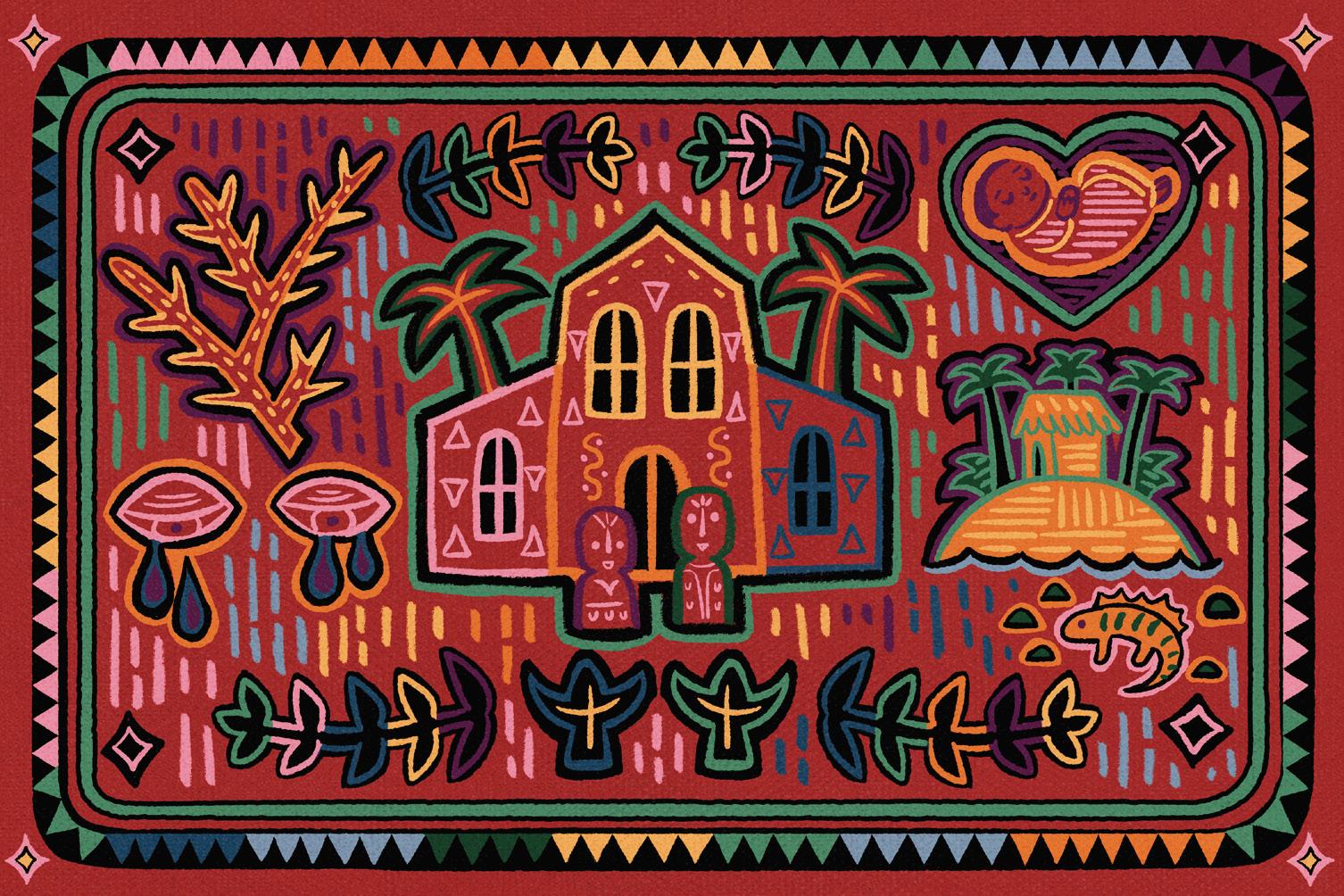 La
La
Content Creation Manager
Brown
Senior Developmental Editor: Eliz Tchakarian
Developmental Editors: Jennifer Anderson-Easthouse, Kelly Hass
Curriculum Coordinator: Helen Small
Editors: Isaily Perez, Sheila Cockey, Eileen Angelini
Cover Designer: Tawny Dougherty
Graphic Designers: Sawyer McCarron-Rutledge, Hannah Rowlett, Rivka Levin
Illustrator: Paula Zamudio
by Wayside Publishing
of this
may be reproduced, stored in a retrieval system, or transmitted in any form or by any means, electronic, mechanical, photocopying, recording, or otherwise, without the prior written permission of the publisher.
marks [EntreCulturas, Explorer, Learning Site, and Wayside Publishing] (collectively “the Marks”) are registered in the U.S. Patent and Trademark Office and owned in their entirety by Wayside Publishing (“Wayside”). Any use of the Marks without the express written permission of
Letter to Students
Dear students,
We hope you enjoy this reader, which has been written to be comprehensible to students by the end of a level 2 Spanish course. It includes many cognates, words that are similar in English and Spanish. All words are defined in the glossary at the end of the book. Chapter activities will help you explore the words and ideas in the story.
In today’s world, we all live around and among people and influences from a variety of cultures. As we live, learn, work, and play in our communities and abroad, we interact in person and online with people whose experiences and perspectives may be different from our own. The story in this reader will help you gain proficiency in Spanish and also learn about another culture that may not be familiar to you.
Thank you for your commitment to learning another language. We hope you embrace the opportunities that come to you as a Spanish speaker in a global community.
Sincerely, Ann Macari Healey and the Wayside Publishing® TeamAbout the Author
Ann Macari Healey is a Spanish teacher and award-winning journalist who lives in Colorado. Born in Panama, Ann grew up speaking Spanish and English while growing up in Honduras, Costa Rica, Colombia, and Mexico. She graduated with a journalism degree from the University of Florida and wrote for the Miami Herald and the Providence Journal, eventually owning, with her husband, a group of community newspapers in the metro area of Denver. She also taught high school Spanish and journalism in the Douglas County School District. Over the course of her career, Ann has won numerous national, regional, and state journalism awards as well as a lifetime teaching award for journalism.
As a writer and teacher, Ann loves how language learning and storytelling create a gateway to connect people and cultures. She is passionate about making language learning fun and relevant, and hopes her novel La mola misteriosa will spark readers’ curiosity to learn more about Latin American history and culture as well as improve their proficiency in Spanish.
For my mom.
Capítulo 1
Los objetos misteriosos
—¡Mira esta foto! —exclamó María José. Ella tenía en la mano una foto de Yaya, su bisabuela. Yaya era la mamá de la abuela de María José. En la foto, Yaya era joven. Ahora, Yaya tenía 90 años.
—¡Es una foto de Yaya con mi bisabuelo en el día de su matrimonio! —María José dijo—. ¡Qué bonita era! María José Rojas Montoya tenía 16 años. Vivía en Cartagena, Colombia con su familia: su mamá, su papá, su abuela Lita y su bisabuela Yaya. Era agosto, y la familia planeaba una celebración especial para el 91 cumpleaños de Yaya en octubre. María José y su abuela estaban buscando fotos de la vida de Yaya para exhibir en la fiesta. Estaban explorando tres cajas. Las cajas contenían fotos y objetos especiales de la vida de Yaya.
Para María José esto era muy interesante. Ella era muy curiosa. Le gustaba mucho investigar la historia de personas y objetos. A María José también le gustaba escribir. Cuando investigaba, documentaba la información con cuentos y fotos en su blog personal. Ella estaba muy emocionada con el proyecto para Yaya.
—¡Y esta foto! —exclamó María José.
En la foto, Lita y sus padres visitaban el océano. Lita era una niña en la foto.
—¿Dónde estaban, Lita? —María José le preguntó a su abuela.
Lita miró la foto y sonrió.
—Es Playa Blanca. ¿No la reconoces? Me encantaba visitar Playa Blanca. ¡Qué buena memoria!
En ese momento, ella exclamó:
—¡María José, mira!
En la caja había un objeto muy diferente. Era un panel de telas1 de muchos colores con figuras y diseños diferentes. Era como una pintura, pero de tela. Era muy, muy bonito. Era único.
—¿Qué es, Lita? —María José preguntó.
—Es una mola. Molas son artesanías2 de los indígenas guna3 de Panamá —dijo Lita—. ¿Por qué mi mamá tiene esta mola?
Lita era profesora de antropología en la Universidad de Cartagena. Ella sabía mucho de las culturas indígenas de Latinoamérica.
—Las molas tienen colores brillantes y diseños diferentes —explicó Lita.
María José tocó la mola.
—Los colores ya no son brillantes porque la mola es muy vieja —ella observó—. Pero es muy hermosa.
—A veces, las molas tienen diseños de pájaros y ranas — Lita dijo—. Pero el diseño de esta mola es más complicado. ¡Qué interesante!
María José miró el diseño. Había muchas figuras misteriosas. Había una iglesia con dos personas. Había
panel de telas fabric panel
artesanias
los indígenas guna the Guna indigenous people
Los objetos misteriosos
palmeras4. También había un palo sin hojas5, un bebé dentro de un corazón, una choza6 en una isla y dos ojos que lloraban. ¿Eran símbolos?
—Es un misterio —María José dijo.
Con la mola había un papel. Era un papel muy viejo. Lita miró el papel. ¿Qué era?
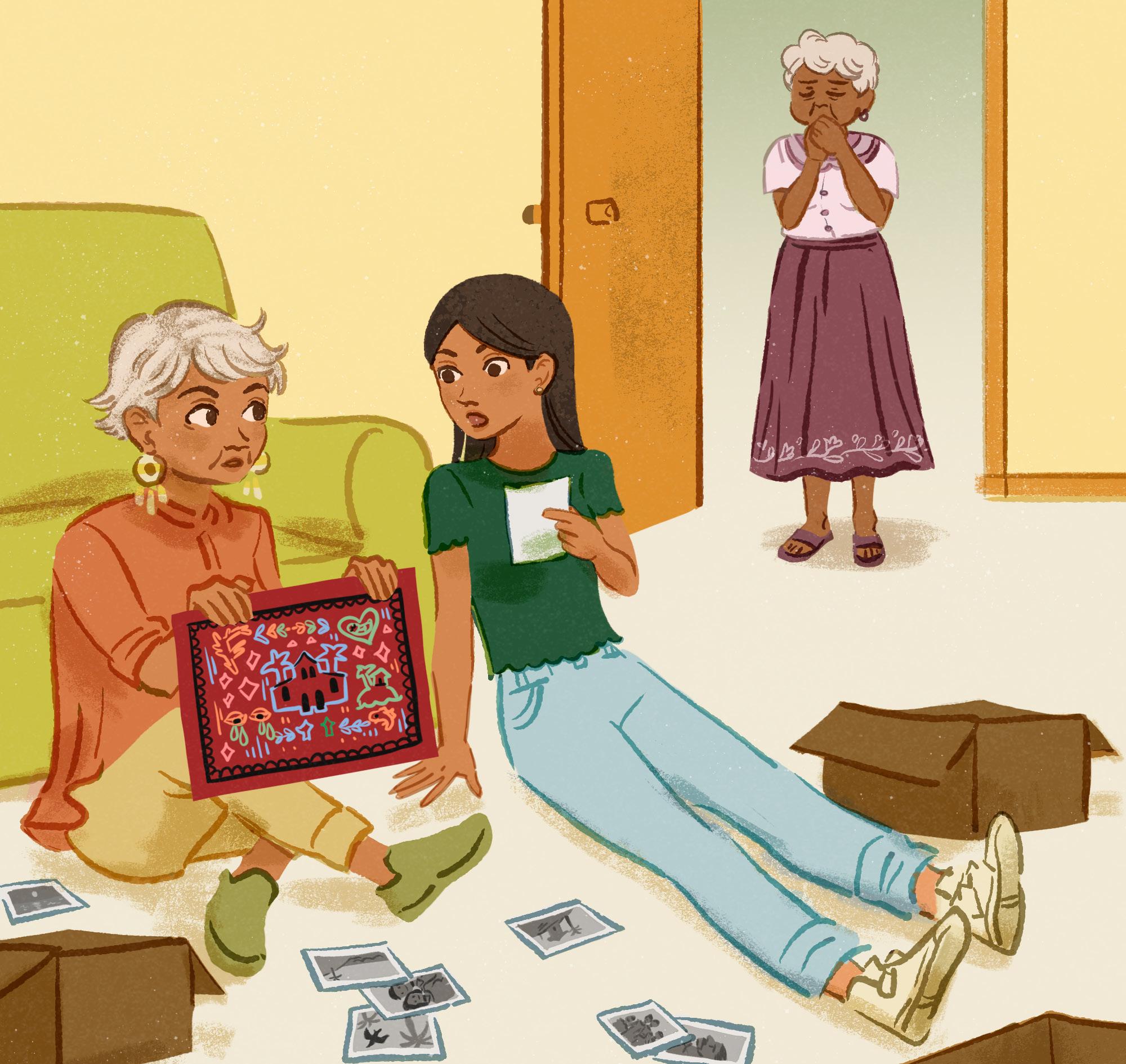
De repente, una voz habló muy bajo:
—Sí, es un misterio, pero también es un secreto. Era la voz de Yaya.
4palmeras palm trees
5palo sin hojas stick or branch without leaves
6choza hut, a home with a thatched roof
—¿Es un secreto? ¿Qué es un secreto, Yaya? —le preguntó María José—. ¿El papel es un secreto o la mola es un secreto?
—Los dos —Yaya dijo— son mi gran secreto. Y Yaya empezó a llorar.
Capítulo 2
La carta del pasado
—¡Mamá! ¿Por qué lloras? —Lita le preguntó a Yaya. María José se levantó1 rápidamente y abrazó a su bisabuela. —Vamos, Yaya. Nos sentamos en el sofá —dijo María José. —Yo no soy originalmente de Colombia —Yaya dijo—. Soy de las Islas San Blas de Panamá. Esta mola es típica de la cultura de San Blas.
Ella continuó. Su voz tenía un temblor. Lita puso su mano encima de la mano de Yaya.
—También —dijo Yaya—, yo soy adoptada.
Lita abrió los ojos muy grandes. Era información nueva.
—Mamá, ¿por qué no … ?
Yaya tocó el papel y dijo:
—Esta carta explica todo. Mi madre adoptiva me dio2 esta carta antes de morir3 en el año 2000. La carta es de mi madre biológica.
Lita y María José empezaron a leer.
—¡Mamá! —Lita exclamó—. ¡La carta es del día de tu cumpleaños!
se levantó stood up
me dio gave to me
antes de morir before dying
27 de octubre de 1930
Querida hija:
Tú papá y yo estamos muy felices. Eres hermosa. Te queremos con todo el corazón. Pero también estamos muy tristes, porque tú no puedes vivir con nosotros en Palo Seco. Y nosotros no podemos vivir fuera de Palo Seco. Solo las personas con la enfermedad4 pueden vivir aquí. Son las reglas.
Hay una enfermera5 que trabaja en Palo Seco. Ella se llama Marta Gonzalo. Somos amigas. Ella tiene un corazón muy bueno. Ella y su esposo no tienen hijos. Van a regresar a Colombia, donde viven sus familias. Ellos te quieren adoptar. Estamos muy, muy tristes pero tú vas a ser más feliz y puedes tener una vida mejor.
Un día, Marta te va a dar esta carta y la mola que describe la historia de nuestra familia. Somos de las Islas San Blas. Busca a tu familia algún día.
Hijita, tú papá y yo te queremos mucho. Tus padres, Nele y Santiago Arango
—¿Qué es Palo Seco? —preguntó María José.
—¿Y qué enfermedad? —preguntó Lita. Yaya no sabía qué decir. Entonces, María José saltó6 del sofá. Estaba emocionada.
—Lita, ¡tenemos que encontrar a la familia biológica de Yaya! —ella exclamó—. Tú eres profesora de cultura indígena. Puedes estudiar la mola para obtener más
La carta del pasado
información. Yo puedo investigar Palo Seco y documentar la investigación en mi blog.
Lita miró a su mamá y sonrió.
—No llores, mamá —Lita le dijo—. Vamos a encontrar a tu familia.

Yaya sonrió también. Estaba feliz. María José exclamó con entusiasmo:
—¡Va a ser una gran aventura!
Glosario
f. - feminine irreg. - irregular verb m. - masculine pl. - plural refl. - reflexive verb
Stem-changing verbs are indicated in the glossary as follows: e→ie: like pensar (pienso, pensaba) e→i: like decir (digo, dice), seguir (sigo) o→ue: like poder (puedo, puedes) o→ue/u: like dormir (duermo)
An asterisk (*) next to the word indicates a cognate, a word that has a similar meaning and spelling in both Spanish and English.
A a, al to abandonado* abandoned abordar* to board abordó* boarded abordaron* they boarded abrazar to embrace or hug abrazó hugged abrir to open abrió opened absolutamente* absolutely la abuela grandmother acercaron came closer adiós goodbye adoptado/a* adopted adoptivo/a* adoptive, describing someone who adopts a child los adultos* adults
el aeropuerto* airport afuera out, outside agarrar to grab, to grasp ¡Agarra fuerte la cuerda! Grab the rope firmly! la agencia* agency agosto* August ah* ah aisladas isolated el agua water ahora now el álbum* álbum algo something algún, algunas/os some, any, a few allí there alrededor around se amaban they loved each other amable amiable, friendly, nice los amigos friends el amor love anaranjado/a orange (color) los ángeles* angels el anillo ring el/los año/s year/s antes before la antropología* anthropology los apartamentos* apartments (pl.) aprender to learn aprendemos we learn apuntando a pointing at or toward something aquí here el árbol tree arriba up
La mola misteriosa
las artesanías handicrafts (pl.) el artículo* news article así so la atención* attention aún even (though) el autobús* bus la aventura* adventure el avión airplane ay* oh la ayuda help, assistance ¡Ayúdame! Help me! azul blue B los bailes dances baja short or low el bambú* bamboo el/la bebé* baby bien good, well bienvenidos welcome biológica* biological el/la bisabuela great-grandmother el bisnieto/s great-grandson/great-grandchildren blanco/a white el blog* blog la blusa* blouse bonito/a pretty brillante* brilliant buen, buena/s, bueno/s good buenas tardes good afternoon busca searches, looks for buscamos we search, we are looking for
buscando searching, looking for buscar to search, to look for buscó searched, looked for C la caja box calmaron* they calmed down el calor heat la cama bed caminando walking caminar to walk caminaron they walked caminó walked camino I walk las camisas shirts la canoa* canoe canoso/a gray or salt-and-pepper (hair) cansado/a tired cantaba sang cantaban sang el/la capitán* captain la cara face el Caribe* Caribbean la carne meat la carretera highway el carro* car la carta letter
Cartagena* Cartagena, a city in Colombia la casa house se casaron they got married la celebración* celebration el celular* cellphone
La mola misteriosa
el cementerio* cemetery la cena dinner cerca nearby cerró closed chévere cool, awesome la choza hut, a home made of natural materials el cielo sky cinco five los círculos* circles la ciudad city la Ciudad de Panamá Panama City, the capital city of Panama la clase* class el club* club la cocina kitchen el código* code el collar de cuentas necklace of beads Colombia* Colombia colombiana* Colombian los colores* colores el comedor dining room comer to eat comían they ate la comida food como like, as cómo how el compartimento* compartment compartir to share complicado/a* complicated comprendo* I understand, I comprehend la computadora* computer la comunidad* community
con with conocer to know contagioso/a contagious contenían* they contained contento/a* content contiene* contains contigo with you continuaba* continued construido/a* constructed continuaron* they continued continuó* continued las conversaciones* conversations el corazón heart (m.) correcto/a* correct corto/a short las cosas things la costa* coast creativo/a* creative cristiana/o* Christian las cruces crosses cuando when la cuarentena* quarantine el cuarto room las cuentas beads el cuento story curar* to cure curioso/a* curious la cuerda rope, cord la cultura* culture el cumpleaños birthday
Ddar to give de, del of debajo beneath, below deciden* they decide decidir* to decide decidieron* decided decidió* decided decir (e i) to say decía said (from decir) decían they said (from decir) la decisión* decision dentro de in, inside describe* describe describía* described describían* they described desembarcaron* disembarked desesperadamente* desperately desolada* desolate, empty despacio slow después after detrás (de) behind el día* day (m.) diaria* daily dicen they say (from decir) dieron gave (from dar) diez ten diferente* different difícil* difficult dijo said (from decir) dijeron they said me dio gave me (from dar)
La mola misteriosa
el diseño* design la distancia* distance el doctor* doctor los doctores* doctors documentar* to document something documentaba* documented documentaban* they documented documentando* documenting dónde where donde where dormir (o ue) to sleep dos two durante* during se durmieron they fell asleep (from dormir) (refl.)
E
e and (used instead of y before words starting with i) los efectos* effects él, ella he, she el the el elote (ear of) corn ellos they la emoción* emotion emocionada* emotional, excited empezar (e ie) to begin empezaron they began empezó began empiezan they begin en* in, on me encantaba I loved, greatly enjoyed le encantó loved, greatly enjoyed encima (de) on top (of)
La mola misteriosa
encontrar* (o ue) to find or encounter encontró* found se enfermó* became ill se enfermaron* they became ill enfermas* ill, sick la enfermedad illness el/la enfermero/a* nurse el enigma* enigma, puzzle (m.) enojado/a angry entonces then entra* enter entre between entró* entered el entusiasmo* enthusiasm era was eran were eres (you) are es is esa, ese, eso that escribir to write escribió wrote escribieron they wrote el escritorio desk en línea* online escuchó listened la escuela school esos those el español Spanish language especial* special espectacular* spectacular el/la esposo/a* spouse esta, este, esto this
estar (irreg.) to be está is estaba was estaban were estamos we are están they are estás you are estoy I am estoy lista I am ready el/la estudiante* student estudiar* to study los eventos* events exactamente* exactly excelente* excellent exclamó* exclaimed las excursiones* excursions, tours exhibir* to exhibit existen* they exist explica* explains explicaba* explained explicaron* they explained explicó* explained explicamos* we explain explican* they explain explorando* exploring
F la familia* family la falda skirt fantástica* fantastic favorito/a* favorite feliz, felices happy
La mola misteriosa
la felicidad* happiness felizmente happily la fiesta party las figuras* figures el fin end el final* final, last finalmente* finally formó* formed las flores flowers (pl.) la foto* photo (from fotografía, f.) frío/a cold las frutas* fruits (pl.) fue went (from ir) fueron they went fuera de outside of, away from fuerte strong fuertemente with strength, forcefully G generoso* generous el gobierno* government grabó recorded (audio/video) gracias thanks gracias a Dios thanks to God gracioso funny, humorous gran, grande, grandes* big grandísima/o very big gris gray gritando shouting, yelling gritaron they shouted, they yelled gritó shouted, yelled
los guna Guna people (also spelled Kuna), a group of people native to areas of Panama and Colombia le gustaba liked me gustan I like H había there was, there were hablar to say hablaban they said hablaron they said hace buen tiempo it’s nice weather hacia towards in the direction of hacía sol y calor it was sunny and hot hay there is, there are el hermano brother hermoso/a beautiful la hijo/a son/daughter/child la hijita little daughter la historia* history, story las hojas leaves hola hello el hombre man la hora* hour el hospital* hospital hoy today I iba a, iban a went (from ir) la idea* idea la idioma language la iglesia church la iguana* iguana
La mola misteriosa
me imagino* I imagine importante* important imposible* impossible inclinaba* inclined, leaned, tipped incluyendo* including increíble* incredible los indígenas* indigenous people: the people native to a region or place la información* information infrecuentemente* infrequently insistió* insisted inspeccionar* to inspect, inspecting intacto/a* intact, remaining untouched or unchanged over time el internet* internet interesante* interesting interrumpió* interrupted introdujo* introduced la investigación* investigation investigar* to investigate investigaba* investigated investigaban* they investigated invitó* invited ir (irreg.) to go la isla* island
J joven young jugaban they played la jungla* jungle junto/a together juntos together (pl.)
los kilómetros* kilometers
L la, las the el lado side de lado a lado from side to side las lágrimas tears
Latinoamérica* Latin America le, les to a person, to them leal loyal leer to read el león* lion la lepra leprosy se levantó stood up leyó read (past of leer) leyendo reading el libro book los líderes* leaders las líneas* lines listo/a ready se llama is called, is named me llamo my name is llegó arrived llegaron they arrived llevaba wore, carried llevaban they wore, they carried llorar to cry lloras you cry No llores. Don’t cry. lloró cried lloraban they cried
La mola misteriosa
la lluvia rain el lugar place la luna moon el lunes Monday M la madre mother magnífico/a* magnificent las maletas suitcases la mamá* mom mami* mommy mañana tomorrow las manos hands el mapa* map (m.) el mar the sea (m.) el mar Caribe the Caribbean Sea (m.) marcaban marked el marco frame más more el matrimonio* matrimony, marriage la mayoría* majority las medicinas* medicines el mejor better, best los mejores amigos best friends la memoria* memory mencionaron* they mentioned menor younger menos* fewer el mes month (m.) la mesa table mi, mis my el miedo fear
los miembros* members mientras while, meanwhile los minutos* minutes ¡Mira! Look! miraron they looked miras you look miró looked el misterio* mystery misterioso/a* mysterious la mochila backpack la mola a traditional art form of the Guna people of San Blas, molas are brightly colored fabric panels decorated with intricate needlework designs el momento* moment morena dark-complected morir (o ue/u) to die murieron they died (from morir) mucho/a* a lot of, many, much el muelle wharf, pier, dock la mujer woman murmuró* murmured la música* music muy very N nací I was born nada nothing nadaban they swam nadie nobody, no one la nariz nose la naturaleza* nature navegar* to navigate
La mola misteriosa
navegaba* navigated navegó* navigated necesario* necessary necesita needs necesito I need negro/a black la neumonia* pneumonia, a serious lung infection la nevera cooler for food and drinks la niña girl los niños children no* no la noche night el nombre name el norte* north nos to us nosotros/as we las notas* notes notó* noted, noticed nuestra/o our nuevo/a new nueve nine los números* numbers nunca never O o or obedecer* to obey los objetos* objects observó* observed obtener* (e ie) obtained obvio/a* obvious ocho eight
el océano* ocean octubre* October ocurría* occurred oficialmente* officially la oficina* office oh* oh oía heard (from oír) los ojos eyes la opción* option, choice originalmente* originally otro/a other oyó heard P el/la paciente* patient (medical) Pacífico* Pacific (Ocean)
los padres parents los pájaros birds las palmeras* palm trees palo stick, branch Palo Seco former location of a community and hospital for leprosy patients in Panama, literally “dry stick”
Panamá Panama el panel de telas fabric panel los pantalones* pants el pañuelo headscarf el papá* dad las papas potatoes el papel* paper papi* daddy para for, in order to el párrafo* paragraph
La mola misteriosa
las partes* parts el pasado* past pasar* pass pasó* passed los peces fish las películas movies el peligro danger peligroso/a dangerous el pelo hair el pelo canoso gray or salt-and-pepper hair pensaba thought pensando thinking pensar (i ie) to think pensó thought pequeño/a small perfecta/o* perfect perfectamente perfectly el periódico* newspaper periodismo journalism el/la periodista journalist permanente* permanent pero but, however el pescado fish (food) los personajes characters personal* personal las personas* people, persons pienso I think la pintura* painting el/los plan/es* plan planear* to plan planeaba* planned las plantas* plants
los plátanos* bananas, plantains la playa beach un poco a little podemos we can, are able to poder (o ue) to be able to, to can podía was able to, could podían were able to, could ponerse to get, to become (refl.) se ponía became (from ponerse) (refl.) populares* popular por by, for por favor please porque because por qué why posible* possible preguntó asked preocupado/a* worried preparado/a* prepared el presente* present time prevenir (e ie) to prevent las primas (f.) cousins primero/a first principal* principal, main el/la profesor/a* teacher, professor la proposición* proposition el proyecto* project publicar* to publish pueden are able to, they can (from poder) puedes are able to, you can puedo I am able to, I can el puerco* pork la puerta door
La mola misteriosa
el puerto* port pues well se puso became (from ponerse) (refl.)
Q que that qué what ¡Qué chévere! How cool! ¿Qué tal si … ? How about if … ? ¡Qué rico! Yum! Delicious! queremos we want quería wanted querían they wanted quieren they want quiero I want querida dear quién who R las ranas frogs rápidamente* rapidly, quickly recibimos* (we) receive reconoces* you recognize recordar (o ue) to remember refrescante refreshing el regalo gift las reglas rules regresar to return rentó* rented de repente suddenly representan* they represent
el rescate rescue resolver* (o ue) resolve, solve respondió* responded el resto* the rest, the others se reunía* gathered la reunión* reunion, gathering rico/a* delicious, tasty rieron laughed (from reír) rojo red el ruido noise las ruinas* ruins
S sabe knows saben they know sabía knew sabían they knew sacó took out salen they go out, leave salieron they went out salió went out, left el salón de clase classroom saltó jumped, leaped up las islas San Blas* the San Blas Archipelago, a group of islands off the coast of Panama el sancocho typical Colombian soup with a little bit of everything (un poco de todo)
el secreto* secret segundo* second al segundo día on the second day la semana week
el sendero footpath el señor mister, man nos sentamos let’s sit separado* separate ser (irreg.) to be sería it would be (from ser) sí yes si if siempre always la siesta nap siete seven el silencio* silence la silla chair los símbolos* symbols similar* similar, alike sin without la situación* situation sobre about los sobrinos nieces and nephews el sofá* sofa, couch el sol sun solamente only solitario/a* solitary, alone solo/a* alone el sombrero hat somos we are (from ser) son they are (from ser) sonrieron they smiled sonrió smiled la sonrisa smile la sopa* soup
La mola misteriosa
soy I am (from ser) su, sus their suave soft T tal such tan so tan temprano so early también also, too la tarde afternoon Tarzán Tarzan, a famous character from literature and movies te dieron they gave you te queremos we love you te quieren they love you la tela cloth, fabric el teléfono* telephone temblaba trembled temblando trembling el temblor tremor temprano early tenemos we have (from tener) tener (e ie) to have tener miedo to be afraid tengo I have tenía had tenían they had tiene has tienen they have tienes you have terminó* terminated, ended
La mola misteriosa
ti to you el tiempo time, weather las tiendas shops, stores el/la tío/a uncle, aunt típico/a* typical el tipo* type tocó touched, knocked toda/o, todas/os all tomar to take tomó took la tormenta storm trabaja work la tradición* tradition tradicional* traditional el tráfico* traffic la tragedia* tragedy trágica/o* tragic tranquilo/a* tranquil, calm tres three triste sad tristemente sadly la tristeza sadness tú you tu/s your la tumba* tomb turbulento/a turbulent turístico/a* touristic U u or (used instead of y before words starting with o) un/una one, a, an
unas/unos some, a few único/a* unique unido/a* united la universidad* university uno one la urgencia* urgency con urgencia* with urgency, urgently usted you (formal) ustedes you (plural) uy oh
V va goes las vacaciones* vacation vamos (we) go, let’s go van they go vas (you) go a veces sometimes veían they saw la vela sail, as on a sailboat el velero sailboat vemos we see (from ver) vengo I come ver (irreg.) to see vio saw vieron they saw verde green la vez time, instance esta vez this time otra vez another time, again el viaje* voyage la vida life
La mola misteriosa
el video* video vieja/o old el viento wind visitaban* they visited visitar* to visit vivan they live viven they live viví I lived vivía lived vivían they lived viviendo living vivir to live voy I go la voz* voice Y y and ya already yo I la yuca* yuca, a root vegetable similar to a potato Z las zanahorias carrots
